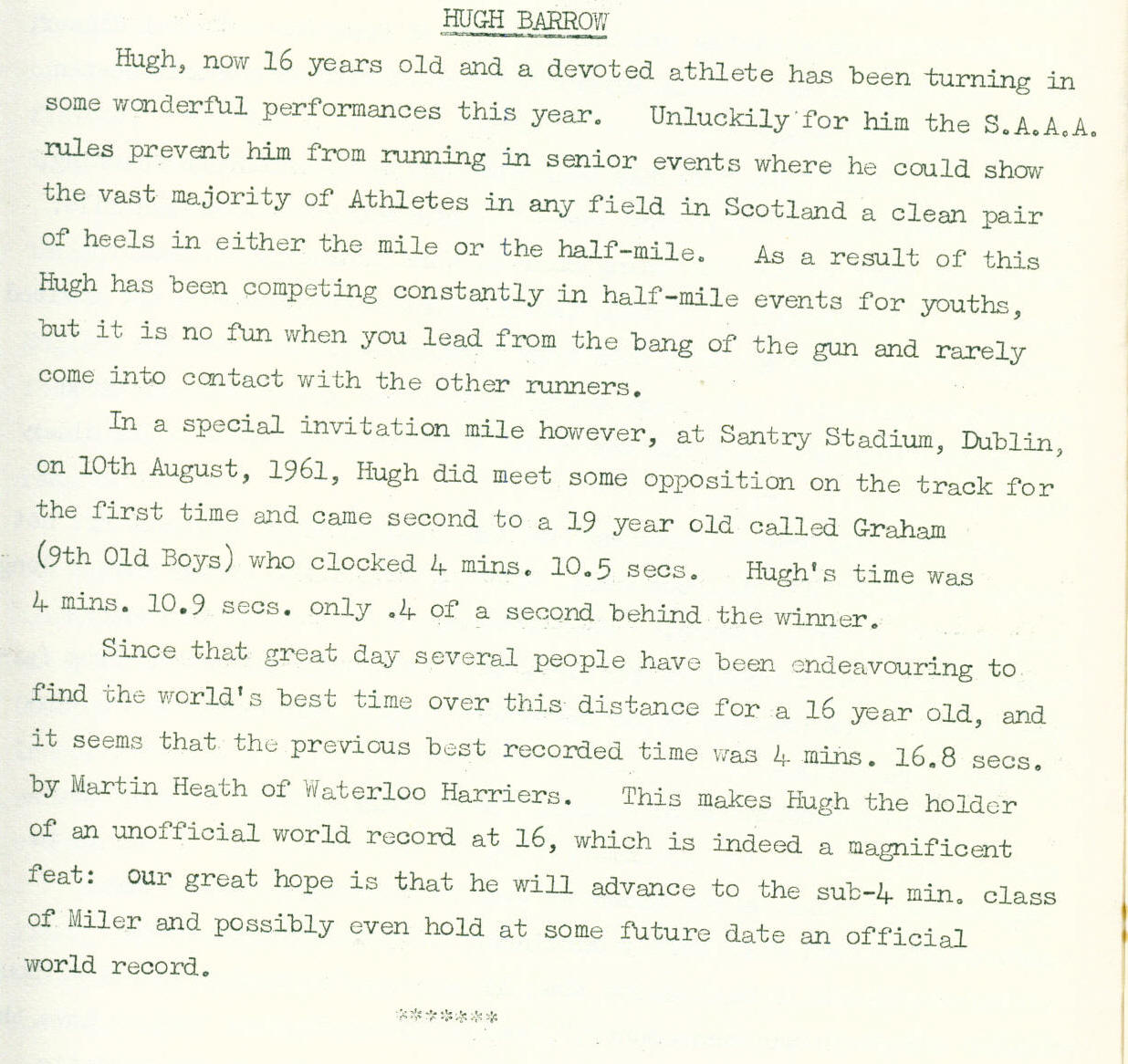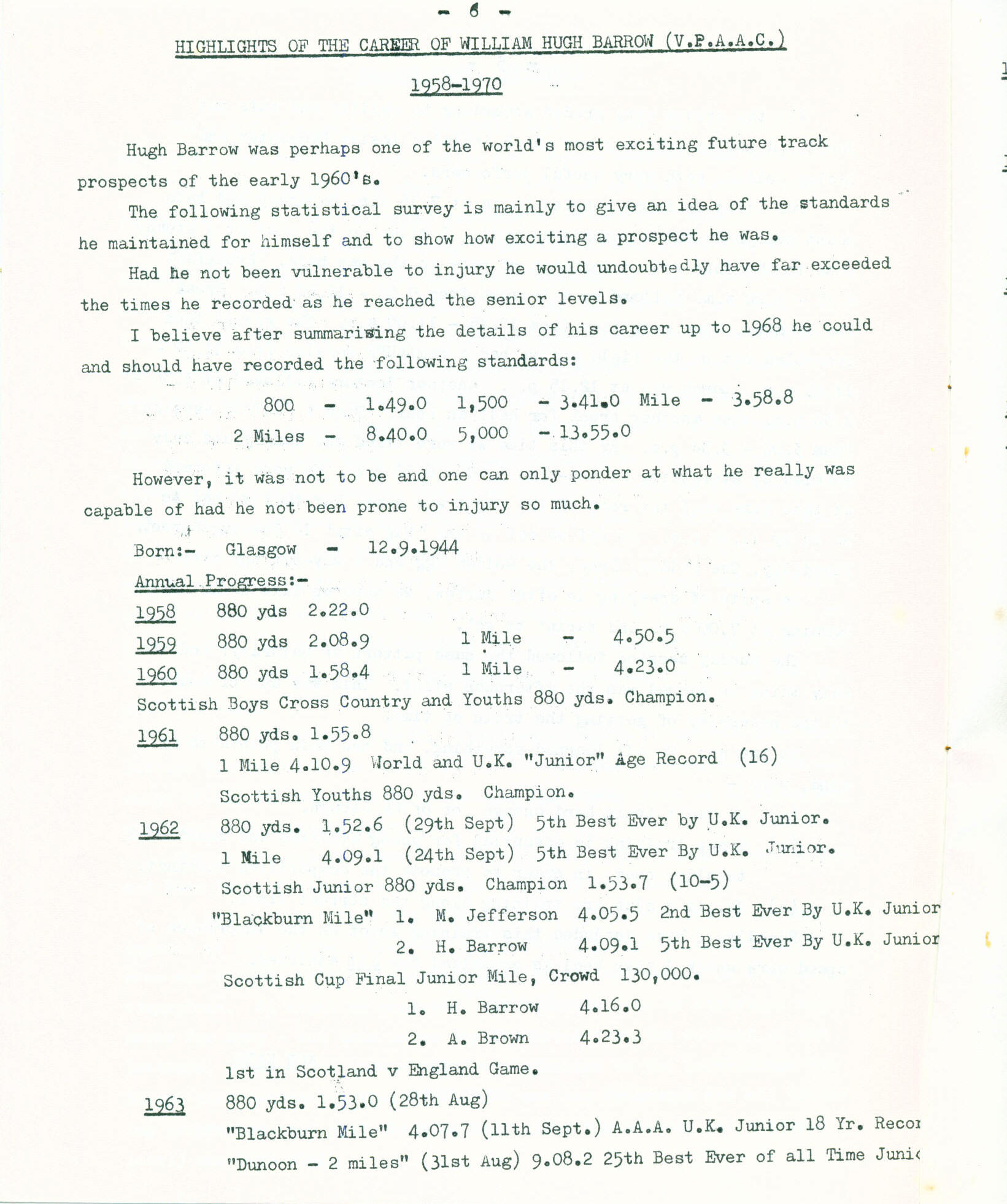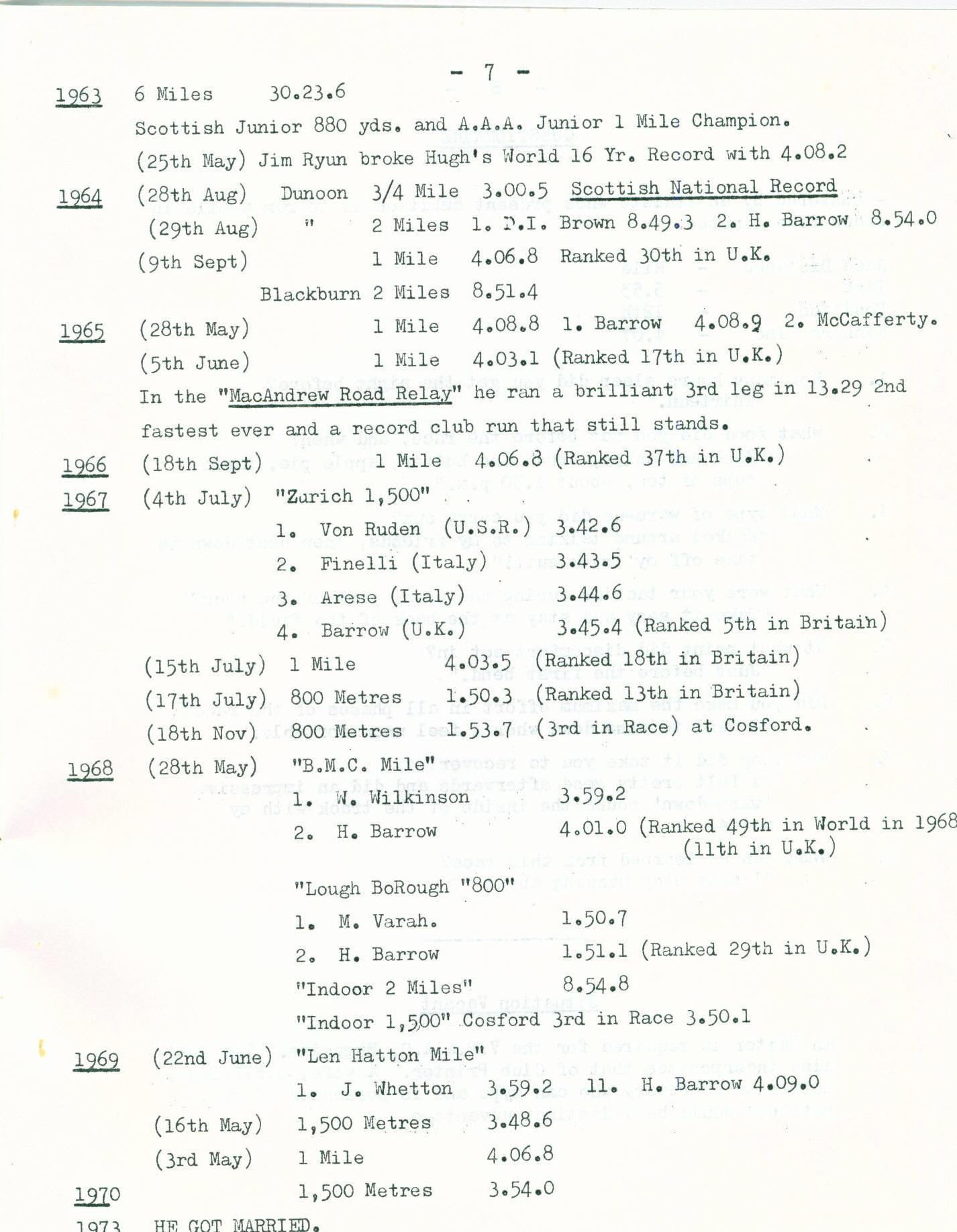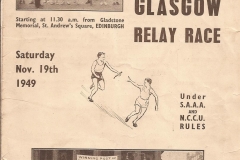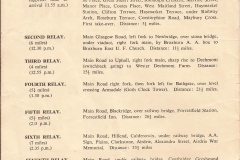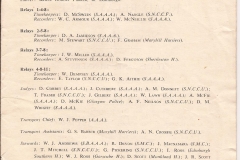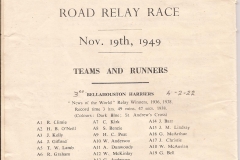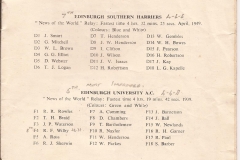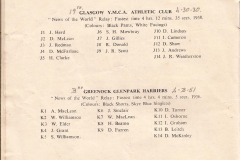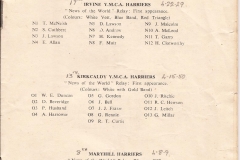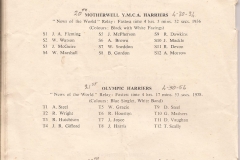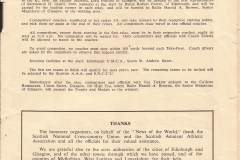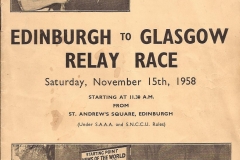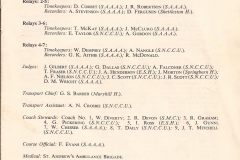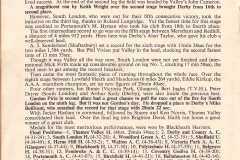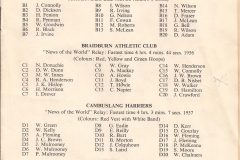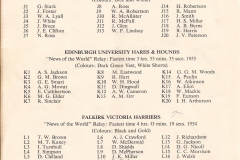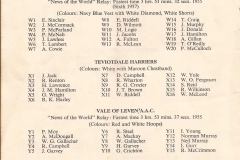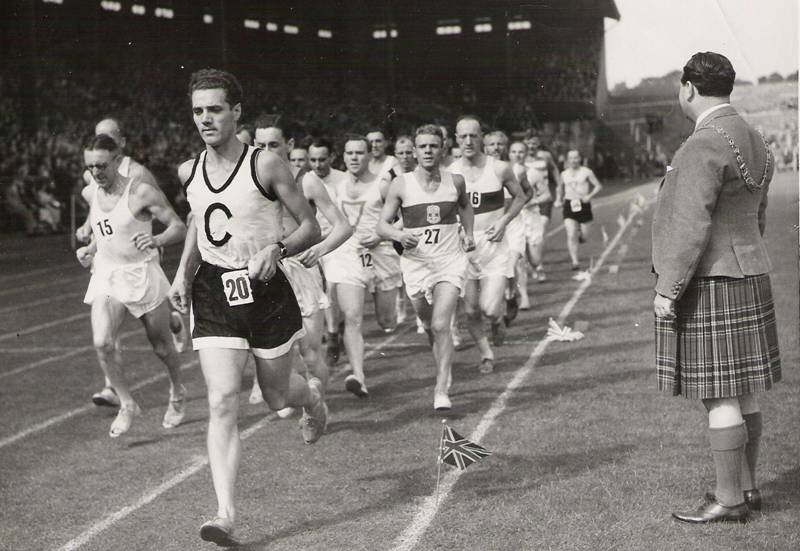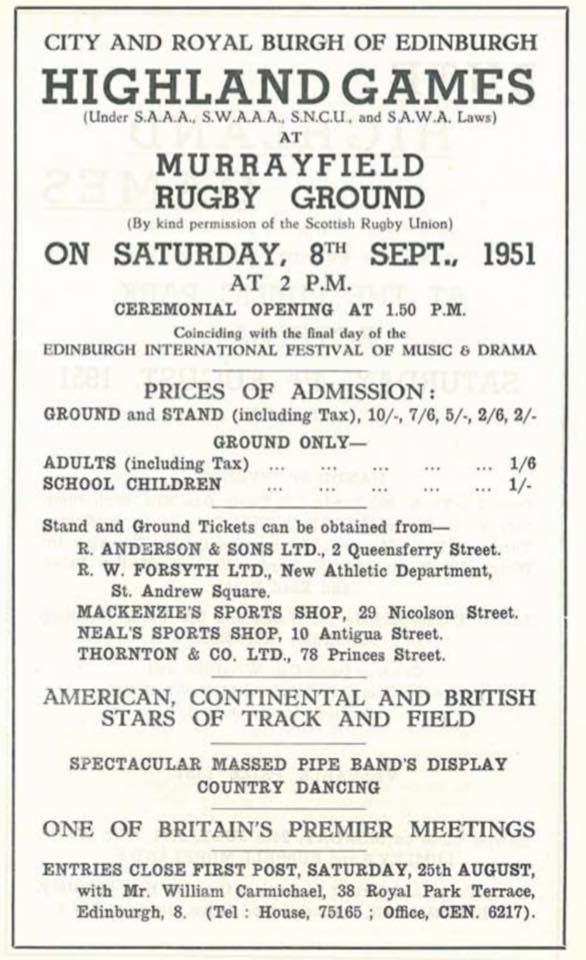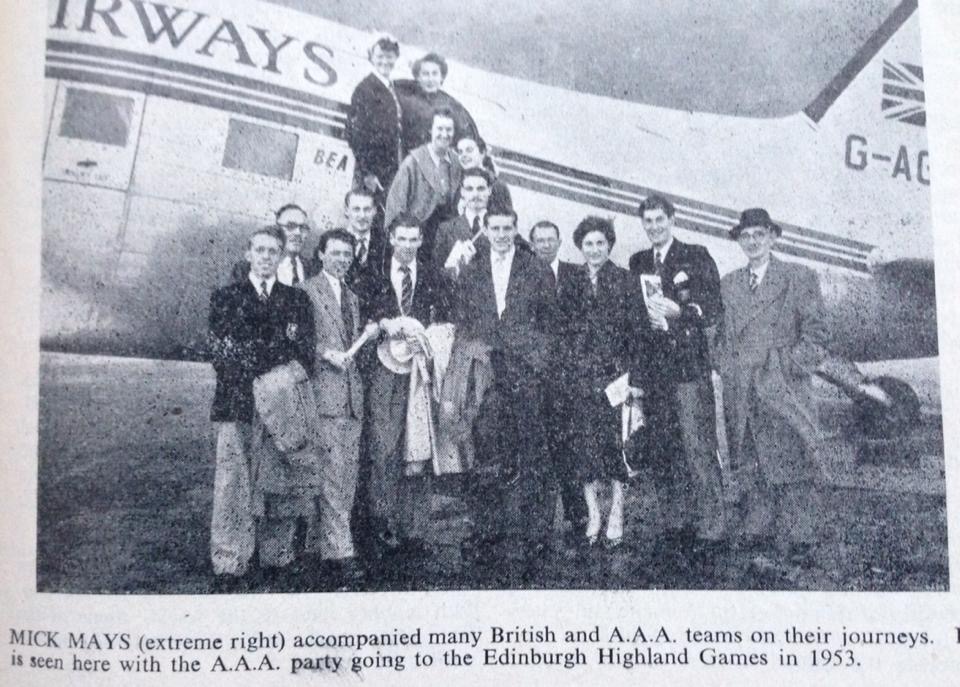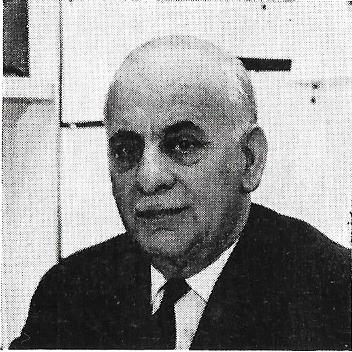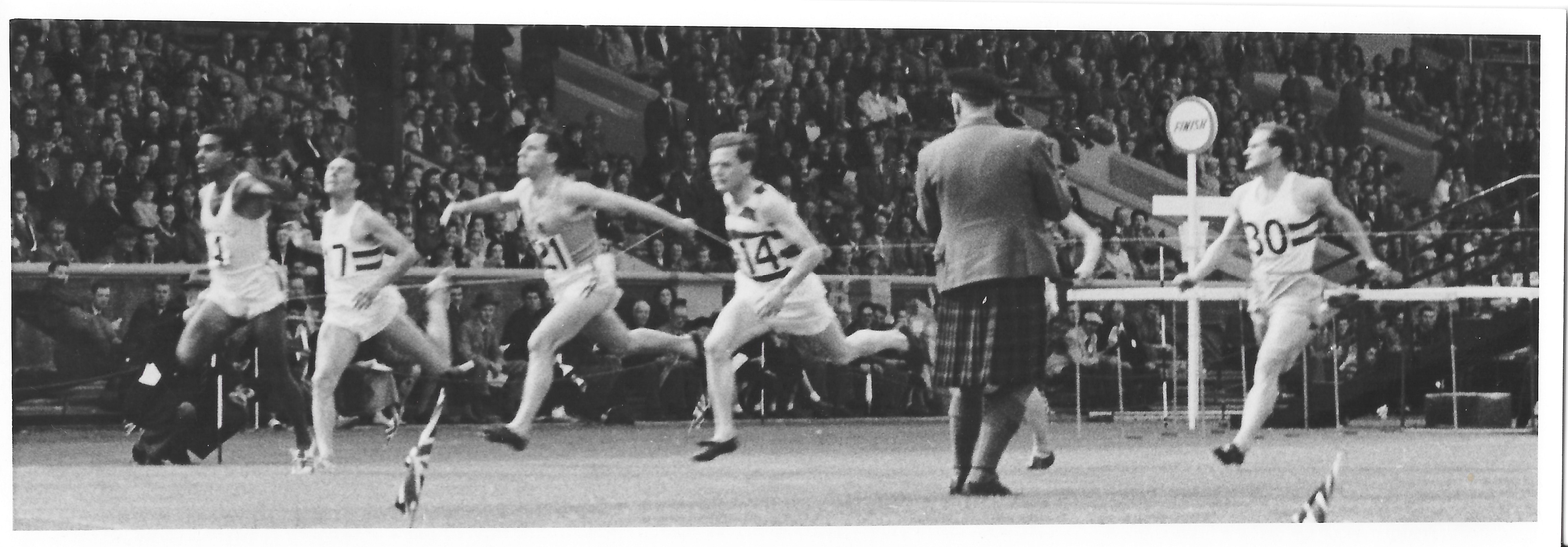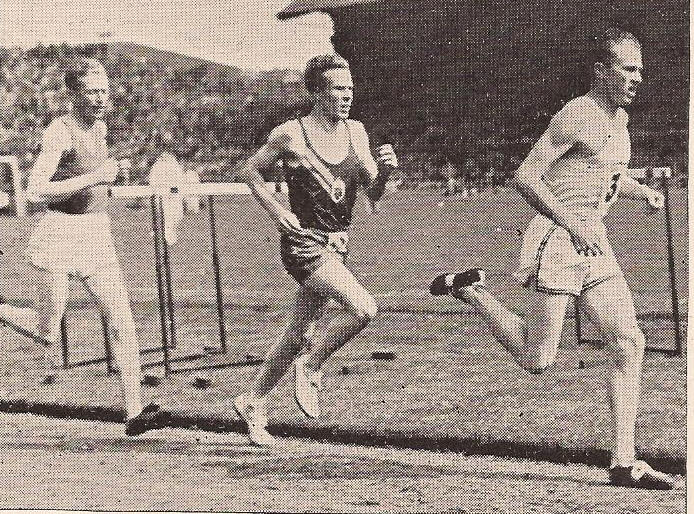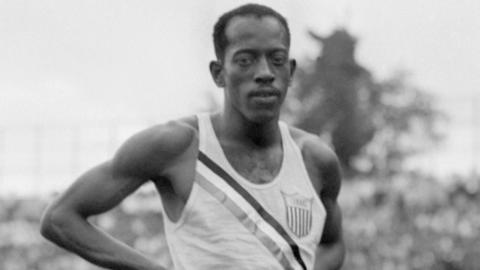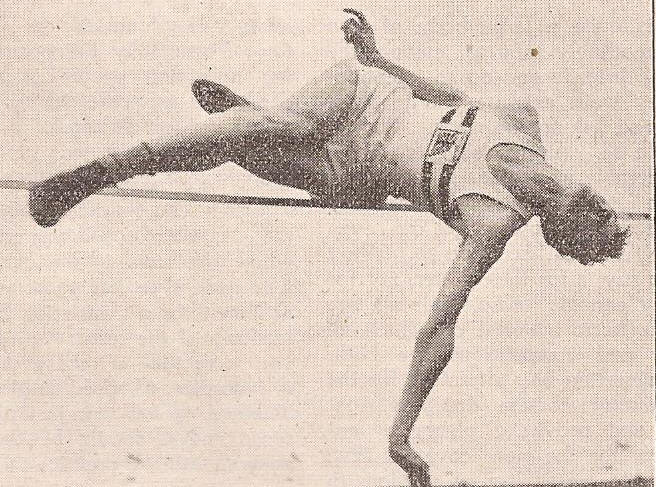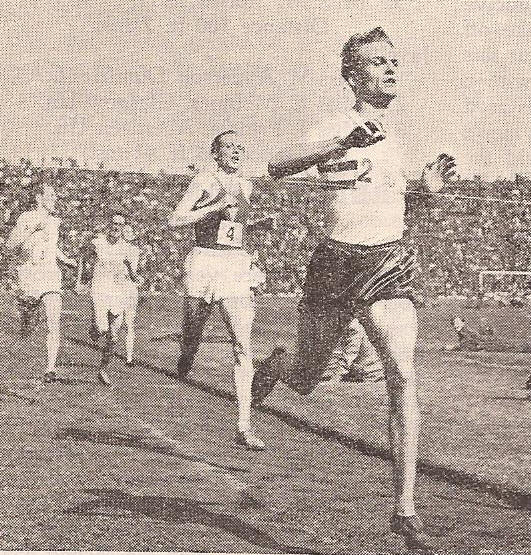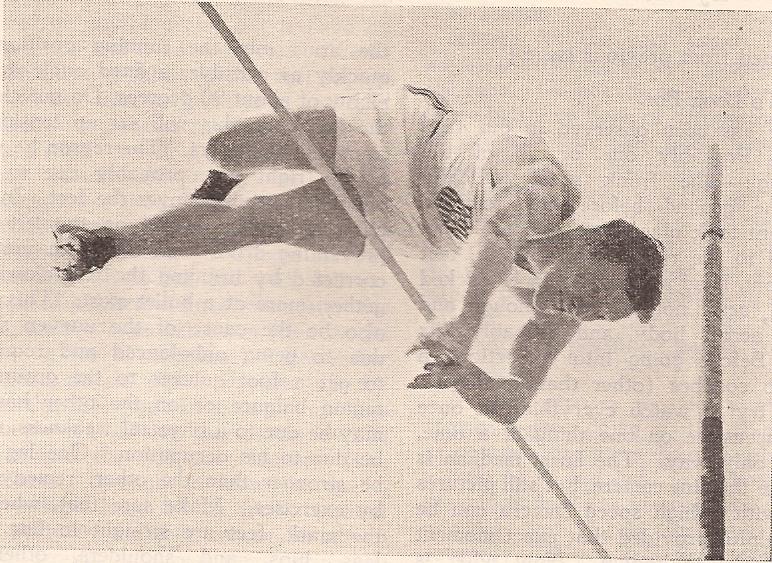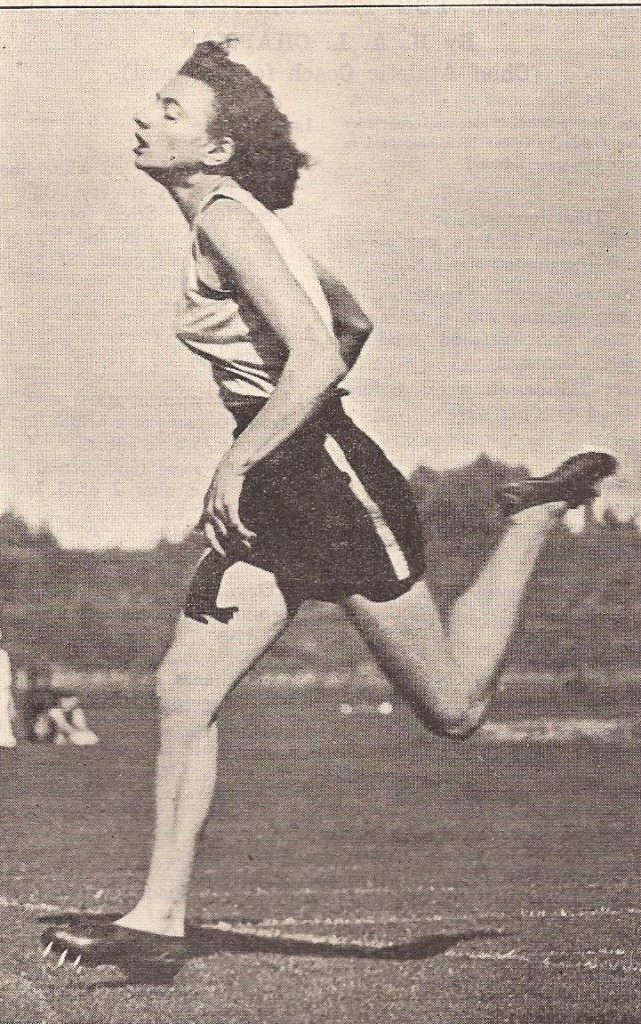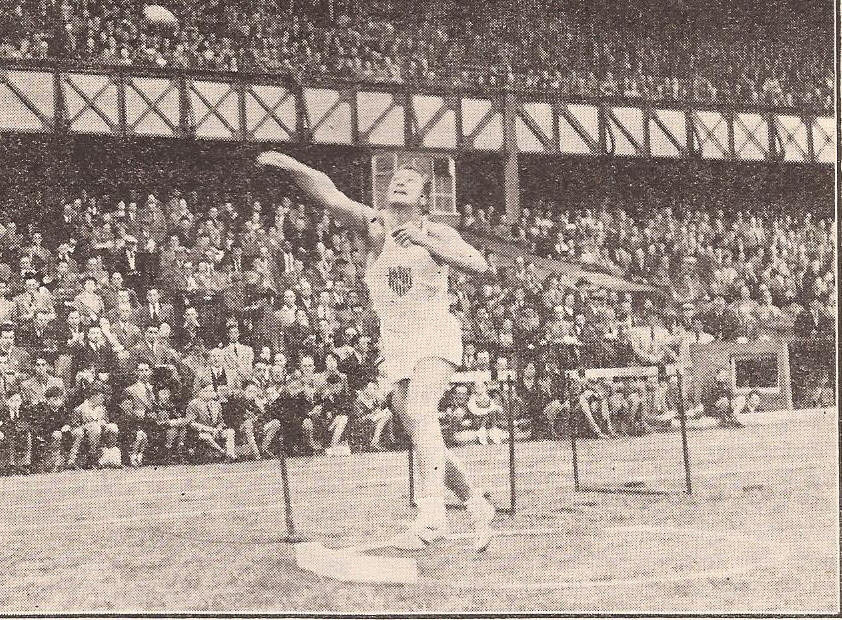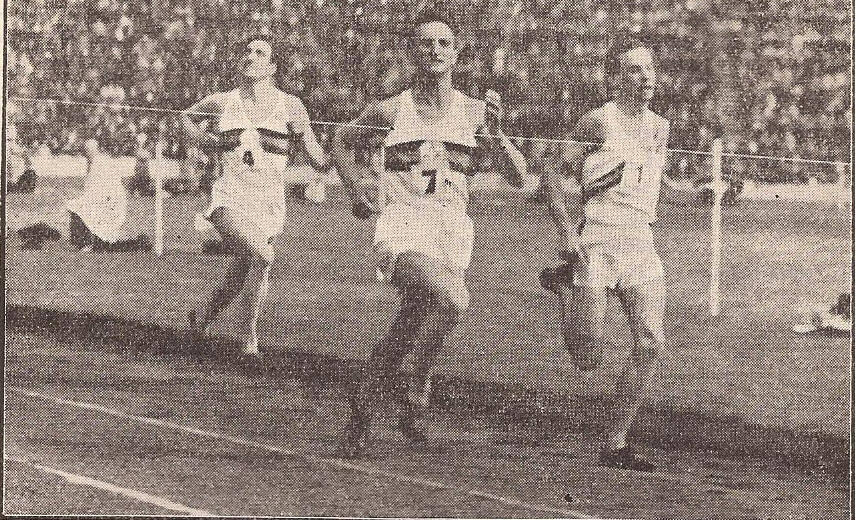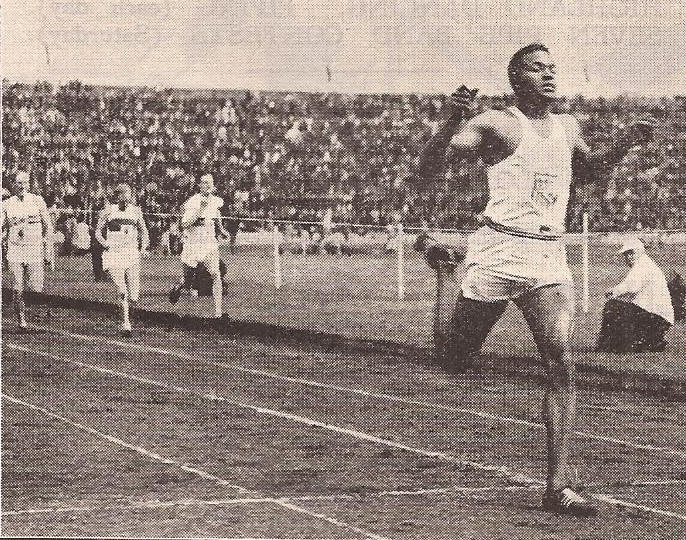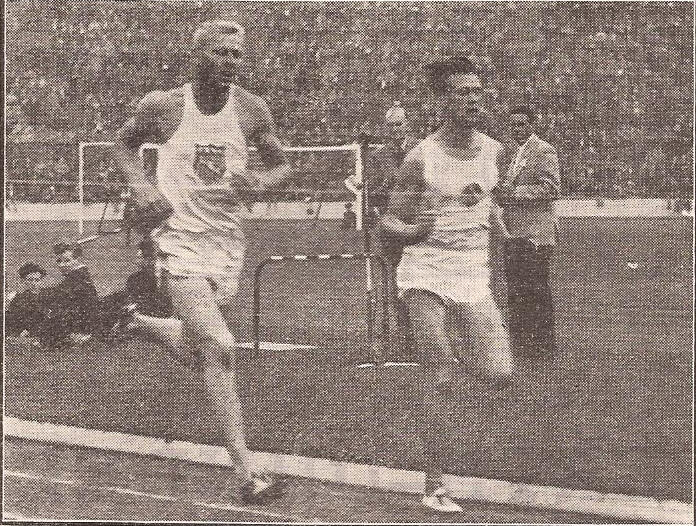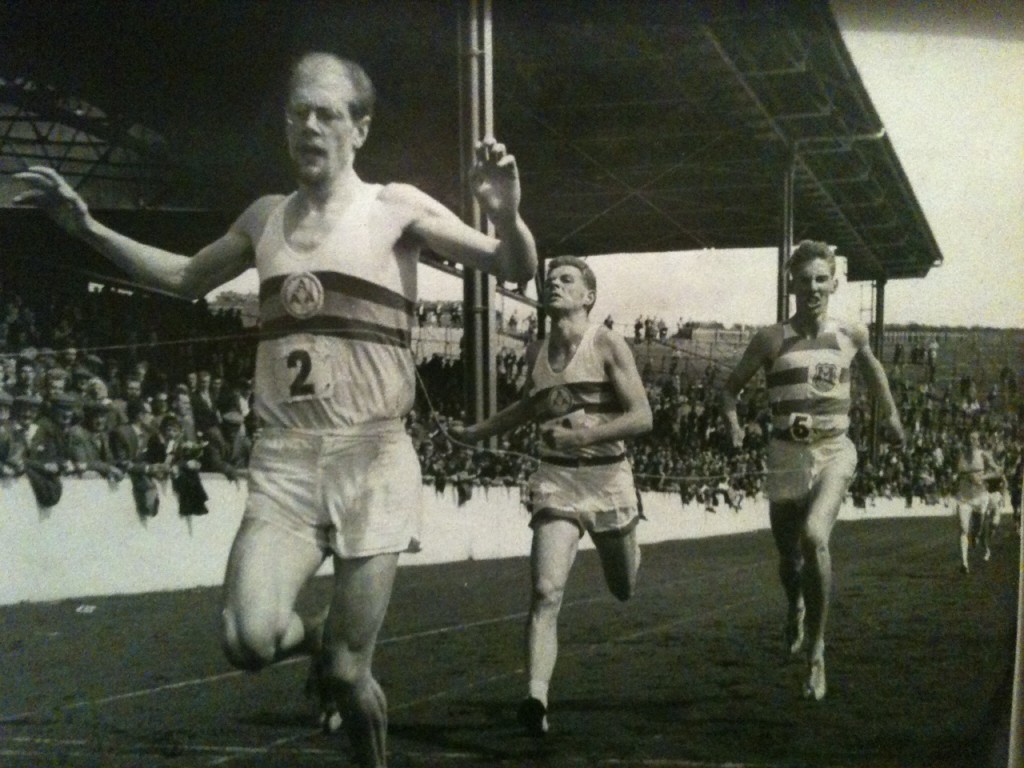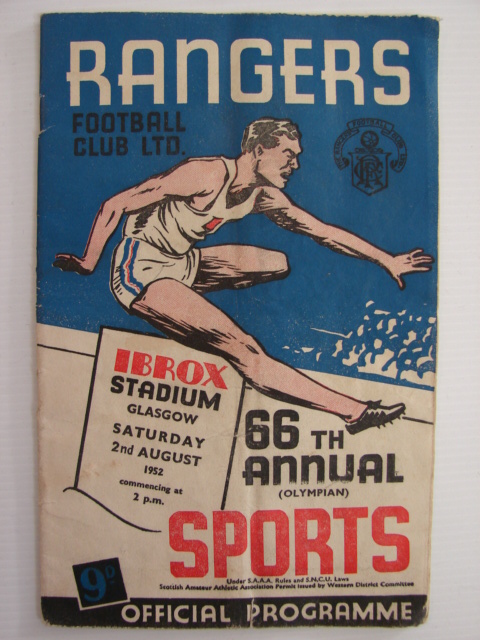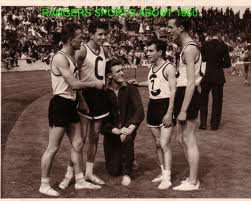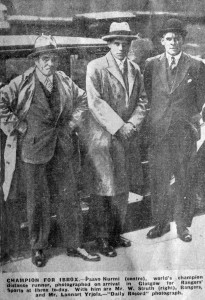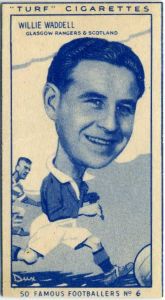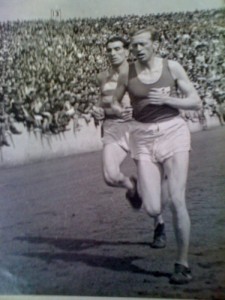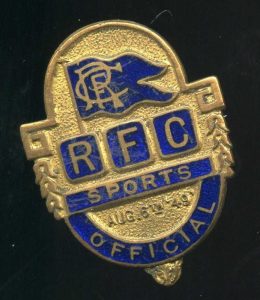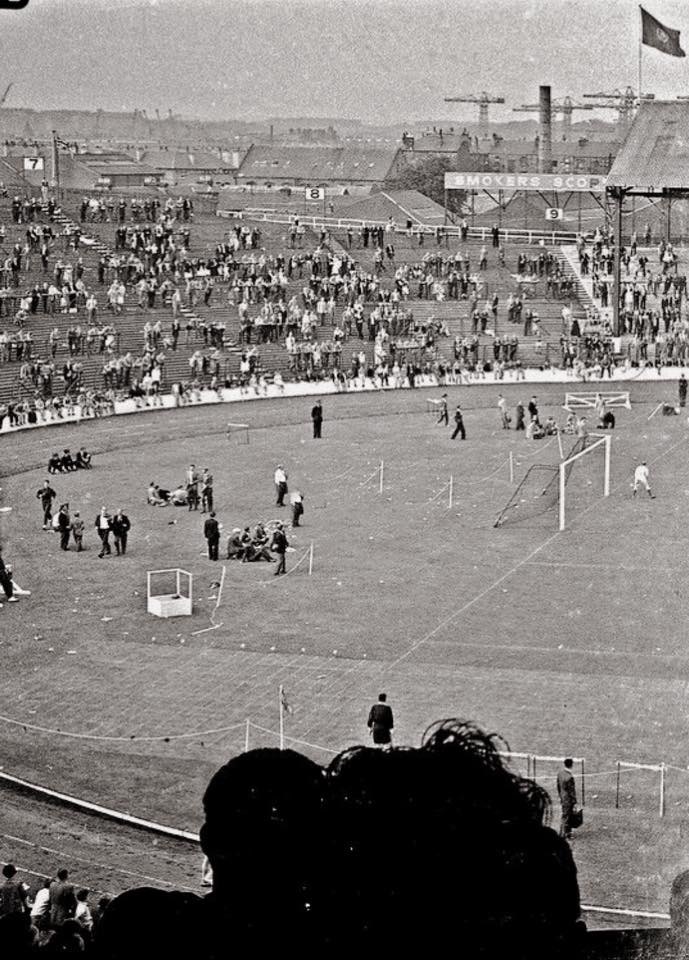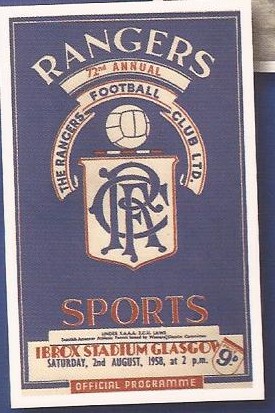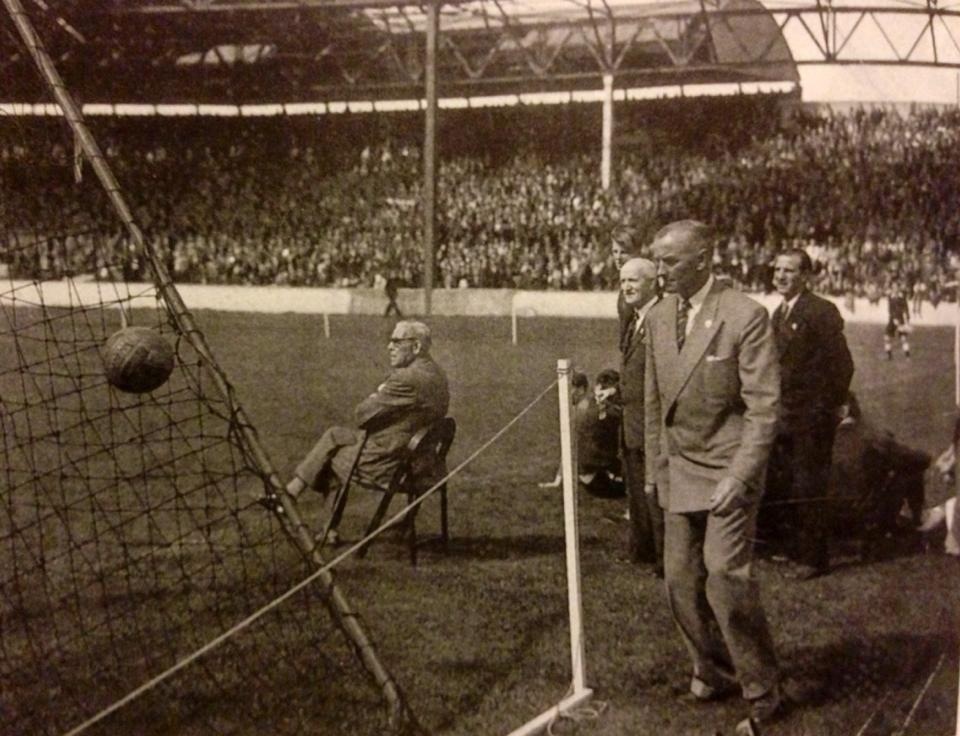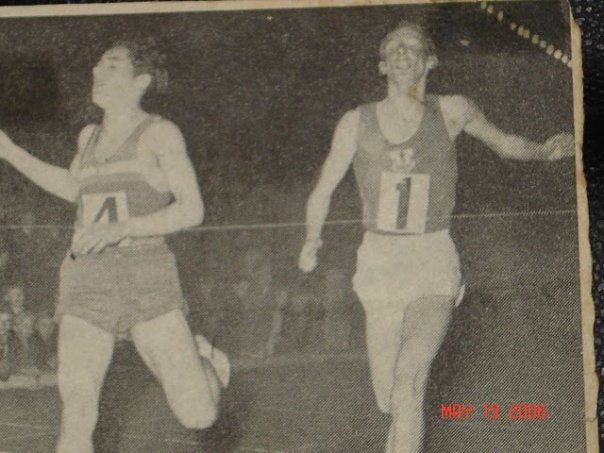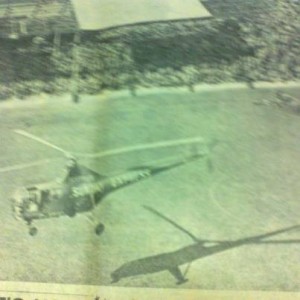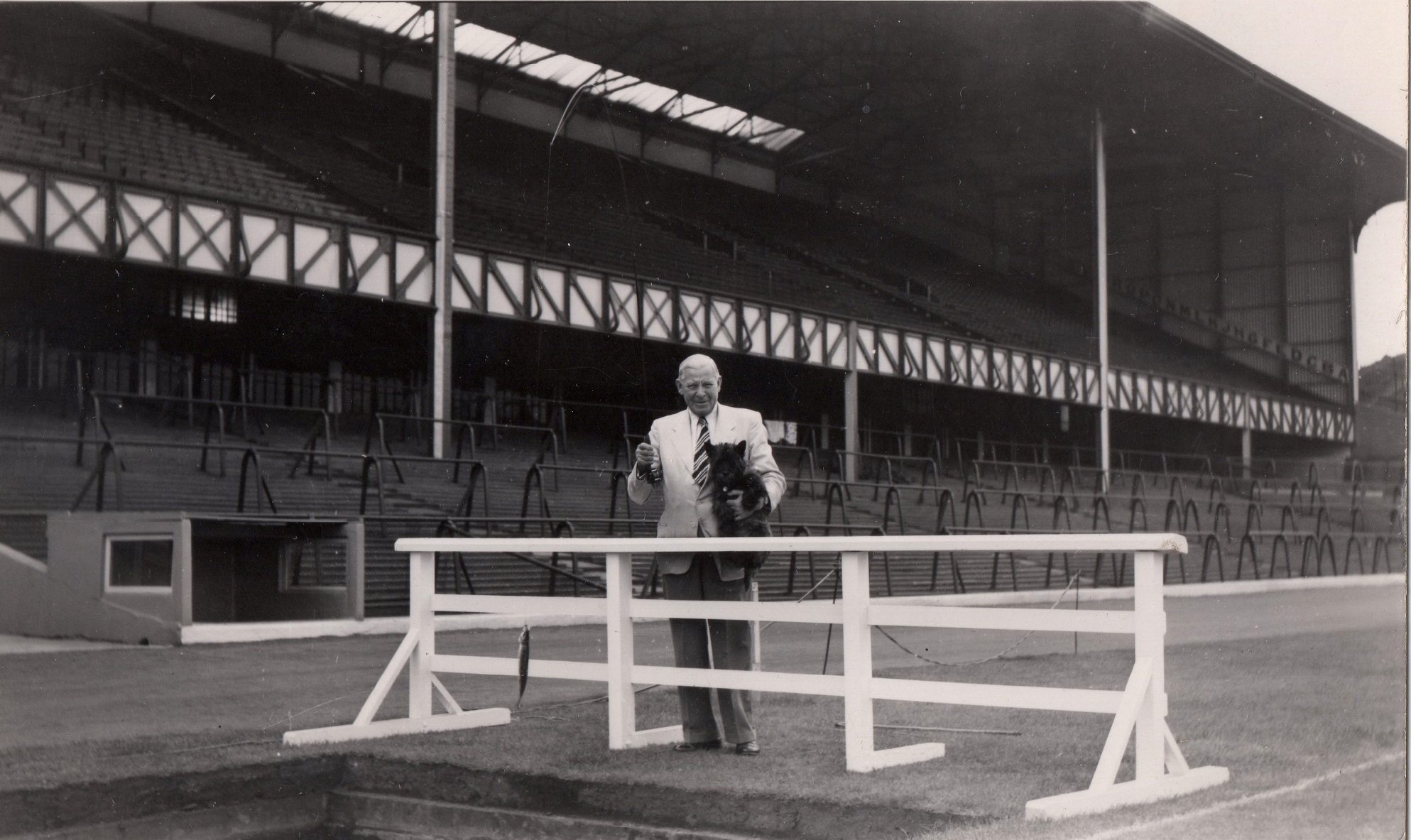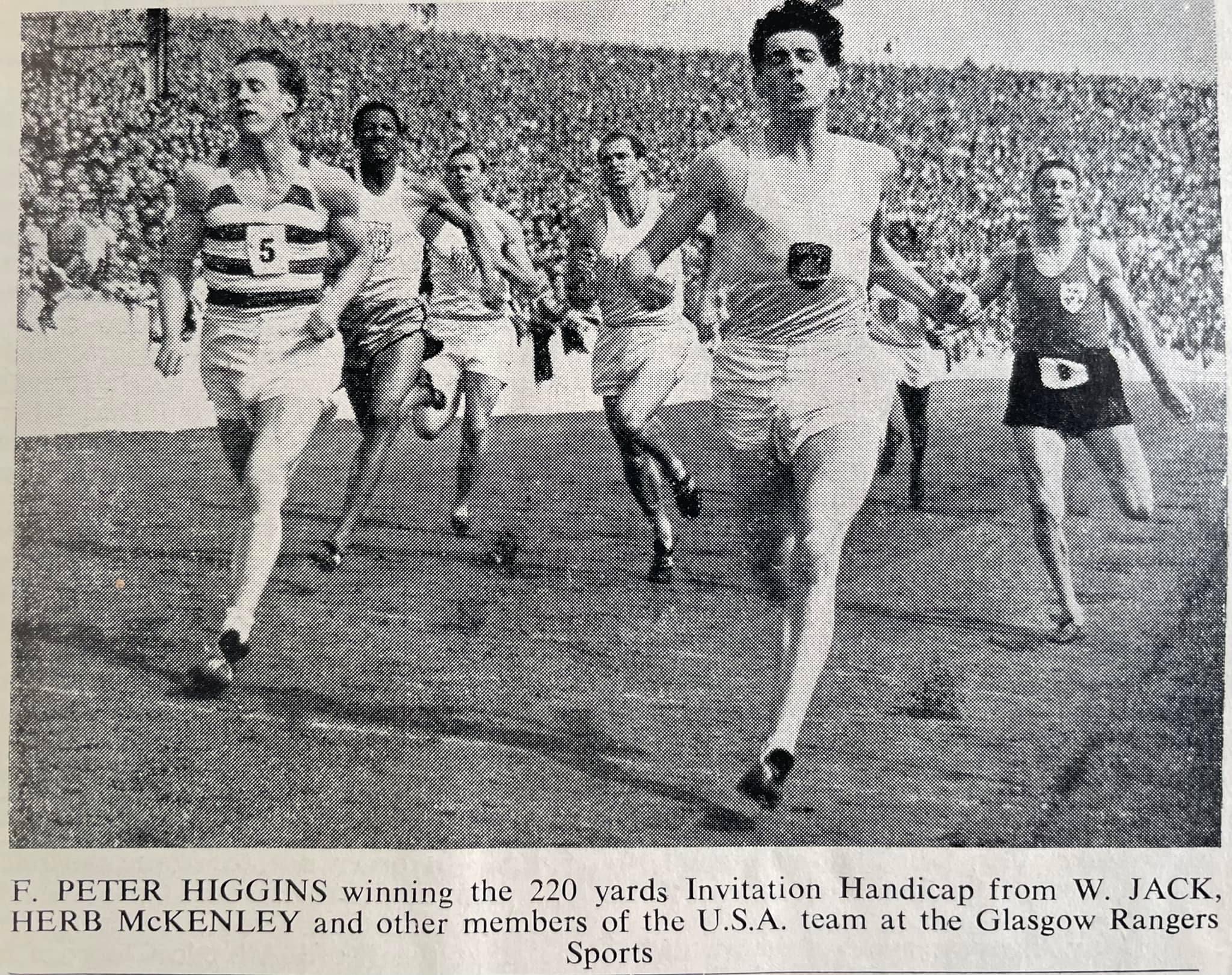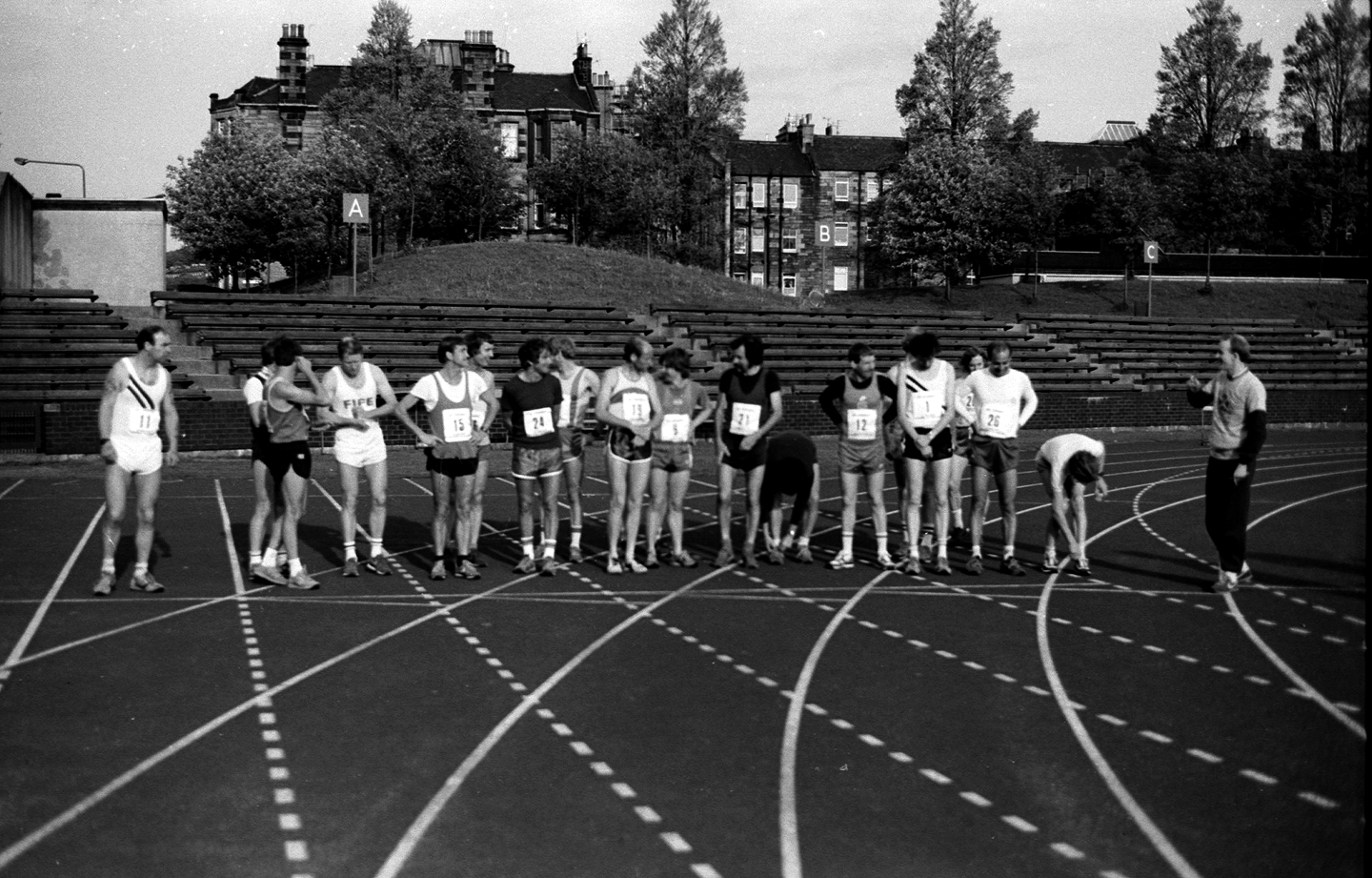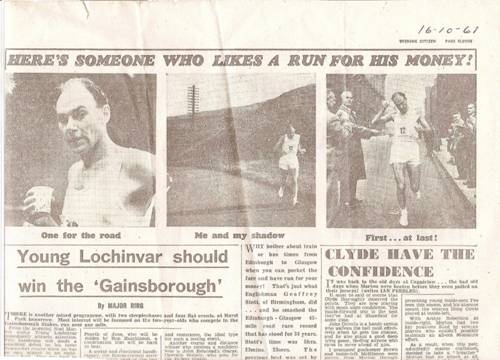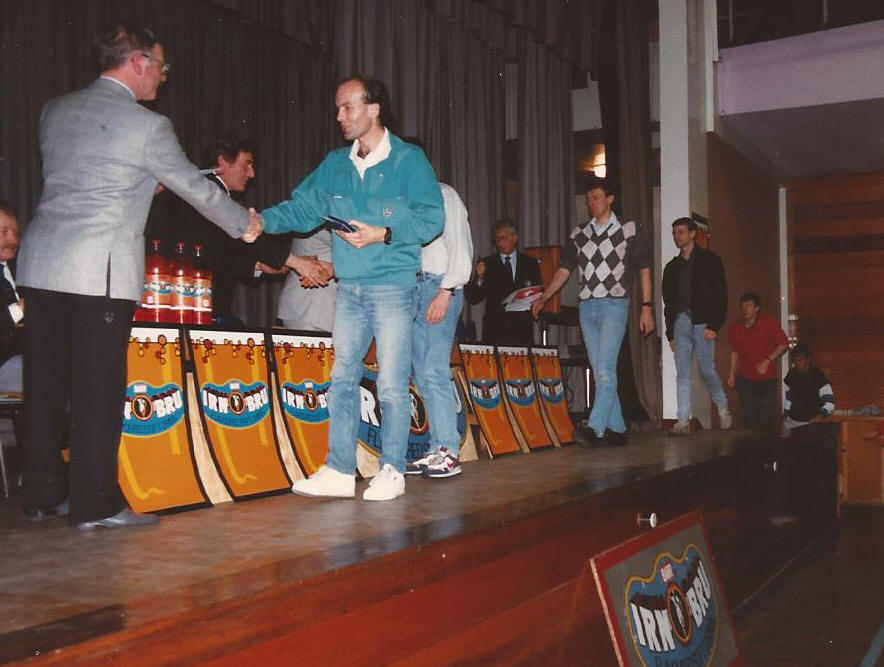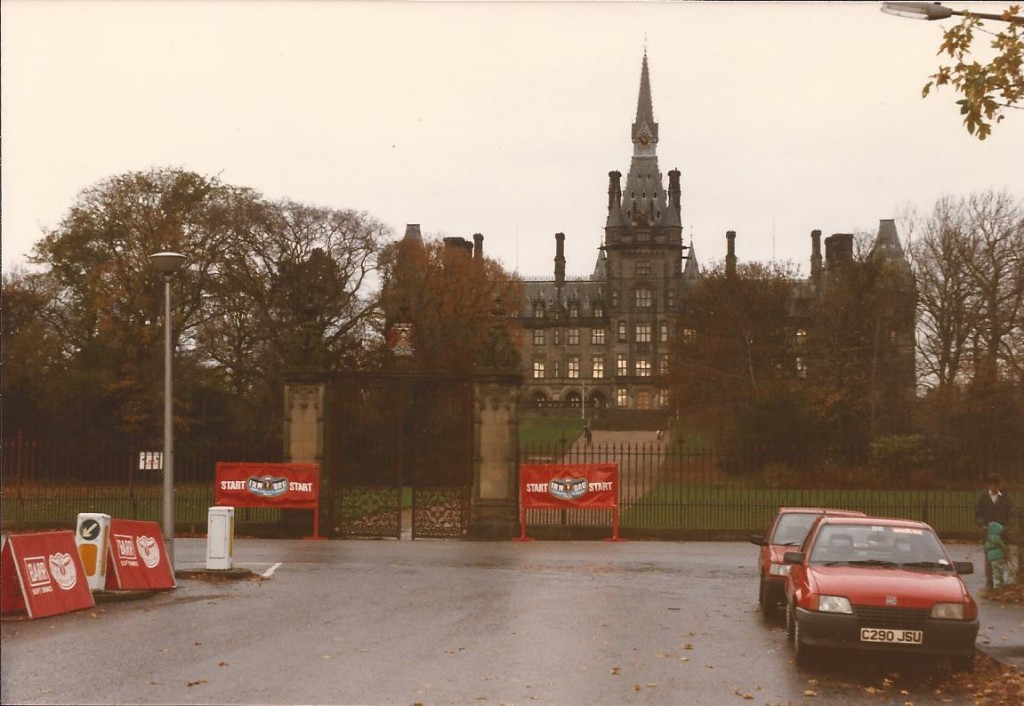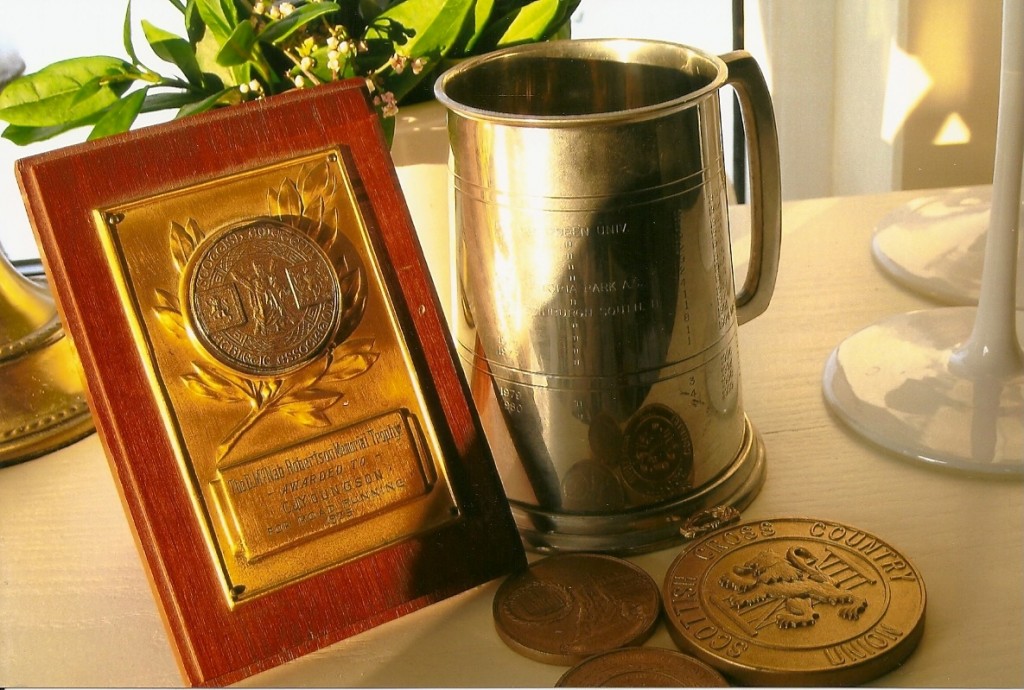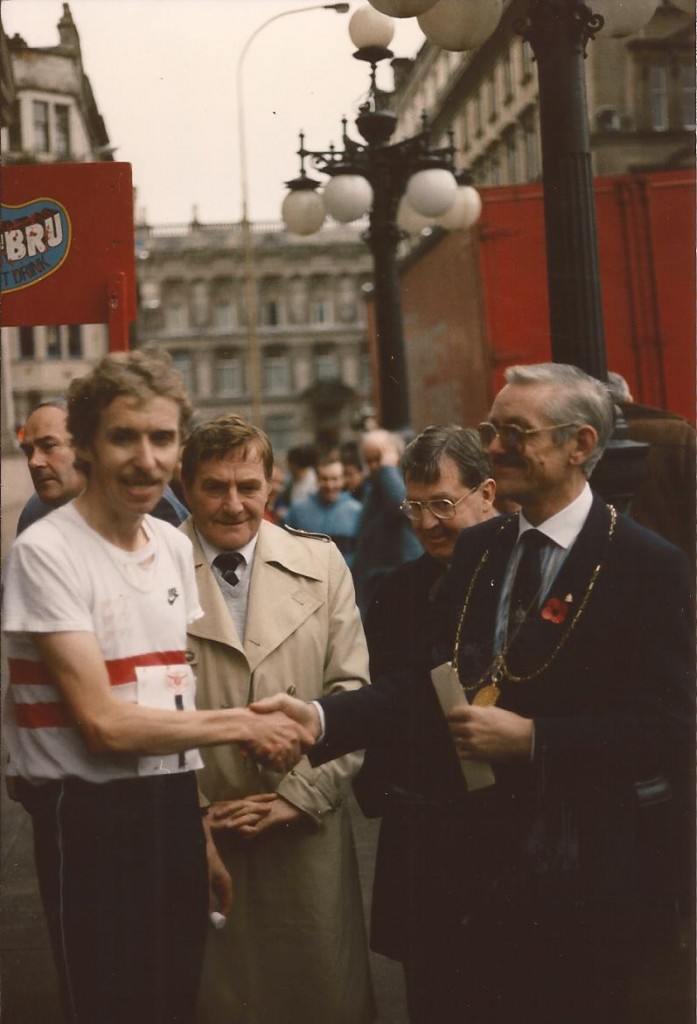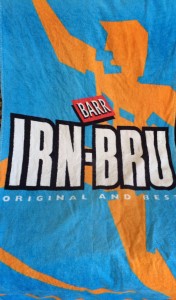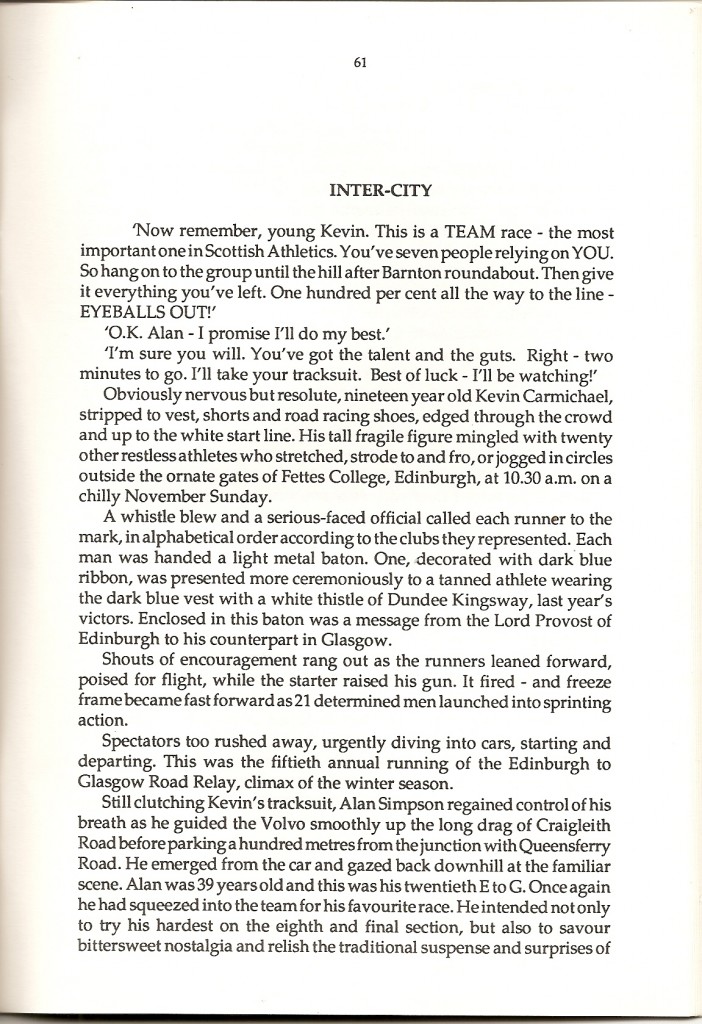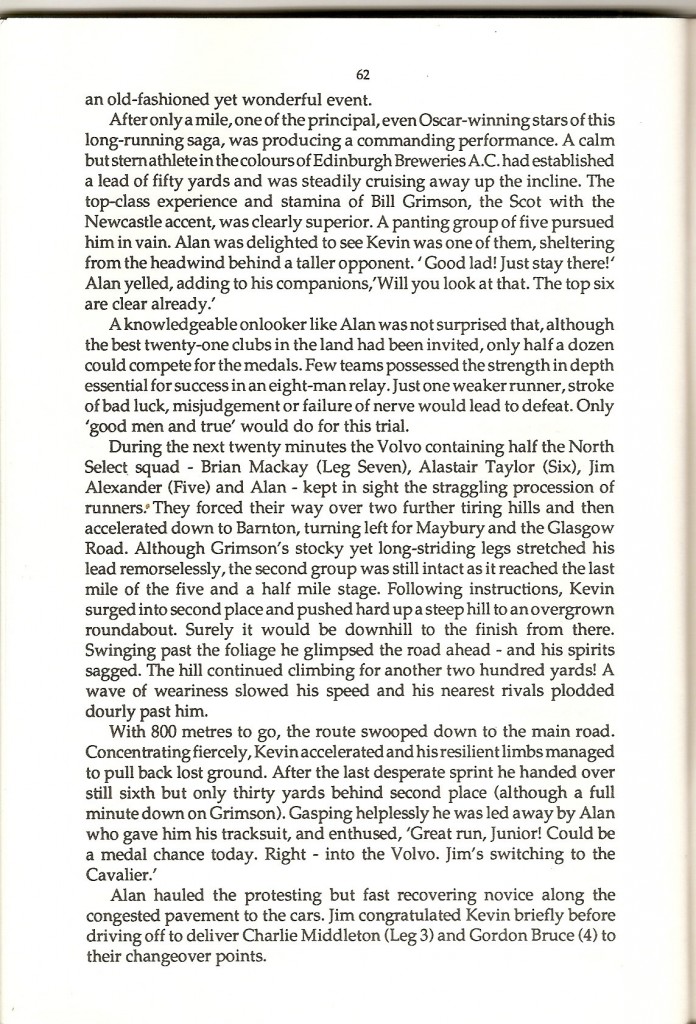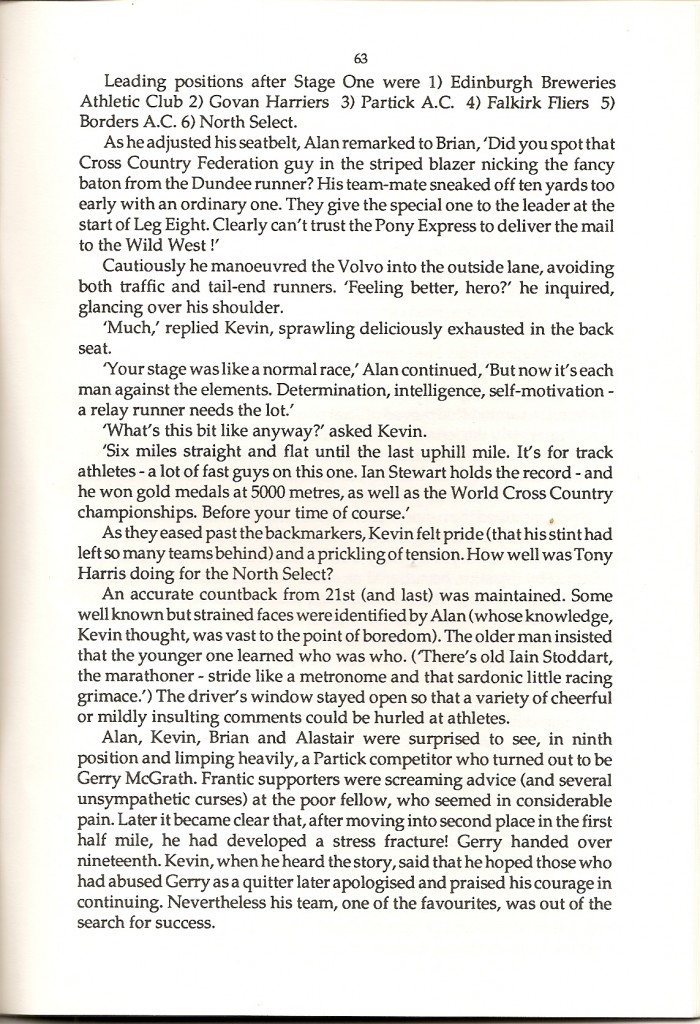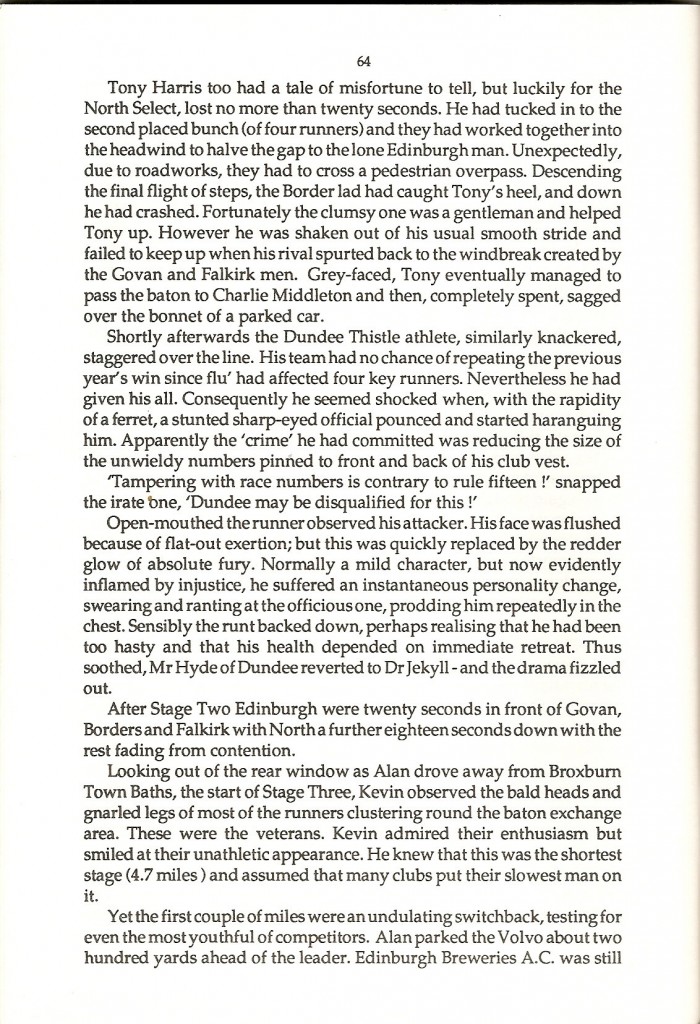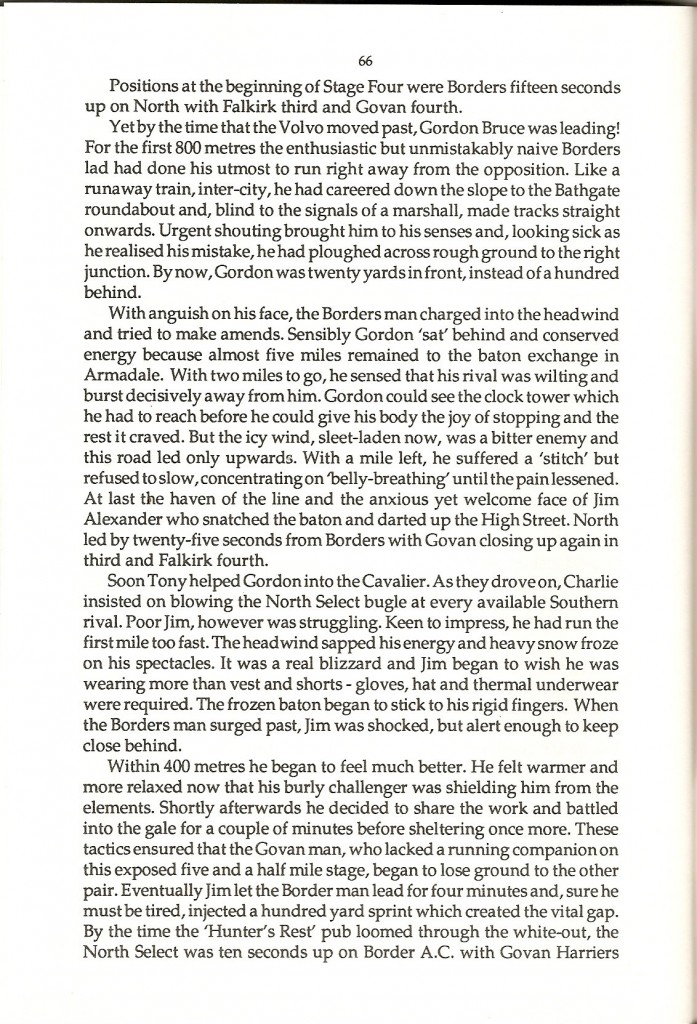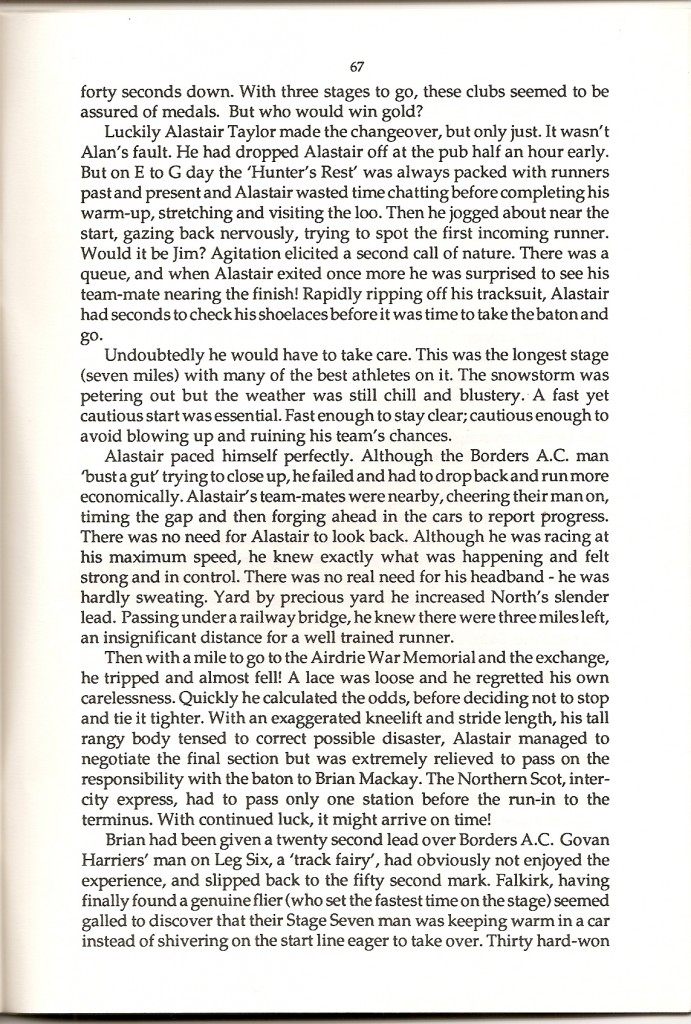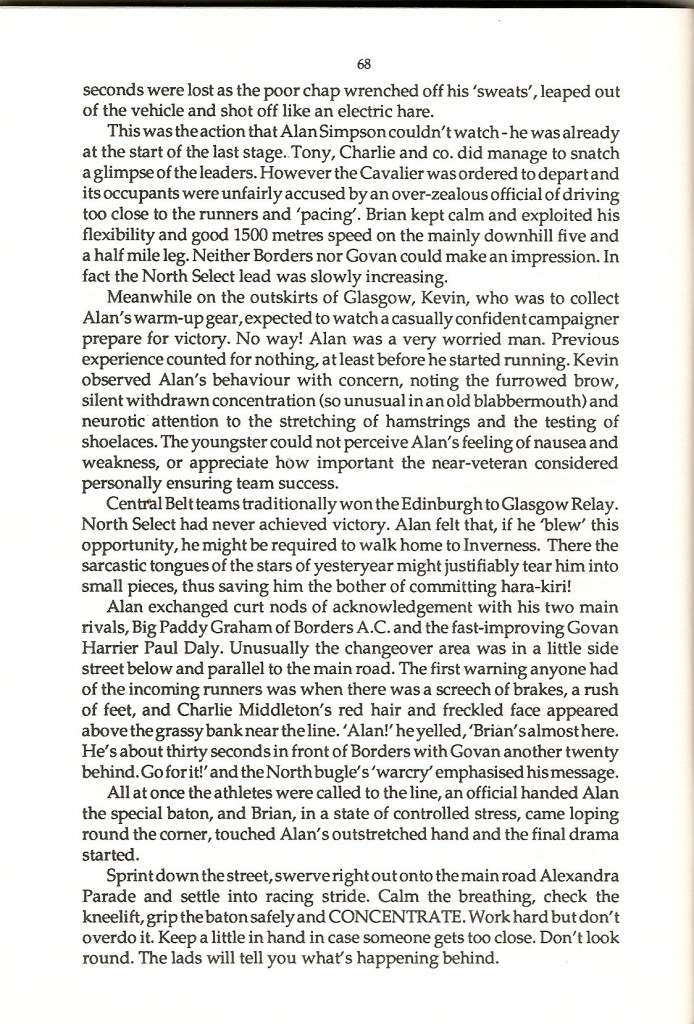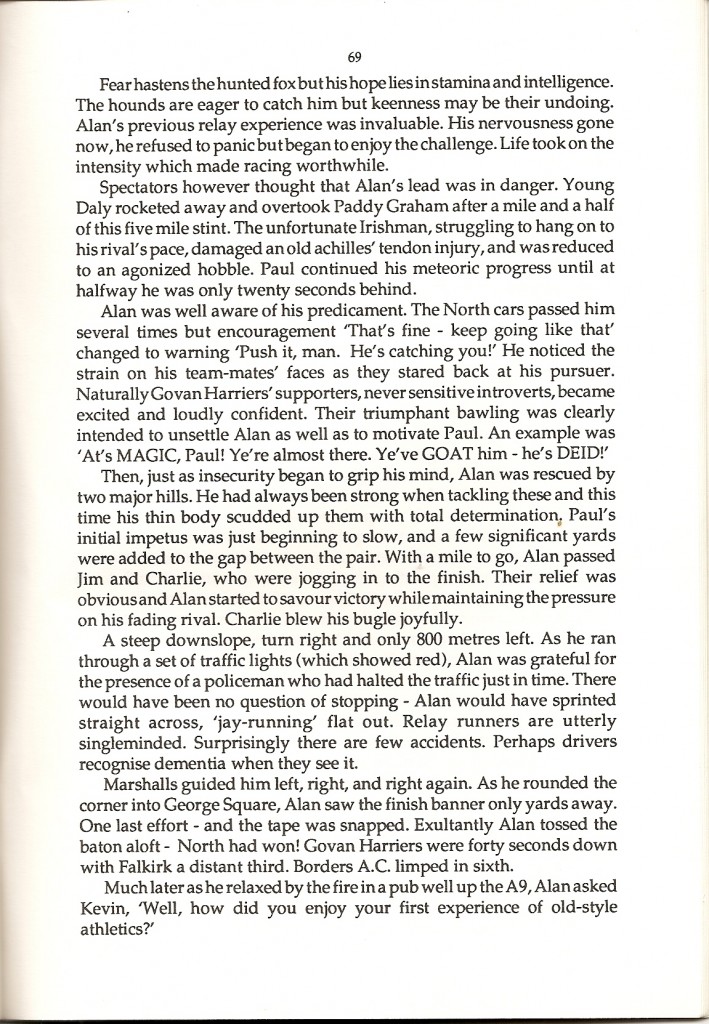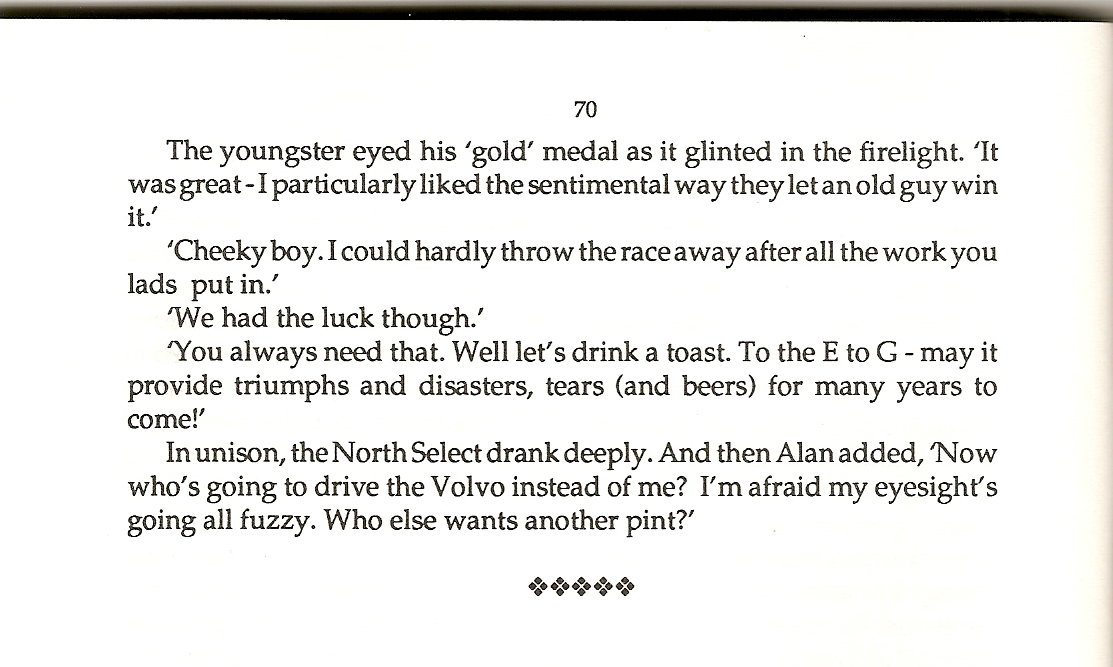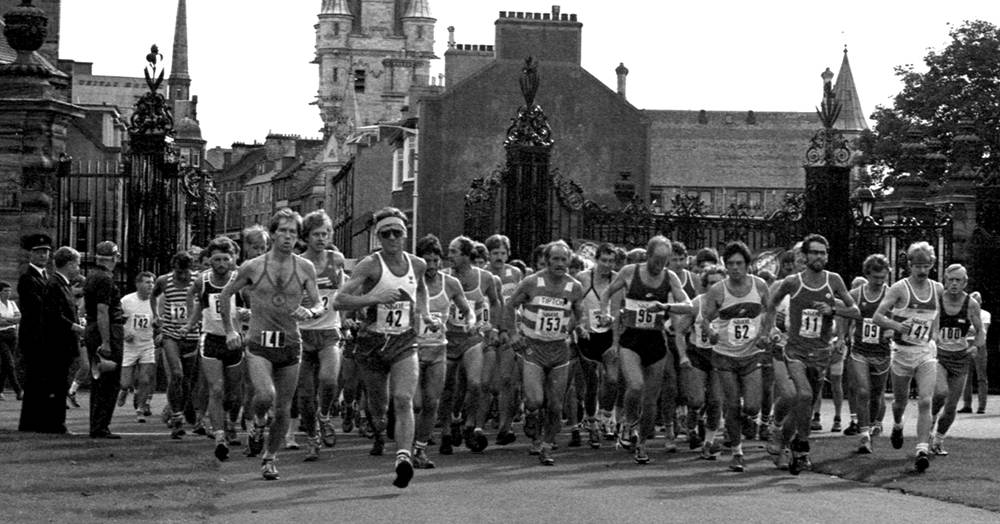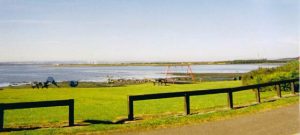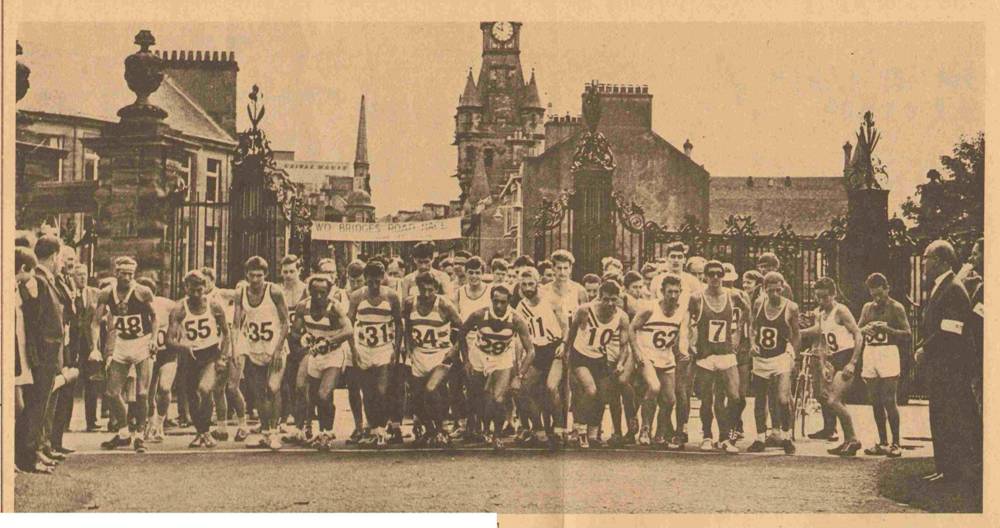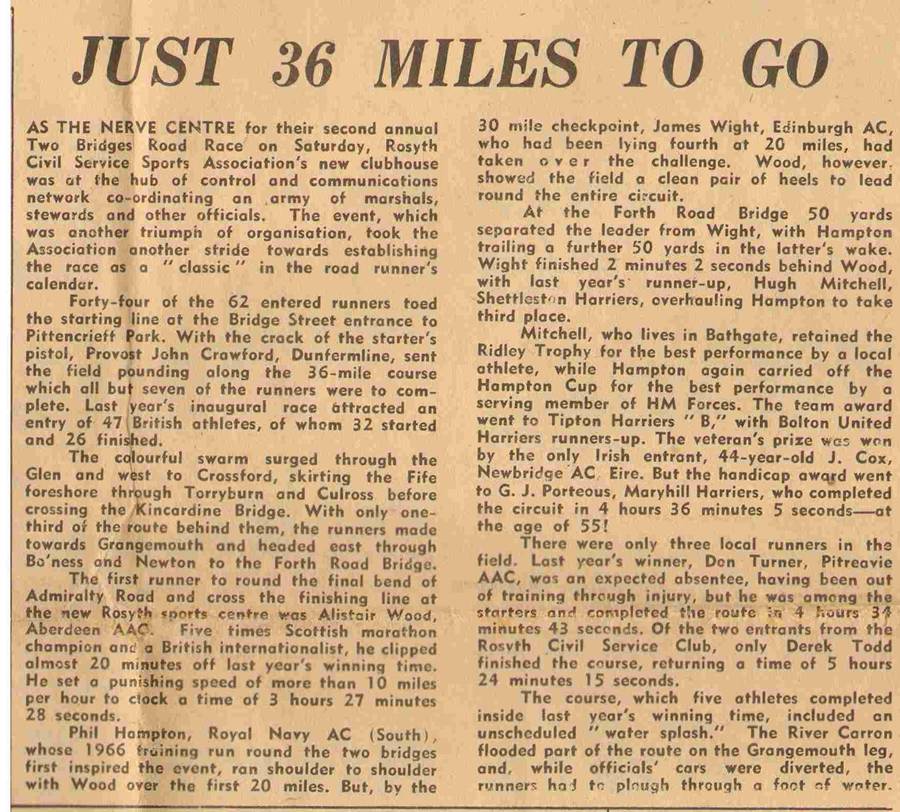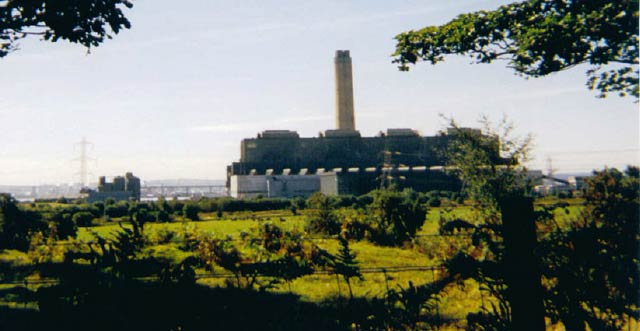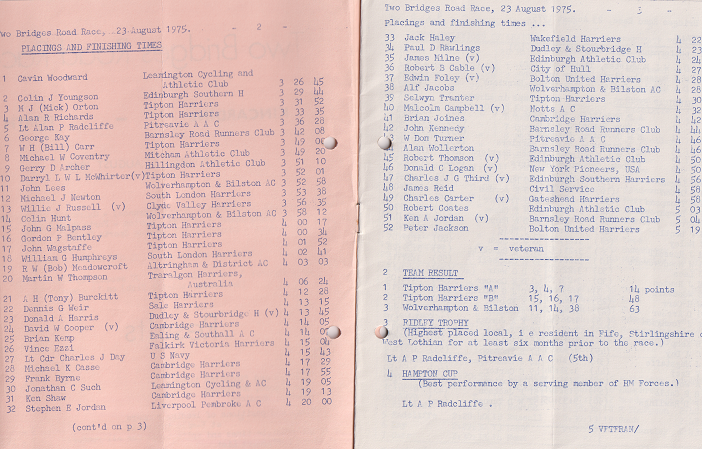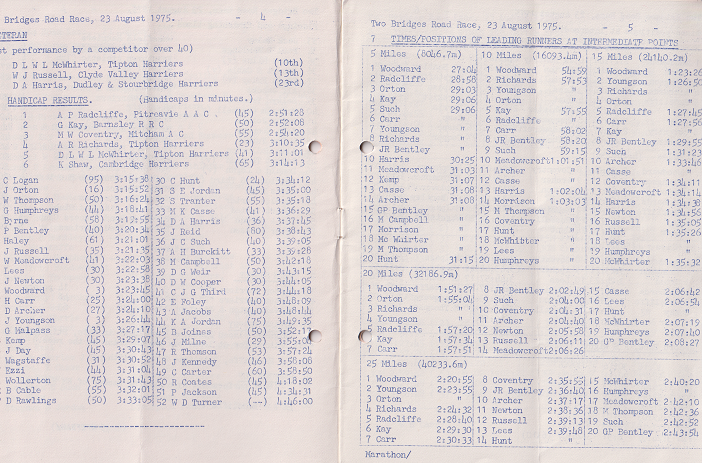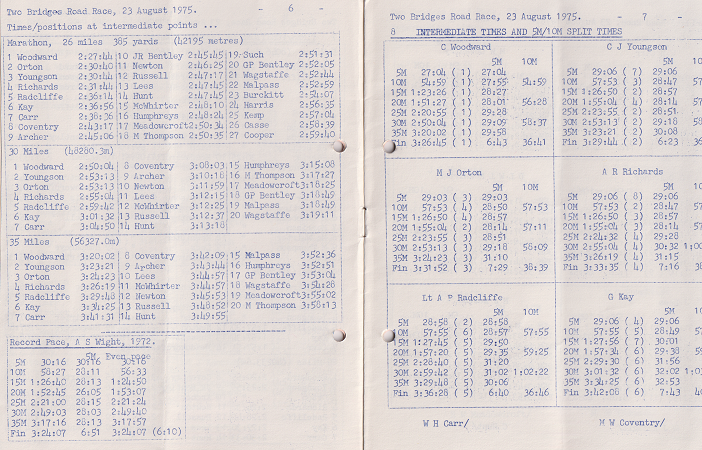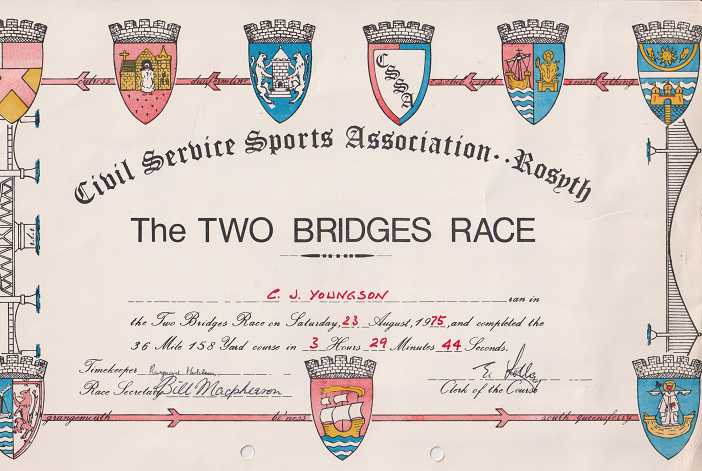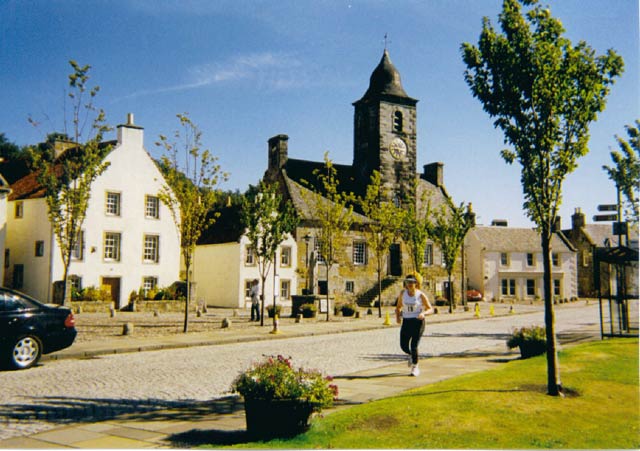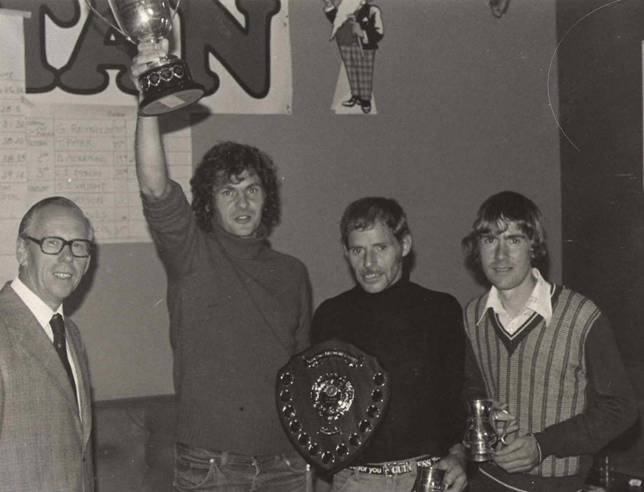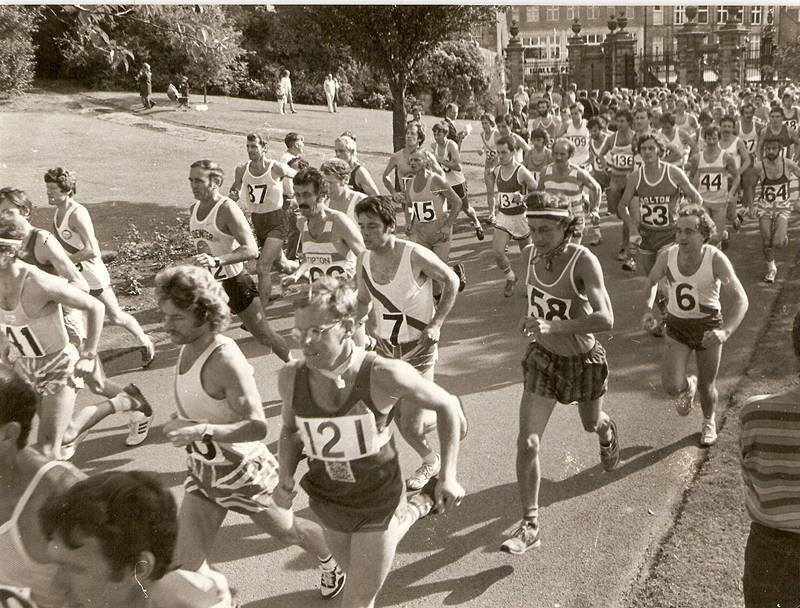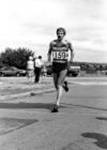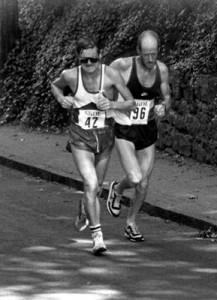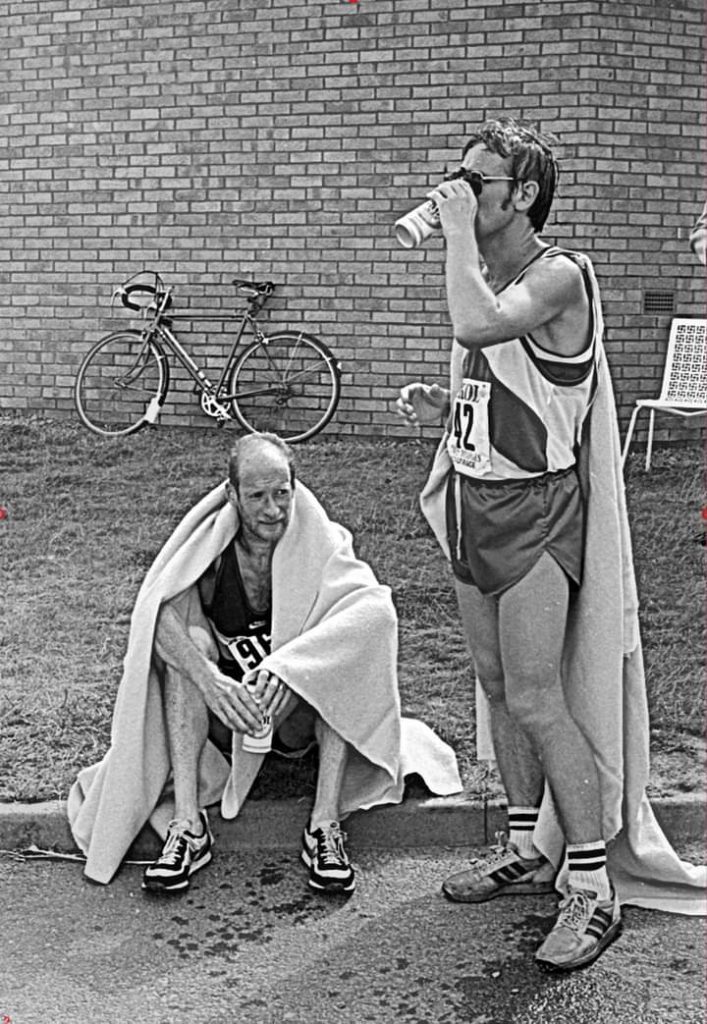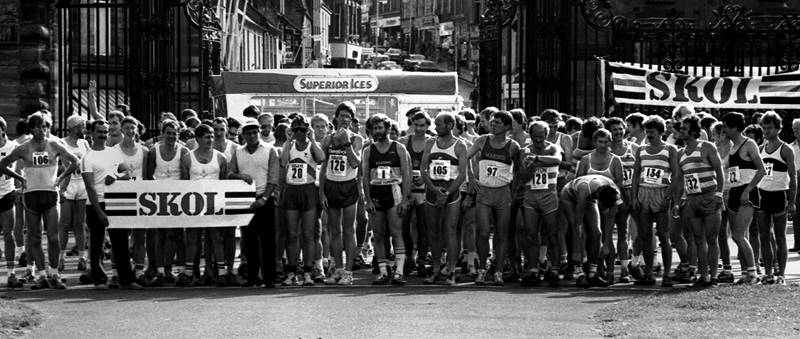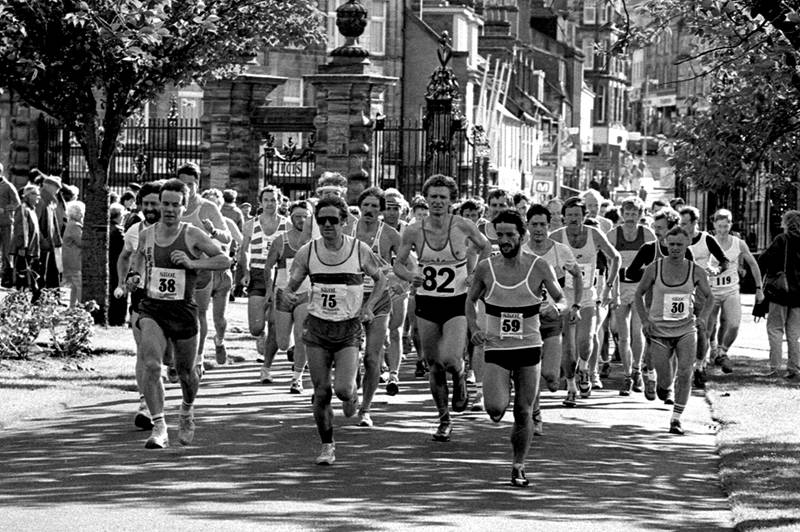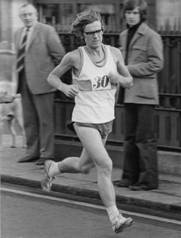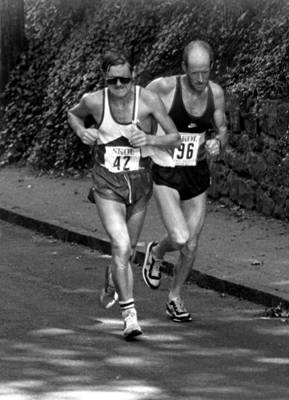Hugh was undoubtedly a top class athlete and like all of the best athletes travelled to get the competition he needed. What we have here are four extracts from the Victoria Park magazine – the first two from 1962 and the second two from 1971. They were sent to me by his club mate Colin Young and I found them very interesting indeed. The comments above about needing to travel for the right competition is sometimes disputed by those who say that with better organisation Scotland could provide for all the athletes’ needs. Not always true and the first item speaks of his need for better competition than he as a 16 year old at the time could get at home. Remember that Under 17’s were not allowed to race Seniors – Graham Everett at home for one could have given him a good competition! The second one indicates where he stood in the VPAAC rankings for the year but if you let your eyes stray to some of the other events and look at the standards there, you might be surprised at the club’s strength. Where do you see these guys finishing in the Scottish Men’s League competition in 2013? The 1971 article recaps his career from 1958 to 1970. The times were outstanding. The places were all good. Frank Horwill, the eminent coach and founder of the BMC who died last year always reckoned that Hugh was special – nit just because he was Member Number One of the British Milers Club, but because of his attitude to racing. Where many are reluctant to race too often (how often is too often?) or run from the front, Hugh was never one to hang back. Enough! Just read the following.
Category: Uncategorized
Edinburgh Highland Games
David Bowman (Clydesdale Harriers, 20) leads the field in the marathon from Edinburgh Highland Games in 1951
There have probably always been big sports meetings in Scotland’s capital city but they have been under a number of different banners. Where in Glasgow there were the Rangers Sports and the Glasgow Police Sports at Ibrox and the Lanarkshire Constabulary Sports at Shawfield or the Glasgow Transport Sports at Helenvale which were all distinct events with large crowds, there have been the Edinburgh Highland Games, the British Airways Games and, my favourite title, the Edinburgh Corporation Lighting and Cleansing Department Open Meeting. The Highland Games however was run on a five laps to the mile grass track at Murrayfield which could be treacherous when rain fell, even when there was a good track at New Meadowbank, and athletes really did come from far and wide. One of the things different from other similar meetings, was the fact that, according to Neil Donnachie who ran in several of the Edinburgh Games, athletes in the open events changed in the same dressing room as all the ‘stars’ from around the world. The list of famous names for almost 30 years who cam to the meetings is too long to list but if you read through what follows you will get Olympic champions (well into double figures), European Champions, Empire champions, not to mention national champions from over a dozen countries. The New World (USA, Canada, Jamaica), the Old World (almost every European country), Africa (Nigeria, Rhodesia, Kenya, South Africa and others) were all represented. The Games were organised by the wonderful Willie Carmichael whose story is told here and who was responsible for bringing the 1970 Commonwealth and Empire Games to the city.
Looking through ‘The Scotsman’, the first Highland Games were held at Murrayfield on 19 July 1947 in front of an estimated crowd of 20,000. The report was brief and is worth repeating since it was the start of a meting destined to be significant in Scottish athletics for several decades. It reads:
“Spectacle, thrills and spills contributed to make the Highland Games sponsored by the Edinburgh Corporation at the Rugby Union ground at Murrayfield a big success, and a crowd estimated at 20,000 were kept interested right to the end. With pipers, Highland dancers, competitors in the heavy events wearing kilts, there was an atmosphere of a Highland Gathering, and the speed at which the large programme was carried through reflected well on the promoters.
GE Mitchell, reinstated again as an amateur, was a winner of four field events, and when making a preliminary swing in the hammer throw there was a gasp when the head came off the hammer. Happily however no one was injured. Another “incident” was when a photographer, lying on the track in the face of the oncoming cyclists, was blamed for a collision between two competitors.
The athletic thrill of the afternoon was provided by the inter-city relay race. CJ Hall, the Scottish half-mile champion, found one of his shoes coming off and, in stopping to replace it, lost fully 50 yards when he had been leading. Withe a great burst of speed he chased RJ Sharp and was only beaten by about three yards – a most gallant effort.
DRB Grubb, one of Scotland’s most prominent milers, won the youth race over that distance; EQA Colie won the 220 and RJ Watt, Boroughmuir FP, had a double when winning both the high and long jumps.”
It sounds like quite a meeting. The Triangular International in 1947 was held in Murrayfield too.
The report in the ‘Scots Athlete’ tells us:
“Since JE Farrell in “Running Commentary” has touched on the highlights of athletic performances at the England – Ireland – Scotland athletic contest, held in conjunction with the Scottish Marathon Championship (Falkirk to Edinburgh) on 5th July at New Meadowbank, we only wish to make a few general comments whilst presenting the details for study and reference. The meeting was freely criticised for being too dragged out and finishing very much behind the scheduled finishing time. It is only fair to point out that this was partly caused by the officials in not allowing other events to take place while the marathon leaders were approaching, which was wise and courteous, but it seems there could have been better planning of the scheduling of events.
The meeting did not enthuse the crowd as it ought to have done. Sports’ promoters must make it their definite intention to cater for the public. Such an approach was lacking at this contest. The announcement of the results were disgraceful, the announcement of an event being given possibly after one or two other events had taken place. Surely a hold up such as this is not necessary, and surely, very annoying to the public. Then again it has been reported that the irish officials objected to the Senior Five-a-Side Tournament, and we would uphold this objection. The tournament was not in keeping with the meeting and anyway, the SAAA should aim at fostering pure athleticism – in the end it would gain more dividends for the sport, through a greater athletic-minded public. Such football tournaments cannot compare with the thrills of athletic contests. There was a large attendance, and the bumper ‘gate’ will help the SAAA Treasury, since out of the income England and Ireland only received a guarantee of £50 each.
Though Ireland gained most individual successes, England won the contest with 85 points to Ireland’s 64 points and Scotland’s 37 points. The meeting was summed up quite aptly in the Irish Press thus:- “To Ireland the honours, to England the victory. To Scotland the money.”
100 yds: 1. E McDonald Bailey (England) 2. A Watt (Scotland); 3. J Fairgrieve (England); 4. JA Gregory (Ireland). 5 yds, 2 yds, 1 yd 10.1 sec
220 yds: 1. J Fairgrieve (England); 2. AJ Gregory (Ireland); 3. A Watt (Scotland); 4. WD McKee (Ireland); 5. R Toone (England) 2 yds, 1 yd 23 seconds
440yds: 1. JP Reardon (Ireland); 2. B Elliott (England); 3. C O’Clelrigh (Ireland); 4. DC Pugh (England); 5. WDH Connacher (Scotland) 3 yds, 4 yds 49.7 seconds
880 yds: 1. CT White (England); 2. RL Sarbutt (England); 3. CJ Hall (Scotland); 4. JR Nelson (Ireland); 5. WN Ritchie (Scotland) 3 yds, 6 yds 1:57.9
Mile: 1. JJ Barry (Ireland) ; 2. AH Pettet (England); 3. WT Hawkley (England); 4. F Sinclair (Scotland); 5. RTS Macpherson (Scotland) 10 yds, 5 yds 4:25.2
Three Miles: 1. HA Olney (England); 2. A Forbes (Scotland); 3. SH McCooke (Ireland); 4. DM Haw (England); 5. J Owens (Ireland) 14:32.0 A new Scottish native record of 4:32.2 by A Forbes.
120 yds Hurdles: 1. Prince Adedoyin (Ireland); 2. DO Finley (England); 3. JGM Hart (Scotland); 4. F Sharpley (Ireland); 5. RA Powell (England) 2 yds, 4 yds 16.0 seconds
High Jump: 1. Prince Adedoyin (Ireland) 6’2″; 2. RC Pavitt and AW Selwyn (England), tied, second, 6’0″; 4. GA Garrick (Scotland) 5’8″
Long Jump: 1. Prince Adedoyin (Ireland) 23′ 5.75″; 2. DC Watts (England) 23′ 5.25″; 3. J Morris (England) 21′ 9.75″; 4. RM Smith (Scotland) 21′ 9.75″; 5. GH Caithness (Scotland) 20′ 3″
Javelin: 1. MY Chote (England) 185′ 9.5″; 2. MJ Dalrymple (England) 184′; 3. PG Skea (Scotland) 164’11”; 4. M Gleeson (Ireland) 158′ 2″; 5. D Kernohan (Ireland) 154’5″
Shot: 1. D Guiney (Ireland) 48′ 11″; 2. HE Moody (England) 46′ 5″; 3. C Glancy (Ireland) 41′ 11.5″; 4. DMcD Clark (Scotland) 30′ 10″; 5. JD Brewer (England) 30′ 7.75″
Discus: 1. E Nesbitt (Ireland) 142′ 3.75″; 2. EJ Brewer (England) 139′ 9″; 3. A Fields (England) 138′ 2.5″; 4. D Young (Scotland) 129′ 9.5″; JD Brewer (England) 121′ 2.5″
Mile Relay (440, 220, 220, 880): 1. England (R Toone, McDonald Bailey, DC Pugh, CT White); 2. Ireland; 3. Scotland 20 yds, 70 yds3 min 36.5 secs
There was no mention of an ‘Edinburgh Highland Games’ in 1947 but in ‘The Scots Athlete’ of August 1948 there was a whole page advertisement for the ‘City and Royal Burgh of Edinburgh HIGHLAND GAMES’ to be held at Murrayfield Rugby Ground on Saturday, 4th September, with Open Athletics Events, Open Cycling Events, Open Wrestling Events and Invitation Events. Entries closed with Willie Carmichael on 23rd August and other attractions included Piping, Shinty, Highland Dancing, Massed Army Gymnastic Display, Massed Pipe Bands and Massed Military Bands. Furthermore ‘Olympic Stars from Several Countries Will Take Part’. I don’t know when I have ever seen a bigger or more ambitious programme for a one day meeting – there were twelve open athletics events alone! With the Olympic Games being held in London in 1948 space was scarce and the only actual reference to the meeting was in the December edition of the magazine where Emmet Farrell’s ‘Running Commentary’ read as follows:
Are Football Tournaments Necessary? Before finally leaving the track season I should like to comment on an interesting feature concerning the Murrayfield Highland Games on 4th September. On a none too favourable day this meeting attracted an audience of approximately 25,000, and remember there was no 5-a-side football, and that a major first league match was taking place at Tynecastle. Surely this is an answer to those who assert that an athletics meeting must include such a tournament to attract a crowd. Perhaps active Eastern District Secretary Willie Carmichael who has been connected with several of these successful Edinburgh promotions can tell us the secret of success. No doubt the programmes were very comprehensive and attractive and good prizes offered, but similar conditions pertained in the west with less successful results. Could a better advertising campaign have something to do with it?
No results – of even the most cursory kind – but evidence of a large crowd and no complaints of over running this time!
Willie Carmichael
The back page of the July 1949 issue of ‘The Scots Athlete’ was taken up by a full-page advert for the City and Royal Burgh of Edinburgh Highland Games once more, on 3rd September, and offered 12 open athletics events and 9 invitation events plus a full marathon (26 miles 385 yards specified on the advert) plus cycling, military bands and wrestling. Entries again to Willie Carmichael who produced quite a show. The ‘Scots Athlete’ for September covered the event in some detail. First of all Emmet Farrell said: Murrayfield a Picture. If there is a better venue for an athletic meeting, particularly a Highland Games gathering than Murrayfield I should like to know of it. With its spacious stand, compact ground, its bright green sward, its general surroundings and atmosphere, Murrayfield looked a picture. Add to this a huge warmly appreciative crowd, a host of athletics personalities headed by Olympic champions Fanny Blankers-Koen and Arthur Wint as well as the real Highland Games atmosphere and you have the ingredients of a real feast of sport. .
W Carmichael who was the guiding light in this promotion once again proved his great flair for organising and it was grand to see such a resounding success. The hard-working Eastern District secretary has the gift of imagination and believes in doing things on a big scale. For example the appearance of Fanny Blankers Koen and Arthur Wint would alone have drawn the crowd. But an invitation was also sent to a select British team of athletes and cyclists: and what a team Jack Crump had with him including the great Welsh sprinter Ken Jones, quarter-miler Lewis, half-miler Tom White and three great milers in L Eyre, AB Parker and Douglas Wilson. In addition there was Ron Pavitt, one of England’s and Britain’s great two new high jumpers and a charming bevy of Britain’s best lady athletes including Dorothy Manley, Sylvia Cheeseman and new hurdle discovery Miss Desforges.
Fanny Blankers Koen did not disappoint. She was a colourful and resplendent figure in her flaming orange track suit. Equally so as she stepped on to the mark in white blouse and orange trunks and once more she moved gracefully but robustly over the hurdles and later over the flat. The Dutch girl has the solid robust qualities of the Dutch house frau allied to the elfin grace of a Peter Pan. Picturesque too was chocolate-coloured Arthur Wint from the time he warmed up in his white creamy track suit till he faced the starter and once more gave us a demonstration of that lazy, effortless style which deceives the eye but does not deceive the opponents who strive to hold on to his pace. But at the end of the day in attempting to recapture once more the high-lights of the meeting, perhaps the most striking feature of all was the magnificent enthusiasm of the spectators. The warm sportsmanship of the Edinburgh audience remains a fragrant memory.”
Although Emmet was as literate and accurate in his observations as ever, an article further through the same issue entitled “City of Edinburgh Highland Games: some impressions and reflections” by DA Jamieson, an athletics establishment figure who had written a lot of the ’50 Years of Athletics’ book on the history of the SAAA in 1933. He had much more space than Emmet and could spread himself and his comments more generously. It is an excellent article and reads:
It was in a scene of inspiring pageantry and splendour that the Scottish amateur athletic season of 1949 made a dignified and impressive exit with the presentation of the Third Annual City of Edinburgh Highland Games at Murrayfield Rugby Union Ground, Edinburgh, on Saturday, 3rd September. The genesis of this athletic gathering – which now bids fair to take primary place in the athletic sports calendar of the country – is to be found in the Holidays-at Home sports promotions which throughout the war years gave much pleasure and welcome relief to the people. To the small coterie of athletic enthusiasts to whom the development of this experiment was entrusted by the City Magistrates and Town Council the full flowering of their cultural efforts must afford the keenest satisfaction and pride.
Most sports promoting bodies would shrink from the responsibilities of holding an athletic gathering on such a date when the appetite of the Scottish football piblic is being whetted during a period of restricted football fare, but this Highland Gathering is unique in respect that it wholly excludes football from its prospectus and makes a direct and absolute endeavour to submit entertainment of a thoroughly comprehensive athletic nature combined with the introduction of intermissions both interesting and attractive. In this bold departure the promoters have met with signal success and richly deserve the congratulations of the Scottish sports-attending public.
In attempting to review the actual proceedings within the arena at Murrayfield it is somewhat difficult to visualise and maintain a clear picture, which inevitably becomes blurred by the multiplicity of happenings within the circle. With the presentation of many field events concentration on any given event becomes well-nigh impossible and even to the lay observer there will have to be a drastic pruning to obviate the danger of this meeting drifting into a state of wild undergrowth of foliage out of all proportion to the blossom.
Of the running handicap events which figured on the card the greatest thrill was provided in the finish of the 1 Mile race, in which the North of England entrant R Poxon, after a ding-dong struggle up the straight with a Borderer, R Taylor, literally threw himself at the tape, which action gained him the victory. This was indeed a handicapping triumph if also a judge’s nightmare; but in the Youths’ Race over the same distance a different picture was seen when a fifteen-year-old competitor – D Stirk, Pilton AAC – running from the limit allowance established a winning lead halfway through the race which he maintained easily to the tape.
The Invitation events all attained that high standard of performance which is expected of them. Although small in number of starters, the 100 yards race was rich in the quality of its participants, and Ken Jones, the Welsh Rugby Internationalist, found himself renewing acquaintance with the Murrayfield sward in yet another sphere of athletic activity and with a similar degree of distinction. His winning time of 10.2 secs does not truly reflect the merit of his performance, since the runners were sprinting up wind which had a considerable degree of strength in its gusts. Throughout the afternoon field events were exclusively engaging the attention both of competitors and of such spectators as were conveniently positioned to watch, and one heard through the loud-speaker that a new record for the Hop, Step and Jump had superseded that other achievement in the same event which awaits ratification by the SAAA. Since the claim affects Lindsay’s own earlier performance it must be gratifying to the Shotts AAC member to be able to substantiate still further his record achievements.
The participation by women in athletic events at sports promotion is too often watched by many spectators with a tepid interest and regarded in the nature of an interlude. The first appearance, however, in Scotland of Fanny Blankers Koen as a competitor in the 80 metres hurdles and 200 metres flat aroused the keenest interest of the spectators. On both occasions she was opposed by the fleetest of Britain’s women athletes and Blankers Koen’s dual victory was warmly applauded. Tru it is that the Hurdles iten quickly assumed a processional character, yet such was the urge to greater endeavour shown by the Scottish lass – Jean Thomson, Dumfries – that whilst running into third place she created a new native record of 12.5 seconds, time which is still capable of further reduction by this talented athlete.
Stronger opposition was provided against the Dutch athlete in the 200 metres race, but here again the supreme class of this Olympic star could not be denied as she swept through to the tape a winner in the most impressive manner. The appearance of this great woman athlete is bound to have an inspiring influence upon these girls who are so earnestly striving to restore to its pre-war prestige in Scotland the cult of athletics among its young women. The incidence of a period of calm which now prevailed gave ideal conditions for the decision of the 300 yards race and also the 1 Mile item. In the former race – one of the most testing distances in the running schedule – LC Lewis gave a brilliant performance when winning from Jones in the fast time of 31.1 seconds. Although this is not an officially recognised distance for acknowledgement on the list of records, yet it will be classified as the fastest run under the “Noteworthy Performance” entries. While it can be claimed that there is no finer grass track in the country than Murrayfield provides with its highly resilient and perfect cover of turf, the fact that Lewis had three turms to negotiate in his progress to the tape accentuates more keenly the great merit of this run.
An effortless win by Arthur Wint in the Half Mile scratch race in the very fast time of 1 min 54.1 secs came as a kind of anti-climax to the apologia which had been broadcast to the spectators prior to the decision of this race. Here young Petty’s effort is worthy of mention and the steady improvement in the Scottish Champion’s pace must be extremely gratifying to his mentor as well as to his club connections. Even more select than the 100 yards scratch event was that of the Mile race in which four runners took part – but they were four of the best, including L Eyre, the young Yorkshireman whose name must now be added to that great list of great milers who figure in athletics history. His winning effort in 4 min 16 secs – and making all his own running – speaks for itself and one would have liked to have seen the young Irish student Vic Milligan, no stranger to Edinburgh, test his paces once again against such sterling runners over this distance.
In the high jump event, RC Pavitt gave a polished display, clearing a meritorious 6 ft 5 ins.
Of some 14 starters in the Marathon Race there were eight survivors, and the finish in a relative sense, was very close. How galling the experience must be to be a runner-up in a race of this nature to be able to keep company with his opponent over a major part of the distance yet find himself unable to make that final effort which would yield him the fruits of victory – also the laurel wreath. There was little sign of exhaustion in Paterson’s bearing when he reached the winning line in mere 5 secs ahead of CH Ballard , confirming the wonderful stamina and endurance shown by him in his SAAA title win last July.
Behind all this cavalcade of sport and spectacle looms the figure of the man who from the very outset has been the creator and director of all this pulse-stirring setting of athletic activity and the fullest tribute must be paid to Willie Carmichael of the SAAA whose dynamic energies and flaming enthusiasm has put the seal of quality upon this Edinburgh Festival sports promotion. By virtue of his achievements in the sphere of athletic sports organisation he stands beyond challenge as the supreme impresario of Scottish sport.
But – and it is a necessary repetition – there must be a curtailment in the list of events to ensure that patrons can take an intelligent interest in what is transpiring in the field. More especially is this needed when one considers the fact that the finest exponents of the information conveyed through the microphone that so-and-so has achieved a certain feat in a certain part of the sports arena leaves with its hearer a certain sense of disappointment that the deed has eluded his attention.
It appears to be a chronic defect in athletic meetings of larger proportions that the arena should be crowded with individuals who are simply trespassers, and to whom repeated exhortations to get off the track leaves stone cold. A glimpse of what ideal conditions might be achieved was observable during the performance given by the Alsatian dogs, following which the ground was speedily cluttered up again. Again, during the massed Pipe Bands Display the number of amateur photographers exercising their hobby was beyond reason. Incidentally it was amusing to note the backward stepping of the “snappers” as the bands arrived. It suggested the title to a new pipe tune ‘The Retreat of the Camera-man’.”
Fair coverage of the meeting, well written – and no doubt about what he thinks on any point connected with the event!
***
In 1950, there was a preview in the August 1950 Scots Athlete. ” Edinburgh Highland Games. These Games have won for themselves a considerable niche in the Scottish sporting calendar. This year’s meeting is to be held at Murrayfield Rugby Ground on Saturday, 2nd September and every effort is being expended to maintain the variety and quality presented at its three predecessors. The quality of the athletic performances at these Games has hitherto been of an exceptionally high standard. last year was almost a unique occasion as two Olympic champions, Fanny Blankers Koen and Arthur Wint, were seen in action. Again this year international athletes will contest scratch races at 100, 300, 880 yards, Mile and 3000 metres and women’s 80 metres hurdles. It is hoped that Maureen Gardner (Mrs Geoff Dyson) will be seen in the latter event. An Inter-City Edinburgh, Glasgow Manchester, relay and inter-association, SAAA v AAA, relay are two new features which should provide great racing. The Edinburgh Marathon run round the boundaries of the city proved a popular introduction last year and is being again held over the same course. Jack Paterson, Polytechnic Harriers, is coming up to have a go again. He won last year and holds the Edinburgh Trophy. J Henning is coming over from Belfast. Charlie Robertson, Scotland’s former marathon, saw the Games from the Stand last year: this time he contests the marathon.
It is unfortunate that the state of the turf coupled with the proximity of the rugby season has necessitated some restrictions in the number of competitors in the field events. The throwing events will be by invitation and the jumps on a restricted handicap basis. Being held as they are in the midst of Edinburgh’s International Festival of Music and Drama, these Games attract quite a large number of foreign visitors, but they are also well supported by residents in Edinburgh and around.”
The report appeared in the September issue.
“The Edinburgh Highland Games, held on 2nd September at Murrayfield, was a magnificent athletic gala, holding the attention of the large number of spectators to the end of the proceedings. It lived up to its reputation of being one of the best dates on the whole athletics calendar. Every invitation event was star studded with noted athletes from various countries participating. Although no records were broken there were some brilliant performances.
In the scratch 100 yards, Brian Shenton (last year’s runner-up), fresh from his European victory, won with a great finish from AR Pinnington with Scottish champion Sandy Bruce third in 9.9 seconds. Anglo-Scot Norris McWhirter impressed greatly with his 300 yards win in 31.6 seconds, just 0.4 outside Halswelle’s long-standing native record. The half-milers were pic-nicking – European champion HJ Parlett won from Roger Bannister in 2 mins 3.6 secs. Victor Milligan extended the famous John Joe Barry right to the tape in the mile race won by the latter in 4 mins 24.3 secs. Tom Tracey (Springburn) was first home in the 3000m team race but the team award went across the Border to the Gosforth Harriers.
Alan Paterson maintained his standard with 6 ft 5 ins in the High Jump. Perhaps the most colourful event was the Pole Vault. Erling Kaas, the colourful Norwegian athlete, cleared 13 ft 6 ins and after gallant tries failed at 14 ft. He was given a rousing reception. In the same event, young GM Elliott became the third Britisher to clear 12 ft 9 ins. JA Giles won the Shot and J Drummond of Heriot’s, the former Scottish champion, pleased being runner-up with one of the best home efforts in a long time being but 4 inches off the native record. Drummond also won the Scots Hammer event.
Edinburgh beat Manchester and Glasgow in the inter-city relay, and a popular win was the relay victory of the Scottish Select (J Petty, N McWhirter, W Jack, D Gracie) against the AAA team. Elspeth Hay rounded off the track events display by beating Maureen Dyson and Jean Desforges in a special 100 yards.
Not the least impressive scene on the arena by any means was the grand display of Scots Country Dancing to teh accompaniment of massed pipe and military bands. In the round the city marathon, Scottish champion Harry Howard (Shettleston) gradually pulled from the leading group and running powerfully went on to finish the testing course a clear winner giving him further claims as one of Britain’s best. Veteran JE Farrell (Maryhill) moving strongly in the latter stages passed noted English and Irish rivals to be runner-up. Among the majority of contestants who retired were F Gratton (had travelled unwell) and Charlie Robertson who felt the effects of his record breaking run the previous week. (Winning time was 2:40:10, Farrell 2:43:46; G Iden 2:45:42).
In 1951 there was no report on the Games themselves but a first class report on the marathon with some excellent photographs.
Thanks to Arnold Black, I have a copy of the programme of the meeting and very interesting it is too. The invitation events included a One Mile with runners W Nankeville (Walton AC – British Mile Champion 1949/50; best time 4:8.8), AB Parker (Barrow AC – Winner of Mile in Triangular International 1951), HJ Parlett (Dorking St Pauls AC – British Empire 880 yards and European 800 metres champion), W Lennie (Vale of Leven AAC – Scottish Champion), J Smart (Edinburgh SH – Scottish Half Mile Champion, 1948), D Grubb (Heriot AC and Victoria Park AC), R Coutts (Aberdeen University AC – Scottish Inter Varsities Champion) and D Parmenter (Burchfield Harriers); a 100 yards with Brian Shenton (European 200 metres champion 1950), W Jack (Victoria Park – Scottish 100 and 220 yards champion), J Millican (Elswick H – Northumberland and Durham 440 yards champion), O Hardmeier (Edinburgh SH, Swiss Olympic representative), AS Dunbar (Stranraer Harriers) Scottish JUnior 100 yards champion), E McDonald Bailey (British Champion and record holder and these were all in the same heat. The second heat of the 100 yards included Andy Stanfield (USA – American 100 and 220 champion 1950), MD McWhirter (Achilles – Scottish Internationalist), J Schofield (Elswick – Northumberland and Durham 100 and 220 yards champion) and J Mclachlan (Maryhill Harriers – Scottish Internationalist). The Two Miles Flat Race (Invitation) was a team race with Victoria Park, Garscube, Gosforth, Bedlington Harriers, Motherwell YMCA plus five individuals from the AAA’s including Walter Hesketh, C Brasher, TG Hosking and RF Robins plus Eddie Bannon entered as an individual. There were open events including a 100 yards with 18 Heats of seven runners and handicaps ranging from a half a yard to 11 yards. Below is the centre page from the programme with some highlights of previous games.
*
1952 was Olympic year and many of the Olympians travelled to Scotland and competed at both the Rangers Sports and Edinburgh Highland Games. Remigino, McKenley, Rhoden and company were an inspiration and although there was a big demand on space with coverage of the Olympics including previews, reports and reviews after the event, the magazine managed to cover the big Scottish events after a fashion. The comments on the Games were in the November issue of ‘The Scots Athlete’.
“Spectacular Edinburgh Games”. The Edinburgh Highland Games with its magnificent Murrayfield setting provided the usual mixture of music spectacle and sheer intrinsic athletics. Mal Whitfield who surely must be one of the greatest half-milers of all time revealed versatility by winning his own speciality – then going down to 220 and winning that also. Another McKenley-Rhoden duel ensued with McKenley on top. Then Rhoden showed his versatility by taking the ‘200’ with a remarkable 9.7 secs. It was another triumph for the organisers, with the complete programme of the multifarious events concluded 7 minutes before schedule – quite unusual – but a pointed reference for sports promoters. Of course, as usual the genius behind the scene, who seems to leave no stone unturned in ensuring the success of a meeting is our own Willie Carmichael, formerly the Eastern District Secretary and now the SAAA Vice President. The Association President ins Duncan McSwein who is also responsible as treasurer. It will be recalled that Mr McSwein and Secretary Mr Gilbert were at Helsinki as Assistant Team managers to the British team.” It also points out separately that the attendance was 50,000!
The ‘Glasgow Herald was a bit more fulsome about the match, saying “Fully 50,000 people saw excellent sport at the Highland Games at Murrayfield on Saturday including the making of three Scottish all-comers records. In the weight putt P O’Brien (USA) reached 55′ 2” – half an inch better than the previous record set last year by JE Fuchs (USA). O’Brien later competed in the Scots Hammer and, although he is a novice in the event, showed that with a week or two of practice he would probably beat any Scot. GV Rhoden (Jamaica) equalled the all-comers record for the 100 yards with 9.7 seconds. This was a grand performance especially as he had just previously run the quarter-mile in which another Jamaican, H McvKenley, beat him in an extremely close finish in 47.6 and thus reversed the position in the Olympic 400 metres. Rhoden competed with a limb in plaster protecting a slightly pulled muscle.
The best dual performance of the meeting was accomplished by MG Whitfield, the Olympic 800m champion. He won the half mile with 1L57.1 and then the special furlong in 22.3 seconds. His form in the latter event revealed that he possesses the pace of the best sprinters for it was over the last 20 yards that he passed L Laing (Jamaica). One of the surprise results was the defeat of the Olympic 1500 metres runner-up R McMillen (USA) in the Mile. DR Burfitt (AAA) was in the rear at half distance and McMillen apparently out on his own. Over the last lap, Burfitt wiped out McMillen’s 30 yard lead and beat him by five yards in 4 min 17.4 sec.
W Davis and J Biffle (USA) achieved all that was required to win the high and broad jumps. Davis was suffering from a damaged foot and ceased jumping at 6′ 2″. In the women’s events, B Brouwer (Holland) knocked 0.1 second off the 100 yards all-comers record and SB Strickland (Australia) reduced the 80 metres hurdles all-comers record from 11.3 to 11.2 seconds.”
Looking at the names listed, the athletics enthusiast is in wonderland!. Almost all the Jamaicans – McKenley, Rhoden, Laing – only Wint missing, the Americans – Davis, McMillen, the marvellous Whitfield, the great Parry O’Brien; the Australian women – Betty Cuthbert, Shirley Strickland! And the crowd of 50,000 is confirmed
.After the Olympic year of 1952, 1953 was bound to see a bit of a drop in standards but nevertheless the meeting featured athletes from Germany, Belgium, Switzerland, the Argentine, the Netherlands and England as well as the best of Scottish athletes. Results:
100 yds: 1. R Gallan (Argentine) 9.7, equals Scottish A-C record); 2. B Shenton (AAA) 9.9; 3. W Jack (Vict Pk) 9.9
220 yds: 1. B Shenton 22.0; 2. PG Fryer (AAA) 22.4; 3. W Jack (Vict Pk) 22.6
440 yds: 1. H Geister (Germany) 48.7; 2. LA Smith (AAA) 49.2; 3. S Steger (Switzerland) 49.5.
880 yds: 1. W Leug (Germany) 1:54.2; 2. B Grogan (AAA) 1:55.0; 3. DC Seaman (AAA) 1:57.4.
Mile: 1. DC Law (Achilles) 4:19.3; 2. L Eyre (AAA) 4:20.9; 3. CJ Simpson (Small Heath) 4:24.4
Two Miles (Individual): 1. F Green (AAA) 2. I Binnie (Vict Pk); 3. C Brasher (AAA) 9:04.1
Team Placings: 1. Vict Pk 10 pts; 2. Shettleston Harriers 21; 3. Edin Sth 29.
Inter-City Relay (1408 yds): 1. Glasgow (D McDonald, W Jack, R Whitelock, DK Gracie); 2. Edinburgh; 3. Birmingham. 2 min 44.8 secs.
Inter Association Relay (1408 yds): 1. AAA (L Smith, AW Lillington, B Shenton, PG Fryer); 2. SAAA 2 min 52.6 secs
HJ: 1. DRT Cox (AAA) 6ft 2 in; 2. NGA Gregor (Kent CC) 6 ft 0 in; 3. K Cunningham (Vict Pk) 5 ft 10 in.
LJ: 1. AR Smith (Glasgow U); 2. J McAslan (Edinburgh S); B Devine (“Q”) 21 ft 2.5 ins
PV: 1. GM Elliott 13 ft 6 ins; 2. NGA Gregor; 3. J Vicario (Belgium) 12 ft 6 ins. (No distance for Gregor was listed in the results as published.)
Wt: 1. V Depre (Belgium) 45 ft 5 in; 2. J Drummond (Heriot) 44 ft 2.5 ins; 3. T Logan (Vict Pk) 41 ft 4.5 in.
WOMEN:
100: 1. A Pashley (AAA) 11.0; 2. P Brouwer (Neth); P Devine (“Q”)
220: 1. P Brouwer 25.3 (Scottish A-C record); 2. A Pashley; 3. E Hay.
80m Hurdles: 1. J Desforges (Essex L); 2. I Pond (London Olympiades); W Lust (Neth) 11.4
Inter-Association Relay (704 yards): 1. English WAAA (Pashley, Burgess, Desforges, Johnson) 1:19.0; 2. SWAAA
***
In 1954 we know that there was another Edinburgh Highland Games but unfortunately 1954 not only had a European Games but also had a Commonwealth Games in Vancouver! A Commonwealth Games in which Jim Peters and others came to grief and Joe McGhee won. The incident is well known and can be followed up on this website at the page called Vancouver 54. It took up pages and pages in all the papers of the day and – relatively speaking – even more in ‘The Scots Athlete’ One of the side results was the lack of any coverage of the Edinburgh Highland Games simply because of the timing of the two events. The former over-lapped the latter, which is a shame because the advertisements for the event on 21st August included the note that Star Attractions” included “Ten reigning American Athletic Champions and final try-out for Britain’s contenders for European Championships” as well as proclaiming that it was “one of Scotland’s Greatest Gatherings, the prelude to the Edinburgh International Festival of Music and Drama and Edinburgh Military Tattoo.”
However when in doubt look up the ‘Glasgow Herald’ archive and sure enough there was a short report. “Shot and Hurdle Feats at Murrayfield: Rain Spoils Edinburgh Games. Heavy rain which fell throughout the afternoon marred the eighth Edinburgh Highland Games at Murrayfield on Saturday reducing the attendance to around 18,000 and making the creation of new records virtually impossible. One of the best performances in the field events was the shot putt of 53′ 5″ by JA Savidge, the British Champion. The merit of this effort in the conditions can be appreciated when it is pointed out that D Koch (USA) achieved 5′ 5” less. Another performance of note was the 15.2 sec for the 120 yards hurdles by E Kinsella who for the second time beat the British champion P Parker – this time by 1.5 yards.
The world 3 mile record holder, F Green, was not stretched in the Two Miles which he won in 9 min 20.3 sec. Young J McLaren (Shotts) performed very well indeed in finishing third, again beating the Scottish senior cross-country champion, E Bannon. American successes were gained in the high jump, 100 yards, 440 yards and, surprisingly, in the caber. F Jeter (USA) and the Em[pire Games champion E Ifeajuna, Nigeria, both jumped 6′ 2″ but the Nigerian was placed second because of ne failure. W Williams of the USA had little to spare in the 100 yards. H Hogan (Australia was in front with 20 yards to go but Williams and KA Box (AAA) wo was second produced a stronger finishing burst.
***
The first mention I could find in 1955 to the meeting was in the August issue of ‘The Scots Athlete’. The comment was simply that apart from Cowal, Highland Games generally were not doing well but Edinburgh was an exception because of the super effort from Willie Carmichael and ‘the Highland aspect is largely bolstered by prominent continental and British stars’. There were some remarks in subsequent issues but no comprehensive report. Eddie Kirkup of Rotherham won the marathon and in his review of the season, Emmet Farrell said that ‘we had another star in Ayrshire lad, Jackie Boyd of Glasgow varsity and Garscube. He displayed all the polish of a brilliant middle distance runner. One of his best performances was at the Edinburgh Highland Games when he went right through his field from virtual scratch in the open half, returning a time equivalent to faster than the International scratch event at the same meeting.’ However, if space forbade coverage in the magazine, there was a short report in the ‘Glasgow Herald’ of 22nd August. “Records at Edinburgh Highland Games. Two all-comers records were broken and one equalled at the ninth Edinburgh Highland Games on Saturday at Murrayfield. The new all-comers records were achieved by K Wood (AAA) with 4 min 8.8 sec in the Mile and by Miss T Hopkins (Queen’s University, Belfast) with 5′ 6” in the high jump. The equalled all-comers record was 25,1 sec for the furlong by Miss M Francis (WAAA), the British record holder for 100 yards. The Games records were, of course, broken in those events and the other Games records were achieved in the marathon, inter-city relay and the Two Miles. E Kirkup (Rotherham) won the marathon in 2 hrs 31 min 03 sec – 7 minutes better than the previous best of the late Donald Robertson four years ago. Wood had a runaway win in the Mile. He was content to lie behind the pace-maker AD Breckenridge, but entering the last lap, he never gave his rivals a chance to get on terms with him. His time was 1 second better than that of G Nielson (Denmark) at Ibrox Stadium which is awaiting approval.
Miss Hopkins was an easy winner, beating the present all-comers best in the high jump of D Walby (late of Glasgow University) by 4″. She attempted 5′ 8.5″ hopeful of beating the world record, but failed.
The best race of the say was the Two Miles in which P Driver and BT Barrett fought out a terrific last lap, the latter losing by a yard in the good time of 8:57.7. The Scottish champion I Binnie tried hard to keep up with the leaders but he evidently cannot cope with the powerful finish of English runners.”
This was the unfortunately the last year that the marathon was run at the Games: it had been popular with runners and supporters alike. The comments on Ian Binnie by the anonymous reporter do not show a lot of sympathy and taken with those made the following year seem to me to indicate some slight bias against the man.
***
In 1956, the games were held in what can politely be described as poor conditions – the ‘Glasgow Herald’ had the headline “Conditions Overcome By Visiting Athletes” and the class of the visiting athletes was undoubtedly of the highest.with Zimny of Poland, Khaliq of Pakistan and Barthel of Luxembourg mixing it with the best of British talent. The report went on :“Despite the atrocious weather performances at the tenth Edinburgh Corporation International Athletic Meeting at Murrayfield reached a high level. For example, Abdul Khalid (Pakistan) romped home over the squelching turf for a 100 yards victory in 10.1 seconds – a time probably equal to half a second better in fairer times which confirmed his reputation of being capable of 9.6 for the distance. Perhaps the most striking performer of the meeting, however, was K Zimny of Poland aged 21 who raced in easy and comfortable style throughout the Two Miles and won as he liked in the good time of 9 min 21 sec, showing barely a trace of exhaustion at the finish. The field beaten by Zimny was impressive, despite the absence of GD Ibbotson who failed to appear with the Amateur Athletic Association team. I Binnie (Victoria Park) who reported some weeks ago that he had retired from athletics, made a surprise re-appearance. As usual he ran well enough in the early stages and then fell away but he was able to count for his club who won the team honours. AH Brown (Motherwell) the Scottish 6 Miles champion did well to finish third with outstanding Spanish, Belgian, German and Dutch runners taking part.
J Barthel (Luxemburg), the Olympic 1500m champion, measured his field for three-quarters of the distance in the Mile, made his way easily to the front over the last lap and raced home seven yards ahead of Murat (Yugoslavia). K Wood (AAA), winner of this event for the past two years, was another notable absentee from the AAA team.
A Pole Vault of 13′ 6″ by Wazny (Poland) was excellent in the pouring rain for the pole must be perfectly dry for the best two handed hold to be useful. Miss TE Hopkins (NI) was one of the outstanding women athletes with a perfect hurdle effort of 11.8 sec for 80 metres, and she went on to win the high jump with 5′ 1″ – a moderate effort for her.”
The report is very interesting for a number of reasons: first it refers to the meeting as the Edinburgh Corporation International Athletic Meeting – the words Highland and Games not yet being the regular description of the event; second it points out that real international stars were prepared to come to Scotland and race on a five laps to the mile track and turn in very good times and the fact that the net was cast far and wide by the organisers is shown by the countries mentioned in this short report – Poland, Pakistan, LuxemburgSpain, Holland German and Belgium as well as England Ireland and Wales.
The picture above, kindly supplied by Graham McDonald of Pitreavie AAC, is of the finish of the 100 yards at the 1957 Games. Result (from left): Abdul Khaliq (Pakistan) 1st 9.9; Brian Shenton (GB) 4th, Gavin Carragher (Australia) 3rd, Ronnie Whitelock, Victoria Park, 2nd, 9.9, J Glen Edgar, E Roy Sandstrom. (Edgar partially hidden by George Barber of Maryhill Harriers in the kilt).
1957, 17th August was the date for the Edinburgh Highland Games and a really well supported one it was. The ‘Glasgow Herald’ didn’t make a habit of giving the attendance but this time it did and said that the numbers were 25000. Quality athletes from all over Britain and abroad were taking part, and I’ll include the results here although I won’t make a habit of it for all meetings. Mike Lindsay, born in Glasgow but brought up and living outside the country, made the headline of ‘Lindsay’s Record’ and the report read: “One Scottish Native Record and one Games record were broken at the Edinburgh Highland Games on Saturday at Murrayfield where there was an attendance of 25,000. The British Junior Shot Putt champion MJ Lindsay, who was born in Scotland, won the shot putt with a fine throw of 52′ 3.5″ and beat the previous best set three years ago by T Logan (Renfrew & Bute Police) by as much as 5′ 8.5″. This was achieved by his first putt. M Iqbal (Pakistan) was second with 43′ 11.5″ and the Scottish Champon, J Drummond, was third with 43′ 8.5″.
E Kinsella (Eire) won the 120 yards hurdles in 14.6 sec and beat his own games record set three years ago by 0.5 sec, but he only narrowly beat G Raziq (Pakistan). One of the best performances by a Scot was in the final of the special 100 yards in which the Scottish champion, R Whitelock (Victoria Park), ran very well and lost to A Khaliq (Pakistan) in 9.9 seconds, an exceptionally good time on teh difficult grass course. Three heats were necessary and Whitelock gained a fine win in the second, beating ER Sandstrom (AAA) in 10.1 seconds. The time for the other two heats was 10.2. The Victoria Park runner who did not allow the presence of the more reputable sprinters to unnerve him, is almost certain to gain a place in future British International teams.
The Scottish relay team (GE Everett, Whitelock, JG Edgar and J McIsaac) also ran very satisfactorily and were only beaten by 0.3 seconds by a strong English team (MA Farrell, A Breaker, B Shenton and FP Higgins). Miss H Bloemhof (Holland) although not yet as good as her country woman Miss F Blankers Koen, a former Olympic champion, easily won the women’s sprints from Miss J Paul (AAA). Miss D Tyndal (Scotland) was third in each, beating the Scottish champions Miss ISH Bond.
Invitation Event Results
100 yards: 1. A Khaliq (Pakistan); 2. R Whitelock (Victoria Park); 3. G Carragher (Australia) 9.9 seconds
220 yards: 1. B Shenton (AAA); 2. G Carragher (Australia); 3. A Breaker (AAA) 22.6 seconds
440 yards: 1. JD Wrighton (AAA); 2. FP Higgins (AAA); 3. J McIsaac (Victoria Park) 48.6
880 yards: 1. MA Rawson (AAA); 2. JV Paterson (Edinburgh University); 3. E Buswell (AAA) 1:55.4
Mile: 1. K Wood (AAA); 2. AD Gordon (AAA); 3. M Berisford (AAA) 4:09.4
Two Miles: 1. LD Reed (AAA); 2. G Knight (AAA); 3. A Lawrence (Australia) 9:03.4
(Team Race: 1. VPAAC (I Binnie 5, J McLaren 7, J Russell 12 24 pts)
120 yards H: 1. E Kinsella (Eire); 2. G Raziq (Pakistan); 3. P Hildreth (AAA) 14.6
High Jump: 1. D Wilson (AAA); 2. D Vandyke (AAA); 3. W Piper (Glasgow Police AC) 6′
Pole Vault: 1. GM Elliott (AAA); 2. I Ward (AAA); 3. A Ditton (Pakistan) 13′ 6″
Javelin: 1. M Nawaz (Pakistan); 2. J Khan (Pakistan) 203′ 5″
Shot Putt: 1. M Lindsay (AAA); 2. M Iqbal (Pakistan); 3. J Drummond (Heriot’s AC) 52′ 3.5″
Hammer, Scots 1. M Iqbal (Pakistan); 2. D Brands (RAF); 3. A Valentine (London AC) 107′ 8″
The match events tended to be mixed in with the Invitation events but where Scots were involved they have been covered in the text, including the women’s events. There were also handicap events and schools relays. It was a real gala event with world stars and Euro, Empire and Olympic medallists sharing the day with the local athletes. And not a football kicked anywhere on the sward, as they liked to call it!
***
There was nothing in the magazine for 1958 but Alex Wilson in Germany was good enough to send n some information about a very interesting meeting at Murrayfield. There were lots of all-comers records on the track and in the field events as well But Mike Lindsay returned after his triumphant competition the year before and won the Shot Putt with fifty two and a half feet, not far off his Scottish record of fifty two feet three and a half inches of the previous year. The Australian Norma Thrower set a new all-comers record for the 80 yards hurdles of 11.1 and in the women’s 100 yards Olympic champion Betty Cuthbert, also of Australia, equalled the all-comers record of 11.1 seconds. Mary Bignal (later Mary Rand after marrying the Olympic oarsman Sidney Rand) won the high jump with five feet four inches.
Peter Radford, third in the Olympic 100m, won the 100 yards in 9.8 seconds. The Indian star Milka Singh, the British Empire Champion and record holder won the 440 yards in 47.6 from Britain’s two Johns – John Wrighton was second in 47.8 and the AAA’s champion John Salisbury was third in 48.4 Britain was very strong in the 440 yards event at the time and these two were the mainstay of the relay teams with Glasgow’s John McIsaac also being one of the top quarter-milers of the day. George Kerr of Jamaica set an all-comers record in the 600 yards of 69.8 seconds. Merv Lincoln, the Australian rival to Herb Elliott, trained by Franz Stampfl, Roger Bannister’s old coach who had emigrated to Australia, won the Mile in 4:06.8 from Derek Ibbotson who ran 4:07.9 and Mike Berisford. The Two Miles was won by Basil Heatley in 8:52.4 from Welshman John Merriman and the Kenyan Arere Anentia. Anentia won bronze in the six miles in the Empire Games in Cardiff and Kenya was just starting to make a breakthrough in middle distances. Keith Gardner of Jamaica won the men’s 120 yards hurdles in 14.1, another Scottish all-comers record. In the 1000m flat, Mike Blagrove from Ealing won in 2:10 which was an all-comers record with Scotland’s Jim Boyd second in 2:10.9.
1959 was a bit quieter than most with no athletes from abroad but there were athletes of real talent from all parts of the United Kingdom and Eire with the ‘Glasgow Herald’ report being headed by Mike Lindsay’s performance in shot and discus events. Lindsay’s Native Records at Murrayfield: MR Lindsay (Anglo-Scottish AC) set up Scottish native records in the shot putt and discus at the thirteenth annual Edinburgh Highland Games at Murrayfield on Saturday and contributed to Scotland’s success over Ireland by 101 points to 71 in the 16 event international. Lindsay’s 55′ 2.5″ in the shot putt improved the native record by 2′ 5″ and 2′ 5.5″ better than the games record. He broke the discus record by 5′ 8″ with 160′ 11″.
The Scottish sprinters in the 100 metres failed but young MR Hildrey (Victoria Park AAC) atoned for their shortcomings in the 220 yards. John McIsaac (Victoria Park) demonstrated his return to form with a fine win in the quarter-mile in the good time of 48.6 seconds. With his colleague RL Hay taking second place, they earned 8 valuable points for the team. GE Everett (Shettleston Harriers) finished fifth in the joint match and invitation mile and was second in the match in 4 min 10.4 secs. In the match he was 0.4 sec behind J McLaughlin, an Irish miler. The Mile was won by JP Anderson (AAA) whose last lap effort was too much for Everett. GD Ibbotson was second in 4 min 8.7 seconds 0.8 secs behind the winner.
The outstanding performance of the meeting was the victory of DH Segal (AAA) in the 300 yards in 30.1 sec – one second inside the all-comers record. DH Jones and HM Yardley, both of the AAA’s team, who were second and third also broke the record with times of 30.7 and 30.9 seconds.”
There were many other talented athletesbut despite the best efforts of Brightwell, Rawson and Fairbrother no other records were broken.
Glasgow Police Sports
JJ Barry and Fred Wilt in the Police Sports of 1949
The Glasgow public was treated after the War un 1945 to an annual feast of athletics that we can only dream about. The very best from international athletics came to the city and competed in the Rangers Sports and the Glasgow Police Sports and for the price of a train ticket they could go through to Edinburgh and see the Highland Games at Murrayfield. This page summarises the Games from 1945 although they started well before that and it can be seen from the reports that the standard slid over the years as society and the sport of athletics altered and priorities became different.
In 1947 the sports were held on 27th June, the week after the SAAA Championships, and was a purely domestic affair with the top men being 19 year old Alan Paterson in the high jump, D McD Clark in the hammer and Andy Forbes in the two miles. Paterson was particularly interesting: he had won the Irish Championship in 1946 with a leap of six feet five and a half inches and been top man in Britain since then. In 1947, despite being the AAA’s champion he had been eliminated in the SAAA Championships after being unable to clear 5′ 8″. At the Police Sports he won the event with six feet one and a half inches. Clark (Royal Ulster Constabulary) won the wire hammer with 168′ 9.5″ beating the existing 166′ 5.5″ set by his countryman T Nicholson. Andy Forbes of Victoria Park won in 9:28.9 from McLennan of Shettleston and Lamont of Victoria Park. Victoria Park and Shettleston tied for the tem race with 11 points each. 1948 was Olympic year and although the British Police Championships were held at Hampden, there seemed to have been no specifically Glasgow Police event.
However, 1949 was the first of the post-war bumper years. The Glasgow Herald headline read “SIXTY THOUSAND CROWD SEE RECORDS BROKEN” and the report read:
“Four Scottish all-comers records were established at the sixty sixth Glasgow Police Sports at Hampden Park on Saturday. The crowd of 60,000 though reserved the greatest cheer for AS Paterson (Victoria Park) who just failed to make a new British record in the high jump. The Scot was more confident than he has ever been and it was by the merest touch of the bar that he was unsuccessful in clearing 6′ 8”. He had previously beaten the American Phillips and the Norwegian Paulsen. The latter who was second in the Olympic Games high jump, could not beat 6′ 4″ on this occasion, and the American after clearing 6′ 5″ complained of back strain and could no better. Paterson’s wining effort of 6’7″ was a most creditable performance, particularly in view of the fact that a football five-a-side match in which the spectators were scarcely interested did not help his efforts to concentrate on that height and on the British record attempt.
WILT-BARRY DUEL
One of the best races in the programme, which unfortunately lasted too long, was the two miles in which JJ Barry of Eire found more than his match in Fred Wilt of the United States. Finishing the first mile in 4 min 32 sec the Irishman did more than he was accustomed to do by making the pace. Neither he nor Wilt was concerned about the field of handicap runners during the first mile and a half. Then both made substantial progress and over the last lap the American put in a finish with which Barry was unable to cope. He as well as the winner was inside the 45 year old record of Alfred Shrubb, the winner by 4.4 seconds and Barry by three seconds.
RF Ault who is only 23 had no serious opposition in the 440 yards hurdles, and won as he liked in 55.1. The previous all-comers record was 56.2 made by J Livingston Learmonth 22 years ago. Harrison Dillard, the American and Olympic sprint champion, set up a new 120 yards hurdles record of 14.5 beating DO Findlay’s 11 year old time by 2-10th second ran through the 220 yards handicap to return 22.1 sec in a strong wind. Herbert Douglas in the long jump returned 23′ 11 5-10th” A Bolen, who like Dillard and Douglas is a coloured man, equalled the 440 yards all-comers record and Douglas in a heat of the 100 yards equalled WR Applegarth’s record which has stood since 1913.”
Harrison Dillard won the handicap 220 yards at the end of the afternoon in 1949
The “Scots Athlete” couldn’t let the meeting pass without comment, and the commenter was Emmet Farrell who said,
“G-Man Catches Tired Hare” Despite their hectic week of athletics the American team of athletes finished up their programme at the Glasgow Police Sports with displays worthy of their exceptional talent. Fred Wilt and John Joe Barry again fought out a terrific struggle in the Two Miles but the Yank who is a member of the FBI, popularly known as a G-Man, brought out a finish worthy of Zatopek to beat the “Ballycurren Hare” in 9 mins 5 2/10th secs which beat Alfred Shrubb’s all-comers record of 9 mins 9.3 secs set up away back in 1909. Barry was also inside the old figures and both received an ovation worthy of their efforts. Subject to confirmation, all-comers records were also set up by Harrison Dillard and Dick Ault in the hurdle events and by Herb Douglas in the broad jump. Veteran Don Finlay ran surprisingly well to hold his renowned opponent”
Results of invitation events:
100 yards: 1. Robin Ward (Glasgow Univ) 3yds; 2. W Christie (Bellahouston) 4 yds; 3. J McLaughlin (Maryhill) Time 9.7 secs
220 yards: 1. Harrison Dillard (USA); 2. DY Clark (Garscube); 3. G McDonald (VPAAC) 22.1 secs
440 yards: 1. D Bolen (USA) scr; 2. AB Watts (England) 12 yds ; 3. P Dolan (Eire) 4 yds 48.4 secs
880 yards: 1. T Begg (Glasgow Univ) 40 yds; 2. S Petty (St Modan’s) 36 yds; 3. A Boysen (Norway) 18 yds 1 min 52.1 sec
Two Miles: 1. F Wilt (USA) scr; 2. JJ Barry (St Machans) scr; 3. L Theys (Belgium) 32 yds 9 mins 5.2 secs (new Scottish all-comers record)
120 yards hurdles: 1. Harrison Dillard; 2. DO Finlay (England) 3. E Arneberg (Norway) 14.5 secs (new Scottish all-comers record)
440 yards hurdles: 1. RF Ault (USA); 2. ER Ede (USA); 3. A Klein (Norway) 51.1 secs (new Scottish all-comers record)
High Jump: 1. AS Paterson (Victoria Park); 2. R Phillips (USA); 3. B Paulsen (Norway) 6 ft 7 ins
Broad Jump: 1. H Douglas (USA); 23 ft 11 3/4 ins (new Scottish all-comers record)
Putting the Shot: 1. D Guiney (Eire); 2. J Giles (England); 3. J Drummond (G Heriot’s) 45 ft 2 1/2 ins
One Mile: 1. W Williamsn (Greenock Wellpark Harriers) 105 yds; 2. T Tracey (Springburn Harriers) 95 yds; 3. R Boyd (Clydesdale Harriers) 85 yds 4 mins 19.5 secs
A fine mix of domestic and foreign athletes but with competitors from America, Norway, England and Eire the Glasgow public was well served.
Alan Paterson
This was followed a year later by another top class meeting on 10th June, 1950 at Hampden: R McFarlane (Canada won the half-mile and the quarter-mile. “Canadian Athlete’s Do to nearly three-quarters of the journey. In the special 440 Dave Bolen strode out gracefully to win on his own and though Doug Harris of New Zealand could do no better 1 min 54.3 secs in the special half-mile, his facile striding seemed to indicate that he is well on the road to recovery from the serious Achilles injury sustained in last year’s Olympics. uble: The performance of R McxFarlane (Canada) in winning the half-mile and the quarter-mile was the outstanding was the outstanding feature of the long series of Glasgow Police Sports held at Hampden Park n Saturday before a crowd of 50,000 people. McFarlane, a tall strapping athlete, who is 23, ran particularly well in the half-mile opposed by RL Brown of USA and R Bengtson of Sweden. JS Petty, the Scottish champion, set off at a tremendous pace completing the first “quarter” inside 57 seconds – an excellent time on a track rendered very loose by the drought. Rounding the last bend, Bengtsson raced to the front but when the straight was entered McFarlane with his powerful relentless strides broke the opposition and won handsomely in the fine time of 1 min 54.4 sec, the fastest time run in Britain this season. McFarlane equalled the all-comers time of 48 seconds in the 440 yards. As in the half, he allowed others to make the pace but he powered down him rivals and won from the American H Mariocco.” The meeting standard was very high indeed with the Mile being won by S Langqvist (Sweden) from H Ashenfelter (USA) and J Ashby (AAA) in 4:20. The other invitation events were no less glamorous: 100 yards: 1. WJ Dwyer (USA0, 2. B Shenton (AAA); 3. W Jack (Victoria Park). 220 yards: 1. Dwyer; 2. Jack; Shenton. 120 yards hurdles: 1. H Dillard (USA); 2. W Birrell (AAA); 3. JP McAslan (Trinity AC). There are lots of top quality athletes in these results: Harrison Dillard and Horace Ashenfelter were both Olympic champions; Dwyer and Shenton were also Olympians and Jack was one of Scotland’s best ever sprinters.
Bill Nankeville winning from Landqvist and Erikson
The standard was every bit as good in 1951. The results of the invitation events speak for themselves:
100 yards: 1. E Conwell (USA); 2. E McDonald Bailey (AAA); 3. J Wilkinson (AAA) 9.9 sec
220 yards : 1. E McDonald Bailey; 2. J Wilkinson; 3. W Jack (Victoria Park) 21.1 sec
440 yards: 1. M Mariocco (USA); 2. RL Browne (USA); 3. AW Scott (AAA) 48.7 sec
880 yards: 1. MJ Parlett (AAA); 2. RL Browne; 3. L Gurney (AAA) 1:55
Mile: 1. GW Nankeville (AAA); 2. B Landqvist (Sweden); 3. L Ericsson (Sweden) 4:15.5
The field events were equally good with RE Richards of the USA setting a new British pole vault record and John Savidge setting a new British all-comers record for the shot. Alan Paterson was third in the handicap high jump after clearing 6’6″ But the really big attraction was on the women’s side of the event with Fanny Blankers-Koen winning both the 100 yards and 220 yards from June Foulds (AAA) defeating the best of Scots like Morag Carmichael and G Thomson.
Richards in 1951
In Olympic year of 1952, the SAAA Championships were held on the first Saturday of June and the Police Sports moved to the vacant date at the end of the month, and a fine sports meeting it turned out to be. One of the bonuses was that women’s events could now be included: the usual date of the second Saturday in June always clashed with the SWAAA championships and none of the best Scottish women athletes were available. There was no impediment to their inclusion two weeks later. The Glasgow Herald headline and report read:
MAGNIFICENT TIMES AT POLICE SPORTS
No fewer than six Scottish all-comers records were established in the Glasgow Police Sports at Ibrox Stadium on Saturday before a crowd of nearly 36,000. In the men’s invitation races the Jamaicans were responsible for two of the records, an Australian one and a Scot one, and in the women’s events Miss M Jackson (Australia) and Miss Y Williams (New Zealand) were the record breakers.
GV Rhoden (Jamaica) easily won the 440 yards in the excellent time of 47.6 sec – 1 1-10th faster than the all-comers record held jointly by his countrymen, H McKenley and AS Wint, and 1.8 seconds outside McKenley’s world record. RH Weinberg, (Australia), the AAA’s champion, won the 120 yards hurdles in 14.2 sec beating the record of 14.4 made by J Davis (USA) at Rangers Sports last year. How PB Hildreth (AAA) failed to lower the existing record is a mystery for he was only beaten by a yard and yet timed at 14.6 sec. The Scottish champion JGM Hart was credited with 14.7 sec which easily beat the best time he has done – he holds the Scottish native record of 15.3 sec. A whirling wind may have assisted the competitors in this event.
From a Scottish point of view the best performance of the meeting was the win of DK Gracie in the 440 yards hurdles. With competition from JM Holland the New Zealand champion and record holder, who was runner-up in the Empire Games in 52.7, it was expected that Gracie would have to do something special to win. Drawing the inside lane gave Gracie confidence and so well did he prohrace that he and Holland took the last hurdle together and the Scot won on the tape in 53.8 seconds.
The international 4 x 440 yards was more or less a procession led by the Jamaicans. J Laing covered the first quarter in 50.7, Rhoden the next in 48.8 and McKenley the third in the exceptional time of 47 seconds and Wint ambled round the first quarter in 49.3 for a collective time of 3:15.6 – 6.4 seconds outside the world record.
Miss Jackson’s 10.5 seconds for the 100 yards, although probably favoured by a fitful wind, proved her the equal of many male competitors at the same meeting. Until recently Miss F Blankers-Koen (Holland) was the world record holder with 10.8 seconds. Times of 10.6 and 10.4 have since been returned by Miss Jackson. Miss Williams’ 19′ 3 1-4th ” long jump was the more remarkable in that she did not have good conditions.”
The comments about Fanny Blankers-Coen being the former record holder for the women’s 100 yards were interesting since she could have been at Ibrox. A separate article in the same issue of the paper read: “Miss FE Blankers-Coen, who was unable to accept Glasgow Police’s invitation to take part in their sports because the Dutch championships and Olympic trials were being held in Rotterdam broke the women’s world 100 metres record yesterday with 11.4 seconds.” She also set a new Dutch record for the 200 metres and equalled her own world record in the 80 metres hurdles. It would have been an interesting confrontation had she made it to Ibrox – the world 100 yards record holder versus the world 100 metres record holder!
Yvonne Williams (New Zealand) winning the long jump.
The results of the invitation events were:
100 yards: 1. B La Beach (Jamaica); 2. RH Weinberg (Australia); 3. W Henderson (Watsonians) Time: 10 sec
220 yards: 1. H McKenley; 2. L Laing; 3. B La Beach (All Jamaica) Time 21.7 sec
440 yards: 1. GV Rhoden (Jamaica); 2. E Carr (Australia); 3. P Fryer (AAA) Time: 47.6 sec
880 yards: 1. AS Wint (Jamaica); 2. DRT MacMillan (Australia); 3. JM Landy (Australia) Time: 1:55.8
Mile: 1. GW Nankeville (AAA); 2. LM Marshall (New Zealand); 3. CW Brasher (AAA) Time: 4:13.7
Mile Relay: 1. Jamaica (Laing, Rhoden, McKenley, Wint); 2. Australia and New Zealand (DRT MacMillan, KL Doubleday, JM Holland, E Carr) Time: 3:15.6
120 yards hurdles: 1. RH Weisberg; 2. PB Hildreth; KL Doubleday (Australia) Time 14.2 sec
440 yards hurdles: 1. DK Gracie (Glasgow University); 2. JM Holland; 3. KL Doubleday (Australia) 53.8 sec
Pole Vault: 1. TD Anderson (AAA); 2. GM Elliott (AAA); 3. W Piper (Glasgow Police) 12 feet.
Discus: 1. J Savidge (AAA); GM Elliott (AAA) 140′ 5″
Putting the 16lb ball: 1. J Savidge (AAA); 2. GM Elliott (AAA); 3. W McNeish (Victoria Park) 52′ 1″
100 yards women: 1. M Jackson (Australia); 2. S Strickland (Australia); 3. WM Cripps (Australia) 10.5 seconds
80m hurdles women: SB Strickland (Australia); 2. D Harper (AAA) 11.4 seconds
Broad Jump women: Y Williams (New Zealand); 2. D Willoughby (AAA); 3. V Johnston (Australia) 19′ 3″
Alan Paterson, who had been a major part of all the big meetings, not just in Scotland but throughout Britain. on that very day was winning the high jump in the Canadian Olympic trials and cleared six feet and half an inch and won the event. Paterson had competed in the 1948 Olympics and was about to go to the 1952 Olympics. In the actual meeting at Ibrox in the open events, in the second mile (there was a first class mile and a second class mile) Graham Everett won from a mark of 90 yards!
Marjorie Jackson
Saturday 13th June, 1953 and the Police Sports were held at Ibrox and the Glasgow Herald report read:
“OVERSEAS ATHLETES EXCEL AT POLICE SPORTS
Glasgow Club Runner’s Mile Record.
No fewer than five records were made at Glasgow Police Sports at Ibrox Park on Saturday – two of them in the invitation mile event. The first record was in the 16lb weight putt in which WP O’Brien (USA) who stands at the ready in the shot putt circle in the opposite direction to his putt sent the missile 57 feet 10 inches, broke by 2 feet 8 inches his own Scottish all-comers record set up at the Edinburgh Highland Games in September last year, and beat by 1 foot 8 inches the British all-comers record held by a fellow countryman WM Thomson. O’Brien has already to his credit 59 feet 0.5 inches and 59 feet 2.5 inches which have yet to receive official approval as world records.
Another American JW Mashburn won the 440 yards in 47 seconds – only 2-10ths outside the British all-comers record. K Haas (Germany) who was second in 47.2 seconds was credited with a new European record. He was 4-10ths inside the time returned by AK Brown (Britain) in 1938 and by M Lanzi (Italy) a year later.
BRECKENRIDGE’S FEAT
A splendid race for the mile proved that Scotland has a great performer over the distance. The race was won by S Carlsson (Sweden) in 4 min 9.9 sec – 1 1-10th sec better than the Scottish all-comers record of SC Wooderson set 13 years ago – but it might have been an even greater triumph for ADN Breckenridge (Victoria Park AAC) had he not waited too long behind the leaders early in the race. He went to the front at the half-mile stage, and though passed before the finishing straight he rallied strongly and only failed by a foot to beat R Lammers (Germany) for second place. Breckenridge who is only 21 clocked 4 min 11.2 sec, a new Scottish native record. GM Eliot (AAA) in the pole vault set a new British record of 13 feet 8 ins. “
The comments of Parry O’Brien’s step-back shot putt technique are of interest as it must have been one of the first sightings of it in Scotland.
Results
100 yards: 1. J Futterer (Germany); 2. J O’Connell (USA); 3. W Jack Victoria Park) 10.1 secs
220 yards: 1. J Futterer (Germany); 2. W Jack (Victoria Park) ; 3. EWJ Ferguson (AAA) 21.7 secs
440 yards: 1. JW Mashburn (USA) 47 sec; 2. K Haas (Germany) 47.2 sec; 3. S Steger (Switzerland).
880 yards: 1. M Whitfield (USA); 2. M Stracke (Germany); 3. A Boysen (Norway) 1 min 50.9
One Mile: 1. S Carlsson (Sweden) 4 min 9.9 sec; 2. R Lamers (Germany); 3. ADN Breckenridge (Victoria Park) 4 min 11.2 sec (Scottish native record)
440 yards hurdles: 1. AJ Hardy (AAA) ; 2. H Kane (AAA); 3. WH Ciephan (Watsonians) 54.8 secs
Pole Vault: 1. GM Elliott (AAA) 13 ft 8 ins British National and Empire Record; 2. C Calladine (AAA) 12 ft 6 ins; 3. O’Connor (Eire) 11 ft 3 ins
Weight: 1. WP O’Brien (USA) 57 ft 10 ins (British all-comers record); 2. WB Palmer (AAA) 43 ft 1 inch; 3. GM Elliott (AAA) 39 ft 9 ins.
Women’s Events
80 metres hurdles: 1. F Blankers-Koen (Holland); 2. M Sander (Germany); 3. P Threapleton (Northern Counties WAAA) 11.5 secs
100 yards: 1. B Brouwer (Holland); 2. G Goldsborough (Northern Counties WAAA); 3. M Sander (Germany) 11.5 secs
Long Jump: 1. W Lust (Holland) 18 ft 4 1/2 ins; 2. M Sander (Germany) 18 ft 2 1/2 ins; 3. P Devine ( ‘Q’ AC) 17 ft 7 ins
Parry O’Brien in the Police Sports in 1953
Of course that excellent magazine The Scots Athlete had a lot to say on the meeting and I will quote from it – if you want the entire article go to the issue for June 1953, you can get it at www.scottishroadrunningandcrosscountrymedalists.co.uk at the archive page. I’ll quote the comments on Breckenridge and on events not covered above.
“Despite the appearance of American and Continental stars it was Alex Breckenridge of Victoria Park who stole the thunder. Surrounded by milers of Olympic and world class Alex was not the least bit over awed and after a comparatively slow half he upset the stars idea of a cat and mouse race by boldly taking command in the third lap. It was a unique experience to see noted milers Nankeville (rated second only to Bannister in Britain) Dwyer of USA with Alan Parker and Freddy Green in trouble and run completely out of the race. The Scot held his lead until about the 300 yards mark when the new flying Swede S Carlson and Olympic finalist Lamers of Germany tore past in a devastating sprint to the tape. But Breckenridge was not finished yet and found something round the last bend and though no one could catch the Swede he chased Lamers right to the tape. It was obvious even before an official announcement had been made that fast times had been made. When Carlson’s time of 4 min 9.9 secs for a magnificent new Scottish all-comers record which displaced Sydney Wooderson’s 4 mins 11 secs came through I knew that Breckenridge had beaten the Scots Native record and so it proved. The new record of 4 mins 11.2 secs displaces Bobby Graham’s 4 mins 12 secs which was set up 18 years ago in 1935. Now at last Scotland has a miler of real class. I should say that Breckenridge is essentially the stamina type of miler willing and able to maintain a fast pace in the miler’s bug-bear – the terrible third lap. He proved his amazing stamina by turning out roughly 1 hour later in one of the open miles where only a fast finish by R Ballantyne of Kilmarnock Harriers off 80 yards kept him from pulling off a startling double. He was recorded this time with 4 mins 17 secs.
Despite a slight spiking incident near the start Mal Whitfield strode round beautifully after a slowish start to win the half-mile invitation scratch from Stracke of Germany. There was some disappointment when his time of 1 min 50.9 secs was announced despite being only 0.2 behind his all-comers record set up at the same venue in 1950. Obviously people look for and expect a world record from him. The US flying streak has gone on record saying that he intends to break all world records from the quarter to the mile before he retires, a somewhat tall order but after witnessing Whitfield’s smooth striding and later on his devastating sprinting finish in his two unofficial furlong appearances I can well believe that his ambitions of creating world records at distances so far apart as the quarter and the mile are not impossible. Many good judges believe he is the ideal candidate for the four minute mile.
… J Futterer the German sprint star had a fine sprint double beating O’Connell of USA in the hundred and Willie Jack in the furlong. In the heat of the latter Jack headed Futterer but in the final the German produced a devastating burst which would not be denied. Jack’s form was his brightest of this season whilst clubmate Ronnie Whitelock, though not in the prize-list continued to show grand form and did well to nose out AAA nominees in the sprint heat. Incidentally the times in the hundred were comparatively slow due to an adverse wind.
… The Dutch ladies trio were too strong for their opponents in the three Ladies events. Miss Brouwer cast in the Blankers-Koen mould was too strong for her opponents in the invitation “100” as was her compatriot Lust in the broad jump. Evergreen and inimitable Dutch veteran Fanny Blankers-Koen who seemed to be limping ever so slightly reserved herself for her speciality – the 80 metres hurdles and when the field got away gave her opponents no chance, leading from start to finish despite a brave effort by the German Olympic runner-up Sander. This was not a record breaking race but it was certainly a heart-breaking one, the field taking three false starts before finally being despatched on the fourth pistol shot.”
It is a longish article and is well worth following up.
1954: Pat Ranger wins from Warren and Eyre
The Sports of 1954 have a special resonance for me – they were one of the first really big sports meeting that I had ever seen. Runners like Lindy Remigino, Audun Boysen, and the best of the Englishmen were there. The date was 12th June and the Glasgow Herald headline read:
“FIVE RECORDS BROKEN AND THREE EQUALLED
Eventful Police Sports at Ibrox
Three Scottish all-comers records were made on Saturday at the Glasgow Police Athletic Club’s Annual Sports meeting at Ibrox Park before an attendance officially given as 22,000. They were 9.6 seconds for 100 yards by L Remigino (USA), 1:50 for the half-mile by A Boysen (Norway) and 13 min 57 sec for the three miles by W Ranger (AAA). A new Empire and British National pole vault record of 14′ was set by GM Elliott.
In addition the British 100 yards record was equalled by L Remigino, and G Neilsen (Denmark), runner-up to Boysen in the half-mile equalled the all-comers record made by MG Whitfield (USA). LH Kane (AAA) equalled the all-comers record for the 440 yards hurdles.
It was however the three miles that appeared to stir the emotions of the crowd, for the Scottish champion, I Binnie, set out at record breaking pace, clocking 4:26.1 for the mile, and 9:11.1 for the two miles, but found himself totally unable to retain the big advantage he held entering the last mile. It was during this critical stage of the race that G Warren (Australia) came well into the picture. He had been well behind during the second mile but when he came up to L Eyre and Ranger over the last mile it became abundantly clear that he was going to have a big say for individual honours. Warren, Eyre and Ranger caught Binnie just before entering the finishing straight, and Ranger with a superb effort crossed the line first in the fine time of 13:57. Warren returned 13:57.8, Eyre 13:57.9 and Binnie 14:0.2 which beat his own record.
Remigino, the Olympic champion was in a class by himself in the 100 yards equalling the all-comers record in the 100 yards in his heat with 9.7 seconds, and then clocking 9.6 in the final.
The half-mile was also a “one horse race” for Boysen took only 56 seconds for the first lap, and although Nielsen did show some signs of seriously challenging him during the second lap, the Norwegian pulled ahead and beat Whitfield’s time by 0.7 sec. The pole vault exhibition was splendid and Elliott’s performance, the best of his career, enabled him to beat the European champion, R Lundgren, Sweden.
Another athlete who impressed was L Jones (USA) who strode through his heat of the “quarter” and the final and won as he pleased in the fine time of 47.5 seconds. It was disappointing to see DK Gracie finish last of the four in the 440 hurdles, won in time he has bettered on more than one occasion.”
The Mile was not reported on but the result was: 1. DR McMillan (Australia); 2. L Ericsson (Sweden); 3. JW Brown (AAA) 4:12.6
L Jones wins 440 yards in 1954
In 1956 the Sports were held on Saturday 9th and the headline was about a local boy – “NEW ALL-COMERS RECORDS AT POLICE SPORTS. Everett’s fine running in the mile.” There were again many big names on parade – Ibbotson, Dunkley, Jungwirth, Hewson, Shaw and Larsson with the best of Scots in opposition – Binnie, Everett, Piper and then there were no fewer than nine open events where the Scottish club runners were performing on a big stage. On a sunny day, the Glasgow Herald estimated the attendance at 30,000 but felt that the quality of the meeting deserved more than that. It also remarked that with half of the spectators arriving three quarters of an hour after the start of the meeting, perhaps a meeting of two and a half hours would be sufficient. “Two Scottish all-comers records were broken. S Jungwirth (Czechoslovakia) reduced the Mile record of K Wood from 4:08.8 to 4:04.5, and DG Ibbotson (AAA) reduced the three miles record of 13:50.3 by RH Dunkley by 16.9 seconds with a time of 13:33.4 seconds. Jungwirth was the pacemaker almost throughout the mile running with a somewhat low, quick-striding action for a tall man. IH Boyd (AAA) kept close to him and the Scottish champion GE Everett (Shettleston Harriers) was always within reach of the pair. Over the last furlong Boyd tried hard to get in front but but the Czech, with a strange head-wobbling movement, strained every sinew and held off the little Englishman in a desperate finish. Everett ran splendidly and finished third in 4:07.5, a time which beat the native record of 4:11.2 held by AD Breckenridge by 3.7 seconds.
I Binnie (Victoria Park AAC) holder of the Scottish three miles record set off in the three miles in a pace more suited to a mile event. He clocked 4:24 for the mile but his rivals, including Ibbotson, paid no attention to him, for they were 50 yards or more behind him for the first half of the race at which stage Binnie registered 6:47.1. Thereafter Binnie faded and and at two miles Ibbotson was in front with O Saksvik (Norway) and RH Dunkley (AAA) close on his heels. Over the final lap the Norwegian gradually dropped back as the pace quickened and Ibbotson held off Dunkley in the straight. Dunkley eight yards behind at the post, was 5.5 seconds inside his own previous all-comers record. ”
Other results: 100 yards: 1. T Erinle (Nigeria); 2. AS Dunbar (Victoria Park); 3 E Sandstrom (AAA) 10.1 sec;
220 yards: 1. RG Roberts (AAA); 2. RJ Ruddy (AAA); E Sandstrom (AAA) 21.9 sec
440 yards: 1. V Hellsten (Finland); 2. P Higgins (AAA); 3. H Kane (AAA) 47.7 sec
880 yards: 1. BJ Hewson (AAA) ; 2. M Rawson (AAA); 3. DCE Gorrie (AAA) 1:47.7 (NB: Gorrie was one of the first MSPs at Holyrood as a Liberal Democrat representative)
3000m steeplechase: 1. E Larsen (Norway; 2. P Hedley (AAA); 3. D Pemble(AAA) 9:07.1
High Jump: 1. W Herssons (Belgium); 2. W Piper (Glasgow Police); 3. W Little (Glasgow University) 6’3″
Pole Vault: 1. J Puronen (Finland); 2. I Ward (AAA); 3. G Elliott (AAA) 13’6″
High Jump (Women): 1. O Modrachove (Czechoslovakia); 2. D Tyler (WAAA); 3. J Fraser (WAAA) 5’4″
The invitation high jump for women was a new event but it was to be a few years yet before the first women’s events were to be included in the main programme. In what has been called the ‘Alan Paterson effect’ the high jump was increasingly popular the event in the open programme was won by Alan Houston of Victoria Parl who had a handicap of 4″ and won with a height of 6’4″. Three high jump competitions in a meeting that had as shown above runners from Scotland, England, Nigeria, Finland, Norway, Belgium and Czechoslovakia.
Mashburn (left) and Hass in the quarter mile, 1953
On June 15th 1957 Glasgow favourite Derek Ibbotson made the headlines once again – “IBBOTSON’S ACHIEVEMENT AT POLICE SPORTS” – when he switched from the three miles to the mile and set new British, European and Scottish all-comers records for the Mile. Report: “GD Ibbotson, holder of the AAA’s Three Miles title, gave notice of his intention to do particularly well at Glasgow Police’s seventy fourth annual sports at Ibrox Stadium on Saturday by requesting that he take part in the Mile rather than in the three miles event. That he was serious was proved when on an afternoon of stamina-sapping heat, he broke the European, British and Scottish all-comers records for the mile by winning in 3 mins 58.4. Ibbotson’s time is the second-fastest ever run in the world. Only J Landy (Australia) who holds the world record of 3 min 58 sec has achieved faster time. The 18000 crowd gave the Yorkshireman a magnificent reception when he became the first to run the distance in Scotland in under 4 minutes. That Ibbotson succeeded may be due in the first instance to the pace and judgement of a colleague, L Locke, who ran the first lap in 57.2 sec – Ibbotson was then comfortably in fifth place – and the half mile in 1 min 58 sec, at which point Ibbotson was moving up. At the end of the third quarter of a mile, Ibbotson led the time being 2 min 59.8 sec. No one was able to extend him in the final lap and yet he completed it in 58.6 sec. The previous British record of 3 min 59.4 was held jointly by RG Bannister and two Hungarians, L Tabori and I Roszavolgyi. The Scottish champion GE Everett, profited by competing in the top class for he finished fourth in 4 min 6.6 sec- 0.9 sec better than his previous best for the distance achieved at the corresponding meeting last year. M Bernard (France) who was second was delighted with his time of 4 min 5.8 sec, the best ever by a Frenchman. Ibbotson who visited his wife and newly born daughter in St Helier Hospital, Carshalton, Surrey, said of Saturday’s race:-
“Had it not been quite so hot, and had someone been able to stay with me to the bell, I think I should certainly have broken the world record. I had not planned to try for a four minute mile but knew after hearing the time for the first lap that it was possible. The only encouragement I had was the other athletes lining the track and urging me on.”
His next race will be in Dublin a week today. R Delaney and BS Hewson will compete with him in a mile event. “That should be a fast race,” said Ibbotson, In my present form I should be able to do a mile in 3 min 57 sec if all the conditions are right.”
That was the only race reported on but the other results were as follows:
100 yards: 1. JA Spooner (AAA); 2. B Randall (Australia); 3. AS Dunbar (Victoria Park) Time 10.2 sec
220 yards: 1. B Randall; 2. W Henderson (Watsonians); 3. A Spooner (AAA) 21.4 sec
440 yards: First Race: 1. Z Makomaski (Poland); 2. JD Wrighton (AAA); 3. M Farrell (AAA) 48.3 sec
Second Race: 1. FP Higgins (AAA); 2. JV Paterson (Edinburgh University); 3. MA Rawson (AAA) 48.2 sec
880 yards: 1. BS Hewson (AAA); 2. M Rawson; 3. M Farrell 1:52.4
Mile: : 1. GD Ibbotson; 2. M Bernard; 3. M Berisford (AAA) 3:58.4
Three Miles: 1. S Ozeg (Poland) 2. SE Eldon (AAA); 3. E Roszaki (Finland Time 13:47.4 (I Binnie was fifth in 14:29.8)
3000m steeplechase: 1. EG Ellis (AAA); 2. J Llewellyn (SAAA); 3. I Auer (Finland) 9 min 24.4
Not so many from abroad as heretofore but a strong AAA’s team plus athletes from Finland, Poland and Australia as well as the top Scots made it a good meeting. No high jump among the invitation events but the open event was won by David Cairns of Springburn.
In contrast to previous years, the stars in 1958 were entirely domestic – John McIsaac in the 440, Donnie McDonald in the 880, Graham Everett in the Mile, Ian Binnie in the Two Miles and Peter Milligan in the Pole Vault were the winners of the invitation events. No event was won by any athlete from outwith Scotland. The Glasgow Herald headline read “LONG STANDING RECORD BROKEN AT IBROX. J McIsaac’s splendid time” And the headline did not lie! The record broken was Halswell’s 440 yards record set back in Olympic year 1908. The report reads:
JW McIsaac (Glasgow University) easily won the invitation 440 yards on Saturday at the Glasgow Police sports at Ibrox Park and broke the longstanding Scottish record for the distance. His time of 48 seconds beat by 0.4 sec the record time of the lat Capt W Hallswell who set up the record in 1908 , the year he won the Olympic Games 400 metres. At the halfway stage McIsaac led from L Locke (Polytechnic Harriers) and he put in an excellent sprint in the final straight and won by 10 yards from D McDonald (Garscube Harriers). Performances in the other invitation track events were also of a high standard. GE Everett (Shettleston Harriers) was not challenged at any time in the Mile but he had a good time of 4 min 8.7 sec, just over two seconds outside his native record. It was unfortunate that there was no one capable of keeping him company to provide the challenge necessary for record times.
IS Binnie (Victoria Park) started very fast in the two miles and 4:19.5 for the first mile was too good for him to maintain the pace as his eventual time of 9 min 5 sec proved. His own native record for the distance is 8 min 58.4. JJ Connolly (Bellahouston Harriers) finished second in 9 min 12 sec. It was his anxiety to get away from Connolly that made Binnie make the mistake of running such a fast first mile.
The most exciting race of the invitation series was the half-mile in which D McDonald narrowly beat L Locke and IR Boyd (RAF) with a nicely times finishing burst.”
It is a pity that there was no actual account of the half-mile if it were such a good race. Remaining results of the invitation events.
440 yards: 1. J McIsaac (Glasgow University) 2. D McDonald (Garscube Harriers) 3. W Morrison (Larkhall YMCA) 48 sec
880 yards: 1. D McDonald (Garscube Harriers) 2. L Locke (Polytechnic Harriers) 3. IR Boyd (RAF) 1:56.4
Mile: 1. G Everett (Shettleston Harriers) 2. DM Asher (Glasgow University) 3. WJ More (Kilmarnock Harriers) 4:8.7
Two Miles: 1. I Binnie (Victoria Park) 2. JJ Connolly (Bellahouston Harriers) 3. D Dickson (Bellahouston Harriers) 9 min 05 sec. Winning team: Bellahouston Harriers 10 points
Pole Vault: 1. P Milligan (Victoria Park) 2. MJM Brown (Jordanhill TC) 3. W Piper (Glasgow Police) 12′ 3″
The meeting was a much lower key affair than it had been: there were no invitation races at 100 or 220 yards, there was only one invitation field event, with few exceptions the competitors were all Scottish and a team race had been intrduced to the two miles when there had previously been no note of such an event in the two or three miles races.
*
In 1959 in the second week in June, a fortnight before the SAAA Championships, there was another purely domestic Police Sports. The invitation events had shrunk even further – there were now only two on the programme, the two miles and the high jump, compared with ten or eleven just a few years earlier. “EVERETT’S FINE TWO MILES AT IBROX. Scottish Records Broken. The event which attracted most interest in the Glasgow Police Sports at Ibrox on Saturday was the two miles individual and team race. GE Everett (Shettleston Harriers) , the Scottish Mile champion and record holder, quickly went to the front of a select field of representatives of five leading Scottish clubs, and at the end of the first mile, which he completed in 4 min 24.3 sec, Everett was 30 yards ahead of AJ Wood (Shettleston). Everett continued to show magnificent form and by running the second mile in 4:26 he established a new Scottish native and all-comers of 8 min 50.3 – beating the two year old native record set by 6.9 seconds and also GD Ibbotson’s all-comer’s record established at Dunoon in 1957 by 0.5 seconds. Wood did well to finish second in 9 min 0.1 sec and J McLaren (Victoria Park) was third in a personal best time of 9 min 12.5.
CW Fairbrother (Victoria Park) won the invitation high jump at 6′ 6″ and went on to win the open event at 6′ 3″. A Houston, to whom he was conceding 3″ was second to him on both occasions. Fairbrother had his customary three attempts at six feet seven and a half in the invitation event but the Scottish record set at this height by AS Paterson, still eludes him.”
Results of invitation events:
Two Miles: 1. GE Everett (Shettleston); 2. A Wood (Shettleston) 3. J McLaren (Victoria Park) Time: 8:50.3 Team race: Victoria Park 12 pts (3, 4, 5)
High Jump: 1. C Fairbrother (Victoria Park); 2. A Houston (Victoria Park); 3. DS Cairns (Springburn)
*
In 1960 the invitation events were down to one – the two miles – but the open events were well supported and also for the first time incorporated a steeplechase event. Top men were Eddie Sinclair (Springburn Harriers) and John Linaker (Pitreavie) in the two miles although Crawford Fairbrother performed well in the Open High Jump. “Good Two Mile Time by E Sinclair. E Sinclair (Springburn Harriers) and J Linaker (Pitreavie) ran a splendid two miles race in a stiff wind at the Glasgow Police Sports and Sinclair’s winning time of 9 mins 11.3 secs was only 2.3 secs slower than the Scottish record – set 40 years ago by Alfred Shrubb. The Springburn runner’s superior finishing speed enabled him to gain a narrow win over Linaker. Several runners, including Sinclair and Linaker, withdrew from the 3000m steeplechase because the water jump was more than 12 feet but RA Henderson (Braidburn) the backmarker raced through the field and won in 9 min 38.4 sec.
CW Fairbrother (Victoria Park AAC) , off scratch of course, won the handicap high jump at 6′ 7″ , a very fine jump in the conditions. WM Campbell (Kilmarnock), off 8 ” was second with 6′ 6″.”
Two Miles result: 1. E Sinclair; 2. J Linaker; 3. J Connolly (Bellahouston) Time: 9 min 11.3 sec Team race: 1. Victoria Park 17 Points; 2. Springburn 20 pts; 3. Bellahouston 22.
The standard in the open handicap events was high and there were many stars (real such as Crawford Fairbrother) or up and coming (such as Dick Hodelet of Auchmountain Harriers) and Jim Finn (Monkland) first and second in the Youths 880). Names that stand out are WM Campbell, AS Dunbar, Bert McKay, Mike Ryan, Jim McLatchie and Tom McNab. Good, very good, but the international dimension was missing.
*
Nevertheless the ‘Glasgow Herald’ gave the Police Sports of 10th June 1961 good coverage with Graham Everett and Mike Hildrey getting the headlines. They read: “EVERETT AND HILDREY IN GOOD FORM: Records broken at Ibrox.” And the report read:
“GE Everett and MG Hildrey were the outstanding performers in the Glasgow Police Sports open sports meeting on Saturday at Ibrox Stadium. Everett broke three records in his two mile run in conditions which were certainly not in his favour, and Hildrey equalled the Scottish Native record in the 100 yards with a time of 9.8 sec. Everett was taken along at a merry pace by R McKay (Motherwell YMCA) and both were well ahead of the field at half distance in the fast time of 4 min 14.5 secs – too fast, as Everett admitted afterwards. It was clear that if this pace were maintained the all-comers record would be broken. Unfortunately McKay was unable to carry on, having fallen out more or less exhausted after one of his best-ever mile times. Everett was alone thereafter, but but his time of 6 min 31.4 secs for the mile and a half beat T Riddell’s native record and JJ Barry’s all-comers record by 2.4 secs. He slowed over the last half-mile and lost his chance of beating the all-comers record of 8 min 45.6, but the time of 8 min 48.6 beat his own best Scottish performance by 1.8 secs.
Hildrey won the special 100 yards only by inches from a clubmate, R Whitelock. The time was exceptionally good on grass rendered heavy with rain. Hildrey was, as usual, half a yard behind Whitelock at half-distance, but he finished very strongly.
McKay made a fine recovery after his exhaustive effort in the two miles and won the mile in 4 min 08.3 from 40 yards.”
Results of invitation events:
100 yards: 1. M Hildrey (Victoria Park); 2. R Whitelock (Victoria Park); 3. WM Campbell (Glasgow University) Time 9.8 secs
Two Miles: 1. GE Everett (Shettleston); 2. AH Brown (Motherwell YMCA); 3. J Connolly (Bellahouston) 8:48.6
Team race: 1. Edinburgh Southern 21 pts; 2. Bellahouston 22 pts; 3. Shettleston 24 pts
The open events contained some interesting results – Menzies Campbell was second in the 100 and first in the 220 yards (off 4 in the 220 from Mike Hildrey off scratch – Hildrey was second); Jack Brown of Dumbarton won the 880 yards, McKay won the Mile from Willie Gault (VPAAC – 145 yards) and Jim McLatchie off 45 yards; Tommy Thompson of Paisley (210 yards) won the steeplechase from Charlie Meldrum (St Modan’s) off 85 and Tom O’Reilly (Springburn) off 120. The field events featured a high jump where A Lay defeated David Cairns (Springburn) and Willie Piper (Glasgow Police) and there was a very interesting Junior 880 yards:
1. R Rae (Bellahouston) off 38; 2. J Cameron (St Modan’s) off 36; 3. JL Stewart (Vale of Leven) off 130 yards. Time 1:53..3
It was another domestic meeting with only two invitation events but it looked like a very good meeting for the spectators with several close contests.
The short report on the 1962 meeting appeared in the ‘Glasgow Herald’ of 11th June, 1962 was headlined “ANOTHER WIN FOR JP McLATCHIE” and read
“JP McLatchie (Ayr-Seaforth) ended a successful week when he won the 3000 metres steeplechase at the Glasgow Police Sports at Ibrox on Saturday. McLatchie, conceding up to almost 200 yards, steadily overhauled his rivals and won comfortably in 9 minutes 20.6 seconds. He ran from the back mark of 10 yards in the half-mile, and although only fourth in the final, recorded a personal best time. WM Campbell (Glasgow University) ran the fastest heat in the 220 yards, 21.2 seconds, but he was forced to take the outside in the final and lost narrowly to C LaPointe (Bellahouston) to whom he was conceding 10 yards. Results:
Invitation Events
Two Miles: 1. AH Brown (Motherwell YMCA); 2. R McKay (Motherwell); 3. C Laing (Glasgow University 9:05.4
Schools 4 x 220: 1. Glasgow HS; 2. Hillhead HS; 3. Allan Glen’s HS 1:43.2
Open Events
100 yards: 1. LM Piggott (Garscube H) 5; 2. R Mayberry (Bellahouston) 5.5; C LaPointe (Bellahouston) 5.5 9.8 seconds
220 yards: 1. LaPointe 12; 2. WM Campbell (Glasgow University) 2; 3. AM Miller (Glasgow University) 5 21.8 seconds
880 yards: 1. JM Brown (DumbartonAAC) 24; 2. DC Young (Bellahouston) 30; 3. RB Stoddart (Bellahouston) 18 1:51.9
Mile: 1. W Morrison (Larkhall YMCA) 40; 2. J McDonald (Bellahouston) 95; 3. WP Marshall (Motherwell YMCA) 135 4:12.6
3000m steeplechase: 1. J McLatchie (Ayr Seaforth) 65; 2. JL Stewart (Vale of Leven) 125; 3. H McWilliams (Greenock Glenpark Harriers) 260 9:20.6
Long Jump: 1. JP Craig (Glasgow University) 22′ 2″; 2. D Shedden (Beith) 21’6″; 3. R McCormick (Unattached) 20′ 8″ 22′ 0.25″
High Jump: 1. C Julien (VPAAC) 8″; 2. D McGhee (Clydesdale) 7.5; 3. AM Law (Paisley Police AC) 3.5″ 6’6″
Shot Putt: 1. DM Edmunds (St Joseph’s College) 7’3″; 2. GAK Taylor (Garscube) 5′ 6″; 3. J Brown (Hoover) 11′ 9″ 48′ 4.5″
This was the shortest ever post-war report on the Glasgow Police Club Sports – and it was to be the last. Many of the long-established and well known sports meetings that had lasted for decades, over half a century, die at this time including the Rangers Sports, the Lanarkshire Constabulary Sports (normally at Shawfield at the start of June), the Glasgow Transport Sports at Helenvale all went from the calendar and Scottish athletics was much the poorer – I remain to be convinced that the present competition structure is better.
The Rangers Sports
The Last Rangers Sports: Peter Keeling wins with Hugh Barrow in third
Although this page is about ‘The Rangers Sports’ it should be noted that for a while in the 40’s and 50’s there were well-attended sports meetings in Edinburgh on a regular basis and in other places more spasmodically. There are pictures on this page from the Edinburgh sports to illustrate that point but the one which resonates most with the top athletes from that period was the Ibrox event. Although there were good, very good, sprints and field events at the meetings, and from time to time an SAAA Championship event was incorporated, my memory tells me that the middle distance events were the highlights. It was one of the best cinder running tracks in Scotland and athletes liked it – but the crowds were something else: 50000 and 60000 were not unusual. I went along to see them for the first time after the 1952 Olympic Games in Helsinki when many of the Olympians competed – Lindy Remigino, Herb McKenley, Arthur Wint among them – and Tom O’Reilly from Springburn won the steeplechase. I ran there in 1962 at the last ever Rangers Sports and the crowd was huge. Cowal was big but Rangers was bigger.
The Programme from the last Sports in 1962
The Rangers Football Club was founded in 1872 at a time when it was not at all unusual for a man to be a member of several clubs in several sports: football players were also athletes, cyclists and oarsmen too. The first open athletics club in Scotland was Clydesdale Harriers, founded in 1885, and right from the start it had many from other sports as members but the connection with Rangers was strongest with several men being founder members of both clubs. The Harriers trained at the Rangers Headquarters at Kinning Park to start with and then moved to Ibrox for training facilities when the football club moved. It was natural therefore that when the Harriers started holding annual sports the initial favoured venue was Ibrox and several big and successful meetings were held there before the first world war with lots of the major stars of the sport from all over Britain being involved in the action. As early as season 1889 there were references to “joint sports with our good friends, the Rangers Football Club”. These meetings continued – with the Harriers also being involved in sports meetings at the grounds of Celtic and Partick Thistle – until after 1918. Rangers provided the ground and some financial backing but the Harriers did the organising and if, as was the case on a couple of occasions, there was a slight financial loss, the Rangers covered it.
A group of Clydesdale Harriers at the Rangers Sports in 1960 or 1961
More than any other club in Scotland, The Rangers always showed an interest in athletics generally. Right at the beginning with the Clydesdale Harriers and the club having many members in common – eg William Wilton, Tom Vallance, JR Gow of Rangers were Harriers and on the Harriers football committee. Joint sports were organised with the athletic club providing the bulk of the officials and knowing who to invite to make the events a success. The football club also invited Eric Liddell to train at Ibrox and such as Alfred Shrubb and Wyndham Halswelle competed at Ibrox. Bill Struth, legendary Rangers manager, had been an athlete and a professional runner in his younger days and he was keen to see athletics at Ibrox. In his recent biography, “Mr Struth: The Boss” by David Mason and Ian Stewart reference is made to Mr Struth’s own running career and the link to Clydesdale Harriers. The club’s involvement in athletics is also mentioned in “Field of Dreams” by Iain Duff and documented in some detail in “The Gallant Pioneers” by Gary Ralston. One of the biggest captures of any sport in the early 1930′ was when Paavo Nurmi ran at Ibrox in 1931.
This comprehensive account of the race was written by athletics historian Alex Wilson.
There were races at half time in big football matches (see the profiles for Hugh Barrow and Lachie Stewart in particular) and I remember clearly seeing one featuring Derek Ibbotson in the Mile at half time in the match between a Scottish Select and a South African Select with SA playing in the green and white of Hibernian and including two Rangers players (Johnny Hubbard and Don Kitchenbrand. He it was, who was given credit for the burgeoning of the Rangers Sports as a really big domestic competition with a significant international dimension. The peak years for the sports however were the post-WW2 years and although the great draw for many of the crowd was the five-a-side tournament with all the Glasgow teams (Rangers, Celtic, Clyde, Third Lanark, Partick Thistle and Queen’s Park) taking part, the Ibrox crowd was very knowledgeable about athletics and the management was sympathetic to the needs of the athletes.
The man behind the sports in their glory days was indisputably Bill Struth who was always on the qui vivre for interesting items. The following is a direct quote from the Shettleston Harriers Centenary History:
“Early in his Army career when he (Allan Watt) was stationed in Orkney, he was given three days leave to travel to Glasgow to compete in the Rangers Sports. A summons had come from Bill Struth, the legendary Rangers manager, asking the army to give Allan time off to take part in the invitation 100 yards against the American Clyde Jeffrey. Fifty years later Allan was to learn that Mr Struth had another reason for wanting him to appear. The American was the scratch man. Allan was off one and a half yards and Willie Waddell, the famous footballing Deedle Dawdle of Rangers, was off three yards. The Yank won, Allan was second and ‘Deedle’ third. In the early 1990’s Allan was at Ibrox as a guest of Rangers at Ibrox when the wife of the Rangers doctor recalled the wartime race. She claimed that Struth had deliberately kept Deedle an amateur so that he could take part and the crowd would see a Rangers player beat the American guest and the Scottish star. The Deedle turned profssional immediately after the race.”
There is a shortage of information about the Sports so the intention is to cover the period from 1946 to 1956 in some detail and then to include personal reflections and observations as well as isolated reports on individual events to give something of the flavour of this wonderful meeting.
The meeting was always held at the start of August and was usually blessed with good weather and this only adds to the happy memories of those who attended. Emmet Farrell’s report for the 1946 meeting reads as follows: “To Rangers FC fell the honour of opening the August programme of meetings, and while on occasion there have been classier meetings, notably in Olympic Games years when Finnish and American athletes graced the Ibrox sward, nevertheless there was keen sport in both the invitation and open events. Then of course the proximity of the August Bank Holiday meeting precluded any chance of Wooderson and certain other stars from the South appearing; the coloured stars Wint and McDonald Bailey were especially attractive guests however, arrangements however having been made to fly them to Glasgow and back to London in time for the international match against France.
However this meeting will be remembered chiefly for the record-breaking achievements of Alan Paterson who, with a jump of 6 ft 6.5 in broke his own native record by three inches and also HM Osborne’s (USA) all-comer’s record by the narrow margin of a quarter of an inch. Paterson was in great form and could have gone on to make further attempts on the British record of 6 ft 7 in with every chance of success, but team manager Jack Crump advised “enough” in view of Monday’s international match.
In the medley relay, the tall, loose-limbed Wint fascinated the large crowd with a loping quarter of a mile to make things easy for team-mate Dove who ran the final half-mile sector. However later in the special quarter mile handicap, Wint after catching the field to whom he gave some useful starts, just failed to produce enough steam in his finish to hold his English colleagues Lewis and Collier. Winning time was 48.2, Wint’s time 48.6 McDonald Bailey streaked across the Ibrox grass in the special 120 but, despite breaking evens, he failed to catch Wigham , Victoria Park, (off 8.5 yards) by inches in his Heat. In the final of this event, Scottish sprint champion, Hugh Broadley of Glasgow YMCA off the low mark of three and a half inches, finished second to Cambridge student J Fairgrieve.
By his forward running in the heats of the open half-mile, the Stirling youth JS Petty, who has been so much in the public eye in recent weeks, installed himself a hot favourite for the final of this event. Off 38 yeards he was always nicely placed, and his well timed, devastating finish left his field standing. His winning of the Rangers half-mile sets the seal on his recent successes. It is to be hoped that he will not be asked to do too much too early, for he has a future in athletics. Worthy of mention was the double of DJ Nicolson of Victoria Park in the sprints. Although he had useful starts in both events to win through represents a power of running in both heats and finals.
A grand race was the open Mile, J Millar of Shettleston 9 (off 38 yards) holding off A Forbes, Victoria Park, (95 yards) in 4 min 16.9 sec. The eight-lap steeplechase, always a feature of Rangers Sports, was won by ex-champion JC Ross of Shettleston but the unexpected rule of jumping the hedge without tipping the bar was not to the liking of many competitors, one of whom received a bad scrape from spikes in a melee at one of the jumps.”
It is clear from this report that the event was a big in quality as well as in numbers of competitors and spectators. To mention Arthur Wint and McDonald Bailey as almost ‘consolation’ for the missing stars such as Sydney Wooderson for a meeting that also included a Scottish record in the high jump with the AAA’s secretary and international team manager present, is an indication of the high expectations. The inspirational effect of racing against these men must have been huge: John Hume of Clydesdale Harriers found himself warming up beside a tall, coloured athlete and they were talking away when he suddenly realised that it was Arthur Wint. John always ran well but not usually that well! The reference to the hedge in the steeplechase is interesting in that at sme meetings, the water-jump had a hedge erected right up against the barrier so that the athletes could not see the water and using the rail to push off over the water was very difficult under normal conditions.
John Jo Barry and Andy Forbes at Ibrox
The 1947 meeting was reported on in the September issue of ‘The Scots Athlete’ by John Emmet Farrell under the headline ‘IBROX THRILLS’ as follows: “We are accustomed to expect thrills at Rangers’ athletic gala, but surely the 1947 August Carnival surpassed itself in this respect. A record crowd of over 70,000 watched the fascinating and sporting duel between the high-jumpers Alan Paterson and Bill Vessie. Paterson came-back with a vengeance to reach Olympian heights. Bothe he and Vessie tied at 6 ft 7.5 in to set up a new British record, beating “Corney” Johnson’s record of 6 ft 7 in. Alan has two marks to aspire to. First the Olympic record of 6 ft 9 in, set up by Johnson at Berlin in 1936, and the colossal world mark of 6 ft 11 in, standing to the credit of Lester Steers, who, we understand, is attempting a successful come-back. Then has there ever been a more impressive bit of sprinting that McDonald Bailey’s bullet-like exhibition in winning the 100 metres in 10.4 sec, sprinting reminiscent of Jesse Owens at his best.
American distance star, Curtis Stone, put the crowd in a good humour with a beautiful piece of striding in the steeplechase, and Edinburgh student, Cofie, repelled the American challenge in the 400 metres, clocking 48.2 sec (off 10 yeards), to make us wonder why he did not tackle this event in the Scottish Championships. There was the bird-like exhibition of hurdling presented by the coloured star Harrison Dillard and our own veteran “Don” Finlay, hero of a thousand races, and the magnificent finish in the 800 metres, where British “find” GW Nankeville (off 10 yards) split Americans Trevor Perkins and W Hulse in a 1 min 52.3 race.
What shall we say of the relay, a pulsating race if ever there was one. In the first half-mile sector Bill Hulse of America streaked away to hand over a nice lead to colleague Smith with Fairgrieve chasing. McDonakd Bailey set to give Guida perhaps 12 yards thrilled the crowd with a brilliant attempt to catch his man, and Trevor Perkins of USA, set of with approximately five yards in hand. But the thrill of the race was still to come. Running with tremendous verve and courage, Pugh not only caught his man but forged to the front. A heart-breaking race ensued down the finishing straight, but Perkins proved just the stronger in a desperate finish.
Like other meetings this year, the five-a-side football served up did not reach the athletic heights. This is not just the opinion of athletics enthusiasts, but according to the leading scribes of the Press who cater for the football public. But all-in-all, it was a grand day’s show and will provide lasting memories.”
The entire meeting was of a top class standard with athletes mentioned being from Scotland, England and USA. There were almost certainly athletes from all over the United Kingdom as well. A crowd of 70,000, international competition of a high standard and a new British High Jump record!!! And this in the days of genuine austerity where not only was money short, but food was rationed and food parcels sent from South Africa for international class Scottish sportsmen to augment their diet, and clothing could not be bought without clothing coupons.
In 1948 the sports were held on 7th August and the report read:
“HIGH JUMP AND HURDLES THRILLS AT IBROX
The sixty-second annual sports of Rangers Football Club were not so favoured by the weather as they have been in the past, but the meeting at Ibrox Stadium on Saturday was enjoyed by over 30,000 spectators. The outstanding feature was the invitation high jump in which there was the unusual spectacle, in Scotland, of three competitors clearing six feet three and a half inches. AS Paterson and A Jacques (Canada) failed to improve on that figure, but Edleman (US) went 2 inches higher and in an exhibition jump reached six feet six and a half inches.
Perfect hurdling was exhibited in a thrilling race between two Americans, Scott and Dixon, the former winning by inches in 14.5 seconds – only 1-10th outside the British record but beating the Scottish all-comers record set by Donald Findlay at Rangers Sports by 2-10th seconds.
The prestige of the sports remains as high as ever despite the handicaps experienced on Saturday. Because of the claims of the Olympic Games several of the athletes entered were unable to attend but Mr Struth produced others of very high standard to take their places. The various events were carried out with expedition and trhere was nt an idle moment in the programmes of 35 events.
Results: Invitation events
120 yards: 1. J McLaughlin, Maryhill H (4 yds); 2. A Watt, Shettleston H (3) 11.7 sec.
440 yards: 1. JB Panton, VPAAC (20); 2. A Watt, Shettleston (24). 47.6 sec
Half-Mile: 1. J Speirs, Shettleston (34); 2. J Smart, Edinburgh SH (26). 1 min 53.5 sec
Two Miles: 1. A Forbes, VPAAC (30); 2. H Nelson, NZ (scr). 9 min 30.5 sec
120 yards hurdles: 1. E Scott US; 2. CK Dixon (US). 14.5 sec.
High Jump: 1. TE Edleman, US (3″) 6′ 8.5″; 2. A Jacques, Canada (2″) 6′ 5.5″
5-a-side: Celtic 1 goal, 1 point, beat Hibernian, 1 goal.
Winners of open events:
100 yards: W McNaught, VPAAC (5.5) 10 seconds. 220 yards: MT Fraser, Garscube (12) 22.5 seconds
Half-Mile: K Sigrist, Glasgow Police, (36) 1:57.6. Mile: W Watson, Motherwell YMCA (95) 4:26.6
High Jump: A McLaren, St Modan’s (10″) 6’5″. Eight-lap steeplechase: JM Burns, Shettleston (160 yards) 9:45
100 yards heats at the 1948 Games
***
With limited space in the magazine and the Empire Games review, AAA’s and AAA’s Junior Championships plus a triangular international to be covered, coverage of the 1949 Rangers Sports had to be squeezed into Emmet Farrell’s monthly ‘Running Commentary’ slot under the sub-heading “Don’s Sun Has Not Yet Set” and read Despite the presence of a seven-man American team it was wonder veteran hurdler Don Finlay who earned the greatest ovation from the vast 60,000 crowd at the Ibrox Stadium on the occasion of the Rangers’ Annual Sports. Tall Richard Attlesey was a surprised man to find that he could not quite cope with the RAF man’s devastating form. The watches showed 14.5 seconds for the 120 yards hurdles which is one fifth of a second inside Finlay’s own record. As there was a fairly brisk following wind however, the record ,may not be passed. Nevertheless it was a brilliant exhibition of hurdling.
Alan Paterson’s feat in clearing 6 ft 4 ins, despite a thigh injury, was also a meritorious one, though Dick Phillips had not the best of luck with one of his efforts. John Joe Barry outclassed his field despite the apparently liberal handicaps and in the fresh gusty conditions running solo for the last three quarters of a mile, his good time of 9 min 14.2 sec for Two Miles was value even better. The American team did not quite reach the high spots on this occasion. Constant travelling and different conditions can take the snap out of a touring athletic team. However, big Bill Brown’s victory in the special quarter fairly tickled the vast crowd who dearly love to see the scratch man win through. Brown travelled wide at the bend to get on terms with his field and at the finish there was quite a bit of daylight between him and his opponents so that the 49.4 secs taken was a really splendid effort.”
In the following year (1950) there was no report bit a short list of invitation event results that is quite impressive
120 yards: 1. E McDonald Bailey (AAA) scr; 2. J Maclachlan (Maryhill H) 4y; 3. CM Wilkinson (AAA) 1.5y 11.3 sec;
220 yards: 1. A Bragg (USA); 2. JCM Wilkinson (AAA); 3. ND Stacey (AAA) 21.5 sec;
440 yards: 1. AS Wint (AAA) scr; 2. R Pearman (USA) scr; 3. D Pugh (AAA) 47.7 sec (Scottish all-comers record);
880 yards: 1. MG Whitfield (USA) scr; 2. JS Smart (ESH) 24y; 3. JS Petty (St Modan’s) 20y 1:50.8 (Scottish all-comers record)
Mile: 1. DG Wilson (AAA); 2. GW Nankeville (AAA); 3. T Kirwan (USA) 4:17.2
Two Miles: 1. H Ashenfelter (USA) scr; 2. P Green (AAA) scr; 3. G Adamson (W Kilbride) 115y 9:15.6
120 yards hurdles: 1. W Fleming (USA); 2. D Halderman (USA); FJ Parker (AAA) 15 sec
High Jump: 1. AS Paterson (Vic Pk) 6’5″; 2. V Severns (USA) 6’4″
Mal Whitfield – double Olympic 800m champion plus two relay medals, take two tenths of a second off the furlong all-comers; Arthur Wint, Olympic 400m champion, while colleague Rhoden not to be outdone had two 400m medals (silver and bronze) and two 4 x 400 medals (gold and silver), a world record at 800m, and a man whom you would be well advised to look up on Wikipedia, a wonderful role model – Horace Ashenfelter – an FBI man who won the 1952 Olympic steeplechase – and of course Alan Paterson, European HJ winner. Any one of them capable of filling a stadium.
Rangers Sports in the late 1950’s: Five-a-side in progress, note the handicap markers on the sprint straight on the grass, the starter’s podium, track markings, etc. The crowd looks a bit smaller than in the heyday of the meeting.
1952 was of course Olympic year and the Rangers Sports benefited from the number of stars who had come to Europe for the Games in Helsinki. The Headline in the ‘Scots Athlete’ read “Mighty fine, Mr Davis.” and Emmet Farrell wrote – “Despite “enjoying” weather far removed from their usual, the Rangers had more than their share of records. No wonder, with such a galaxy of Olympic stars. Giant 6ft 8.75 in Texan Walt Davis cleared 6 fet 8.25 in to erase the wonderful Paterson-Vessie record from the record book. Inspired by Laz of USA Norman Gregor cleared 13 ft 2 ins for a new native record in the pole vault. In that romantic and very Grecian event, the discus, Olympic champion Iness threw the platter 166 ft 1 in to put the previous Scottish all-comers record of 153 ft 3 in well in the shade.
McKenley tore around the semi-circle to head Remigino and stop the watches at 20.9 to take two tenths of a second off the furlong all-comers, while colleague Rhoden not to be outdone showed something of his Olympic form by completing the full oval in 46.8 seconds, four tenths inside the all-comers record. Finally our own Bill Nankeville, showing more fire than he did at the Games ran a grand three-quarter mile in 3 mins 0.4 again a Scottish all-comers record.”
It would be interesting to get a full copy of the results of all the meetings but particularly of this one where all the American and West Indian runners gave of their best before the knowledgeable Glasgow crowds.
The cover from the 1952 sports is above but the entire programme for the 1958 version of the meeting can be seen at this link .
Walter Ross was finding it harder to keep the magazine going – it was a drain on his finances and despite donations from well-wishers and a captive market it was not really paying its way. There was no report on the Sports in 1953 and the slim joint August – September issue had too much to report on from two of the busiest months of the year. The results of the Invitation events at the meeting held on 1st August were as follows.
120 yds handicap: 1. R Quinn (VPAAC) 4 yds; 2. WH Crawford (Bellahouston) 5; 3. W Henderson (Watsonians) 4. 11.5 sec
220 (Scratch): 1. J Schatzle (USA); 2. WJ Ferguson (AAA); 3. A Pinnington (AAA). 22.2
880 (Scratch): 1. C Joyce (USA); 2. D MacMillan (Australia); 3. J Schlereth (USA) 1:52.9
2 Miles (Handicap): 1. J Stevenson (Greenock Wellpark) 150y; 2. L Eyre (Leeds Harehills) Scr; 8:54.7 [Scottish All comers record]; 3. I Binnie (VPAAC) scr 8:58.4 [Scottish Native Record].
440 Hurdles (Scratch): 1. DK Gracie (GUAC); 2. AW Scott (AAA) ; 3. AID Francis (AAA) 53.7 [Scottish Native and all comers Record]
Long Jump: 1. KAB Oluwu (Nigeria) 22 ft 4 ins; 2. R Soble (USA) 22 ft 2 ins; 3. AR Smith (GUAC) 20 ft 5.5 ins
High Jump: 1. BM O’Reilly (Donore) 6 ft 4 ins; 2. NG Gregor (AAA) 6 ft 2 ins; 3. V Fritts USA) 6 ft 2 ins
Pole Vault: 1. F Barnes (USA) 13 ft 6 ins; 2. NG Gregor (AAA) 13 ft 3.75 ins [Scottish Native Record]; 3. GM Elliott (AAA) 13 ft 3 ins.
Weight: 1. T Jones (USA) 53 ft 7.75 ins; 2. M Engle (USA) 49 ft 10.5 ins; 3. GM Elliott (AAA) 41 ft 9.75 ins.
It is clear from the above that the quality had not slipped too much – two all-comers and three native records and contestants from six countries testify to that.
1954 was Vancouver Commonwealth Games year and what with the Bannister/Landy Mile and, more particularly from a Scottish point of view, the McGhee win in the marathon absorbed almost all the available space.
I couldn’t find either a report or the results for the 1956 Sports but there was an “Ibrox Floodlit Meeting” on 15th September that was a great success. Bill Struth, the manager who above all set the standard for the sports and keep them going, died on 21st September 1956 which was less than a week after the Floodlit Meeting. He is pictured above at his last Rangers Sports. Olympic year again, and a host of Olympic athletes. James L Logan reported this time. “The international Floodlit Meeting at Ibrox Park organised by the SAAA and sponsored by the Scottish Daily Express, emphasised the powerful effect of professional publicity in the successful promotion of sports events in this country. Despite the miserable weather which lasted right up to starting time, and the fact that the football season was in full swing, a crowd of 25000 turned up in expectant mood: not to while away a few hours but eager to acclaim pure sporting performances by athletes whose calibre was known after a week’s publicity.
The Continental-style ovation given to Brian Hewson after his magnificent effort in the 800m was something new to Scottish ears. Wave after wave of cheers rolled round the stadium and the enthusiasm burst out again when his time was announced. And how Brian deserved this reward! Undisturbed by the preliminary haggling for position, he came through to the perfect striking situation and unleashed his winning move at the beginning of the back straight, a sustained effort with no sign of fade at the tape. His nearest challenger, the German H Reinnagel, closed the gap slightly but the issue was never in doubt. The time of 1 min 47.5 secs is the second best ever achieved by a British athlete, just 0.1 behind Derek Johnson’s time in the 1954 European championship final, and easily beats Mal Whitfield’s Olympic record of 1 min 49.2 sec. It should not be forgotten, however, that old warrior Whitfield recently returned 1 min 49.3 sec in the American Olympic trials and finished fifth behind Tom Courtney who clocked 1 min 46,4 seconds! Still, the American trials are on the level of another Olympics, demanding optimum effort. Courtney, it should be noted, holds the Scottish All-Comers “880” record and Hewson, if he had continued to the 880 mark, would have been well inside the American’s figures; which all adds up to a lot of ‘ifs’ and ‘buts’ which will only be resolved at Melbourne!
The amateur track and field statistician has been overwhelmed in recent months by pre-Olympic reports flooding in from all over the world. Only a professional checking his records daily, could hope to keep track of all the world class names. This was emphasised in the 4 x 440 yards relay.
When the great Jamaican team of Arthur Wint, Herb McKenley, George Rhoden and Les Laing set up the Scottish All-Comers record of 3 mins 15.8 sec at Ibrox Park in 1952, each of those names was known to everyone. Wint was reigning Olympic 400 metres champion, McKenley and Rhoden were 440 yards and 400 metres world record holders, and Laing was just a fraction below that class. They went on inevitably to the Olympic title and the world record. Now we have a German team, with names familiar only to the most knowledgeable, smashing the Jamaicans Scottish record by 3.4 seconds, easily beating a British team who were also inside record. Who would dare forecast Olympic winners in these circumstances?
In the ladies 4 x 100 metres relay, the English team moved with the poise and assurance of world record holders and cruised in just one fifth of a second outside the Olympic ‘best’. The British girls both in individual and relay events have already struck ‘world’ form and should go to Melbourne stacked with confidence. The 1500 metres was a big disappointment to home fans. Just as we filled our lungs to roar for Graham Everett’s challenge, the local boy went down with stunning suddenness at the top bend. Even allowing for the break in rhythm, Boyd’s winning time of 3 mins 50.6 secs, suggested that Everett could well have been closely involved in the finish.
It was interesting to see Josy Barthel again. “Out of the blue” winner of the 1500 metres at Helsinki, Josy is one of these athletes who boost the morale of others who are not built in the classic mould. Short, almost squat, with heavy legs and balding head, he makes up for lack of natural physical advantages with the virtues of tenacity and consistency. Simce Helsinki, he has maintained a position just short of the modern masters. It is too easily forgotten that many of the great names of 1952 have now entirely disappeared from the news. Eamon Kinsella, winner of the 110 metres hurdles in 14.5 seconds, is another athletes with a fine record of consistency. The American negro C Pratt with his very close snap-down action may have had his accuracy impaired by the grass track – he pulled down several hurdles – and Kinsella’s powerful, flowing style appeared more suitable to the conditions.
Enthusiasm for the home victory in the high jump was tempered somewhat by Bill Piper’s moderate winning height of 6 ft but it should be borne in mind that apart from the heavy underfoot conditions the temperature at an evening meeting in September is more trying for the field events men who have to hang around between their efforts. In these circumstances, V Sillon’s winning vault of 13 ft 6 ins and I Ward’s 13 ft for second place were most commendable. Encouraged by generous applause, the Pole A Walczak broke a 20 years old All-Comers record by throwing the javelin 230 ft 2 ins. Tall Diane Leather, a late entry, was too powerful for her German and Polish opponents in the 800 metres and returned the excellent time of 2 mins 9.7 secs.
In the 3000 metres, Ibbotson gave an uncharacteristic performance and we were also disappointed in our first view of wonder boy sprinter Young. These however were minor blemishes in a memorable evening.”
These were NOT the Rangers Sports – no open competition but the feast of athletics put on for the public can be seen from the results. I make it nine countries represented.
100m: 1. KJ Box (Liverpool) 11.3; 2. H Jensen (W Germany) 11.3; 3. JRG Young (Bishop Vesey’s GS) 11.4.
200m: 1. L Pohl (W Germany) 21.7: 2. ER Sandstrom (RAF) 21.8; 3. W Henderson (Benwell) 22.3.
400m: 1. H Mann (E Germany) 47.8; 2. M Poerschke (W Germany) 48.2; 3. FP Higgins (Southgate) 48.2.
800m: 1. BS Hewson (Mitcham) 1:47.5; 2. H Reinnagel (E Germany) 1:49.3; 3. MA Farrell (Birchfield) 1:50.0
1500m: 1. IH Boyd (Herne Hill) 3:50.6; 2. J Barthel (Luxembourg) 3:50.7; 3. F Janke (E Germany) 3:52.3.
3000m 1. Z Kryszkowiak (Poland) 8:05.4; 2. GD Ibbotson (RAF) 8:08.1; 3. G Havenstein (E Germany) 8:08.6.
110 H: 1. E Kinsella (Eire) 14.5; 2. C Pratt (USA) 15.2; 3. E Roudnitska (FRance) 15.4.
400m H: 1. H Dittner (E Germany) 52.7; 2. RD Shaw (Achilles) 53.5; 3. M Basset (France) 54.5
High Jump: 1. W Piper (Glasgow Police) 6 ft 0 in; 2. AM Law (Paisley Police) 5 ft 11 in; 3. MC Ludow (Hythe) and V Sillon (France) 5 ft 10 ins.
Pole Vault: 1. V Sillon (France) 13 ft 6 ins; 2. I Ward (Bury) 13 ft 0 ins; 3. GE Broad (Hermes) 11 ft 6 ins.
Javelin: 1. A Walczak (Poland) 230 ft 2 ins [Scottish All-Comers Record]; 2. PS Cullen (Rotherham) 204 ft 5 ins; 3. CN Loveland (Army) 201 ft 1 in.
4 x 100m Relay: 1. W Germany [Pohl, Feneberg, Fuchs, Jensen] 41.8; 2. England 41.9; 3. Scotland 42.9
4 x 440 Relay: 1. Germany [Kuhl, Poerschke, Blummel, Mann] 3:12.4; 2. Great Britain [Farrell, Shaw, Wheeler, FP Higgins] 3:14.4
4M Paarlauf: 1. Finchley H [E Shirley/FG Salvat] 16:34.3; 2. Sheffield United Harriers 16:48.9; 3. Bellahouston Harriers 16:58.9.
Emmet Farrell commented on the meeting in the same issue of ‘The Scots Athlete’ as follows:
“Devastating Hewson The piece de resistance was undoubtedly Brian Hewson’s800 metres where he left a classy field trailing helplessly in his wake when he unleashed a last lap effort of beautifully controlled running. His time of 1 min 47.5 secs is the second best ever by a Briton. Perhaps Hewson, under a cloud for some little time, is beginning to find his real form at the right time. Klaus Richtzenhain of East Germany recent conqueror of Pirie and Chataway over 1500 metres in fast time, elected to start in this race but faded badly.
Polish Trouble Maker Kryszkowiak of Poland provided us with a bit of pronunciation trouble, then added insult to injury by stealing away in the last lap from a classy 3000m field like Mr Mercury himself in the good time of 8 min 5.4 sec. The Pole, a delightful mover, really went to town before the bell and despite a determined effort Ibbotson could not close an ever-widening gap. The latter, though running well, has had a hard racing programme and seemed to lack sparkle.
Everett Stumble Spoils 1500 metres. A very interesting 1500 metres provided an anti-climax when Graham Everett bursting into the lead at the last lap stumbled leaving Ian Boyd to win narrowly from 1952 Olympic winner Josy Barthel who, though some five seconds slower than his record, still shows some remnants of his Olympic silk. Barthel is strong and looks as if he is running on a tight rein. While he hardly looks able to repeat his surprise win at Helsinki he may be building up to a peak and provide contenders with more trouble than appears evident. Other highlights of this mini Olympics include Walczak of Poland’s javelin throw of 230 feet 2 inches for a new Scottish All-Comers record. Sillon of France’s13 feet 6 inches pole vault. Kinsella of Eire’s impressive 110 metres hurdles win. Diane Leather’s narrow revenge win over U Donath of Germany with a 2 mins 9.7 secs 800 metres. The game but futile attempts of Wheeler and Higgins to close the gap against the combined German 4 x 400 metres relay in a race where both teams beat the all-comers record. Interesting novelty the two man team ‘paarlauf’ race over four miles was also well received. The strong English team representing Finchley H of Eric Shirley (AAA Steeplechase champion) and Frank Salvat was just too classy for English rivals Sheffield United and a host of Scottish teams. But a word of congratulation is due to Bellahouston’s Nelson and Connelly for their game display and fluent running to gain third place to prove themselves easily the best of the Scottish contingents. Yes, it was a feast of good sport.”
John Freebairn from Kilsyth was a very talented all-rounder who became an SAAA coach for the throwing events after his competitive days were over. He remembers competing in the Sports of 1958 where he won the shot putt and was rewarded with a Parker-Knoll armchair which was better than Hugh Barrow’s transistor radio (see below) but much harder to fit into the family car. He also took part in the high jump immediately and his opening jump was 5’11” which was not good enough for a place in the event. He did however get a second in the pole vault. These were the days of landing in flat sand in the ‘jumps for height’ but at Ibrox the sand was piled high . John had seen the Walt Davis/Alan Paterson duel in 1952 and had been roped in by Fraser Riach to help retrieve the javelin in the floodlit meeting. Unfortunately the 1958 Sports was his only competition because he turned professional at the end of 1958 to compete on the Highland Games circuit.
Despite the success of the 1956 meeting, the floodlit meetings continued only intermittently and the picture above is of Hugh Barrow finishing second to Morris Jefferson in an invitation Junior mile on 3rd October 1962. Jefferson, who won in 4:10.1, was the AAA’s Junior Mile champion who ran 4:05 for the distance as a Junior and Barrow, who was second in 4:10.2, had been second in the AAA’s 880 yards in the same year. They were fine times, run on cinders, for an evening in October in Scotland when the weather is not at its warmest!
Having given some idea of the Sports and the standard of competition it is only fair to point out that the football club’s commitment to athletics went beyond the special events that brought them in around £4000 a time. Ian Binnie, the famous and independent minded international endurance runner on one occasion had promised to run at the Rangers Sports when he was called by the AAA’s at the last minute to run in London for the British team. He refused saying he was already committed to the Ibrox event. The tale is told in Doug Gillon’s obituary notice for Binnie which can be found here but Struth was so impressed with the runner keeping his word that he presented him with a key to Ibrox Park telling him that he could train there any time so long as the football team was not training on it. A prize indeed as Ibrox was the best track in the country at the time.
The ‘Daily Express’ Helicopter lands at Ibrox in 1959
The half time events at Old Firm games were well-known and I quote from Iain Duff’s book about Ibrox “Temple of Dreams” where the following appears on pp 90 and 91 under the heading “On the right track”.
“For more than 70 years the Rangers Sports had been Scotland’s leading track and field event, but with the death of Bill Struth the main driving force behind the annual meetings had gone. Declining crowds led to the event finally being scrapped. However in the mid-1960’s there was a slight return for athletics to the stadium. There was growing unease among the authorities at the level of trouble on the Scottish terraces, especially at Old Firm games. In an attempt to ease the tension, they came up with various initiatives aimed at diverting the rival fans’ attention away from each other. One such idea was to invite prominent athletes to take part in a series of half time races on the cinder track around the pitch.
Hugh Barrow, a member of Victoria Park athletics club, was one of the athletes invited to take part., running in a one mile race on the Ibrox track at the 1965 Ne’erday match. It was a bizarre experience. “On the day in question, you were told to report to the primary school on Edmiston Drive where you changed,” he said. “Then the athletes warmed up on the training area under the main stand, sharing the arena with the City of Glasgow Mounted Division so you had to be careful. ” As soon as the half-time whistle blew the athletes headed off down the tunnel, while the players went on the opposite direction. “When you took to the track, what an atmosphere! Not even an Olympic champion would experience this. You had been cautioned from wearing either blue or green vests – and that was a pity, as my club wore blue and white hoops” He went on,
“Time was at a premium so you were on your marks immediately – the gun went – although you could hardly hear it – and you were off, heading round the Copland Road bend. Then came the first surprise, the track was lined with police, sometimes actually on the track, so it became an obstacle race. Then suddenly, halfway up the back straight, a police snatch squad rushed out in front of you across the track, heading for the crowd. When you were on your next lap, the snatch squad were on their way back across the track with a culprit, so you had to swerve to avoid them for a second time. It wasn’t exactly made for fast times, however on this occasion I managed a win over my old rival, Ian McCafferty, who went on to greater things including the Olympic 5000m final in Munich.
There was no prize money for the winner, “for my endeavours I was presented with a transistor radio by Scot Symon and a cold wash back at the primary school.”
The man responsible for the Sports lasting as long as they did: Bill Struth at the water-jump: on the day of the sports, there would be a hedge placed in front of the barrier.
Another member of Victoria Park to compete there was Colin Young. He says
Sports at Ibrox
I have used the heading above as I have memories of both the Rangers Sports and Police Sports – both held at Ibrox. I cannot now recall which I am remembering!
As a Spectator: I used to go with my dad who had been a half miler himself when at university – and may even have run at Ibrox, as the clock on our mantelpiece at home was a prize he won. I can still hear the voice of the announcer George Bradley who announced at both meetings – he was the deputy registrar at the university. I guess Fred Evans would have been the starter and my dad can recall being started by Fred when he ran in the early 1920s. I believe Fred was the groundsman at Helenvale.
Some memorable competitors and races:
Seeing the great Jamaican runners such as Arthur Wint, George Rhoden and Herb McKenley – must have been in the early 50s. My research suggests they might have been there after the Helsinki Olympics but I cannot be sure! If this is so it is a reflection on the status of these sports at Ibrox that such men appeared. My memory was that Wint ran the half-mile but research proves me wrong – by a quarter of a mile! Remigino of the USA was another name to the fore in the sprints.
I also recall hearing the name Rintamaki announced – but my Internet researches tell me he was later than the early 50s. Also later would have been the South African 440yds hurdler, Gert Potgieter who had been a gymnast and could hurdle with either leg no problem – so he just ran and took the hurdles as they came! Wonderful to watch! I also recall the English athletes Anne Pashely and June Paul both being there to sprint and John Savidge throwing the discus.
I recall watching Ian Binnie running in the 3 miles and 6 miles on more that one occasion. He had a stopwatch on his wrist and reached across to start it at the beginning of every race. On one occasion I recall Ian building up a tremendous lead throughout the race – only to have it whittled away at the end and loose the race because he couldn’t sprint.
Another race memory is seeing John McIssac breaking the long-standing 440yds record, which had stood at 48.6 secs since set by Halswell in 1908. Halswell was an officer in the HLI and was killed in the first war. Not so very many years ago the RHF (successors to HLI) gave the Halswell/Halswelle cup as a trophy. John did 48.00 that day in 1958 – wearing a VP singlet even though he was a student at Glasgow Uni at the time!
You will find that Wikipedia carries a different story on this one. Stating that Halswell’s record was broken after 25 years but I do recall his name on the programme! Wikipedia also says that Menzies Campbell took Halswell’s 300 yards record in 1961 – my shaky memory is that it was Eric Liddle’s 300 yds record!
Joe McGhee won the marathon one year – in bare feet and sandshoes and I recall him doing his lap of honour wearing a substantial laurel wreath!
In these days there were a lot of cycle races at the sports and I do recall the cyclists getting the slow handclap for not racing – which is of course what they seem to be doing when jockeying for position for the sprint.
5 a side football was also a feature – mainly to draw in the crowds which were substantial.
Me as a competitor: I started my own career running in the boys 100 yards and then carried on to the youths and open 100 and 220. The open 220 had over 20 heats so there were semis and finals. All handicap stuff of course – I never won any prizes there and have more memories of the Highland games (amateur circuit) for some reason.
Now I wonder how all this was crammed into one highly entertaining sports meeting!”
Thanks for the memories Colin. Maybe I should say for some of the younger ones among us that RHF stands for the Royal Highland Fusiliers and HLI stands for the Highland Light Infantry (Glasgow’s own regiment.) The earlier Rangers Sports are covered at the following links
The First Rangers Sports Rangers Sports: 1890 – 94 Rangers Sports: 1895 – 99 Rangers Sports: 1900-1909
Rangers Sports: 1910 – 1920 Rangers Sports: 1920 – 1929 Rangers Sports: 1930-1939 Rangers Sports 1940 – 45
Edinburgh to Glasgow Point to Point
Edinburgh to Glasgow point-to-point, 1984. Adrian Stott starter
There were two pioneer attempts in the 1920s.
01 January 1927: Glasgow to Edinburgh 44.25 miles.
Andrew Ruthven (Conon Athletic and Sports Club) 5:54:45 (only finisher)
01 January 1929 45.5 miles
Arthur Newton 5:58:00 (only finisher. Arthur Newton was a genuinely great ultra-runner, who set new standards in the South African Comrades Marathon and the English London to Brighton. Read his fascinating books!
What follows is a reproduction of an article in the Scottish Marathon Club magazine of January 1984. Other bits and pieces will be added over time but for now we have ‘The Edinburgh to Glasgow Revisited’ by John Softley.
“Many will be unaware that an individual race took place between 1961 and 1972. the race was organised by the Scottish Marathon Club and was the Scottish equivalent of the Road Runners’ Club’s London to Brighton. There had been talk of holding a race in the late fifties. The subject was first raised (officially) by George King at a Committee Meeting on 16th November 1959. At the next meeting on 15th February 1960 it was agreed to hold the race on 24th September 1960 with an 11:00 am start and a 10/- entry fee. Dunky Wright mentioned that professional races had been frequently contested in the twenties and early thirties. Times were not always recorded but to the best of his knowledge the record stood to A Ruthven of Conon Athletic and Sports Club with 5 hrs 54 mins 45 secs. in 1927.
Unfortunately only five entries were received and much to everyone’s disappointment it was agreed to cancel the race. There was however a race the following year and despite a small regular entry was held every year up to 1972 when it was finally discontinued. The race is the least documented of all the SMC promotions and no race files exist. I am therefore most grateful to the following for supplying results and reminiscences.
1961-63: George King 1968-70: Bill Stoddart 1971: Alex Wight.
1961: The first race (over 44 miles) was held on 14th October was well organised. Geoff Stott (Smethwich Harriers) one of the four English entrants won in the record time of 5h 23m 23s. There were only three finishers from 10 starters and all were inside the previous record. The winner was up with the leaders throughout and after Hugh Mitchell (Shettleston Harriers) had led up to the half distance, Stott took command being timed at 4h 5m at 36 miles and 4h 43m at 40 miles. His only previous appearance in Scotland was at the Gourock 14 in 1958 when he finished last.
1. Geoff Stott: 5:23:23 2. Andy Fleming (Cambuslang Harriers): 5:36:59 3. George King (Greenock Wellpark Harriers) 5:42:50 4. Arthur Puckrin 6.33.47
Geoff Stott after the race as reported by the Glasgow ‘Evening Citizen’
1962: The second race held on 20th October attracted 15 starters – 10 Englishmen and 5 Scots. From the start Arthur Mail (Derby and County) took the lead closely followed by John Barber. After three miles Mail was joined by Andy Fleming (Cambuslang) with Barber and last year’s winner Geoff Stott. The leaders remained unchanged until 15 miles when Laurie Liles and David McDonald (Haltemprice) joined Mail with Fleming and the others dropping back. At 20 miles Liles and Mail were together in 2:02 with Barber third in 2:02:20. By 30 miles Mail had forged ahead to a 4 minute lead (3:09:00) over Barber with Liles in third in 3:13:07. Mail passed 40 miles in 4:21:00 with Liles second after Barber had retired at 38 miles with stomach trouble. Mail finished very strongly recording 31 minutes for the last five miles and breaking the record by no less than 31:17. The first four were all within the 1961 record.
1. Arthur Mail (Derby) 4:52:06 – record; 2. Laurie Liles (Longwood) 5:10:13; 3. Geoff Stott (Smethwick) 5:18:05; 4. George King (Wellpark) 5:21:40
5. E Horrocks (Leigh) 5:41:41; 6. Arthur Puckrin (Middlesborough) 5:54:54
1963: “Eadie’s record against wind and rain.” Gordon Eadie (Cambuslang) a former Scottish Marathon Champion was the hero of the 15 starters for this year’s race on 19th October and against heavy rain and strong winds registered the record time of 4:51:17. Eadie covered the last 10 miles in the splendid time of 70 minutes and finished extremely fresh. C Hallinan (Leigh) was second in 5:28:54 from George King (Wellpark) 5:32:47. Arthur Mail was fourth in 5:54:30, John Barber (Sutherland) was fifth 6:08:19 and M O’Neil (Leigh) sixth in 6:45:55. Leigh Harriers won the team race with 8 points.
It was decided around this time to introduce an entry standard. The standard was fixed at a three hours marathon which even at that time was a fairly modest standard. The reason? Well, George King explains. “After finishing the race I went up to the hall, had a shower, a cup of tea and a chat with the other finishers then I headed back to the station to get my train back to Greenock. When I arrived home (a couple of hours after I had left Glasgow) I decided to phone the hall. One of the officials there said that they were still waiting for one of the other runners to finish!” The race had started at 11:00 am (with most of the officials ‘on the go’ since 9:00) and now as evening drew on they awaited the last man
1964: on 17th October. Winner Gordon Eadie (Cambuslang) 4:54:54.
1965: on 16th October 1. Andy Fleming (Cambuslang) 4:54:54; 2. Hugh Mitchell (Shettleston) 4:47:43; 3. David McDonald (Haltemprice) 5:29:38; 4. Willie Kelly (Cambuslang). Team: Cambuslang 5 points.
1966: on 15th October. Winner Gordon Eadie (Cambuslang), his third win, in a new record of 4:41:27
1967: on 21st October (42.1 miles). Winner Hugh Mitchell (Shettleston) 5:22:57.
1968: Hugh Mitchell (Shettleston) who does up to 180 miles per week in training won the annual road race (over 42 miles) held on 19th October for the second successive year in a new course record of 4:39:55. Bill Stoddart (Wellpark) took second place in 4:43:45 with the previous record holder Gordon Eadie in third place almost 21 minutes behind the winner. After 5 miles Mitchell and Stoddart led in 29:15 from Willie Russell (Monkland Harriers) in 29:31 but over the next 5 miles Russell caught the leaders. By 20 miles Russell had dropped back as Mitchell and Stoddart passed in 2:02:17. Russell retired at the marathon distance but it was not until 36 miles that Stoddart began to feel the strain and allow Mitchell to go well clear. Shettleston Harriers with two in the first four were easy team winners. First six placings: 1. Hugh Mitchell 4:39:52; 2. W (Bill) Stoddart 4:43:45; 3. Gordon Eadie 5:00:51 4. John McDonald (Shettleston) 5:28:15; 5. Don Turner (Pitreavie) 5:32:58; 6. Ken Mackay (Preston) 5:41:00; 7 Eddie Foley 5:45:27; 8 Bob Meadowcroft 5:51:36; 9 David Anderson (Wellpark) 6:04:42; 10 Geoff Stott 6:13:17; 11 Jack Maclean. 6:16:14.
1969: Bill Stoddart, the Scottish Marathon Champion, was in top form on the 18th October when he won the annual 42 miles road race in 4:36:13. Stoddart took command from the start and by halfway was easily holding off the challenge of John Ballantyne (Springburn Harriers) and Hughie Mitchell, last year’s winner and course record holder. Passing the marathon distance in 2:40 he was more than 5 minutes clear. By 35 miles the race was virtually over, Stoddart having almost ten minutes in hand over the rapidly tiring Mitchell who in turn had shaken off Ballantyne. Finishing 3:42 inside Mitchell’s record and nearly 15 minutes ahead of his nearest challenger, Stoddart appears to be developing fine form in time for next year’s Commonwealth Games marathon.
1. Bill Stoddart 4:36:13; 2. Hugh Mitchell 4:50:49; 3. John Ballantyne 5:15:10; 4. Willie Russell (Shettleston) 5:17:04; 5. Geoff Stott (Warley) 5:57:19; 6. Ken Mackay (Preston) 6:05:06; 7. David Anderson (Wellpark) 6:11:01. As Russell was running as an individual, the team race went to Wellpark with 8 points.
1970: This year’s race was held on 17th October under wet and windy conditions and attracted 16 starters. Bill Stoddart repeated his success of a year ago by winning in 4:48:08. Plagued all season with a thigh injury that kept him out of the Commonwealth Games marathon he was determined to prove his fitness. Bill went straight into the lead and by 5 miles he was leading the field by 40 seconds. He stretched this to 7 minutes by 20 miles from Jimmy Milne (EAC). He kept going with the occasional sip of fruit juice and the odd cup of tea to win by more than 16 minutes at the finish. Shettleston Harriers won the team race from Greenock Wellpark with both tied on 8 points.
1. Bill Stoddart 4:48:08; 2. Jimmy Milne (EAC) 5:04:19; 3. Willie Russell 5:21:15; 4. Bob Meadowcroft (Bolton); 5. James McNeill (Shettleston) 5:33:59; 6. Don Turner (Pitreavie) 5;39:21; 7. George King (Wellpark) 5:39:51; 8. David Anderson (Wellpark) 6:15:52; 9. R Bradley ((Wolverhampton) 6:16:43; 10. Ken Mackay (Preston) 6:45:43.
Bill Stoddart comments: “My first experience of this distance in 1968 was a bit of a disaster although I finished second to Hugh Mitchell. As you know, for these distances one normally has to take in fluid, especially during the latter stages of a race. Well about the 30 mile mark Iwas going well and began looking for some fluid but unfortunately the officials who were supposed to keep me topped up were at that time further down the field attending to the ‘tail enders’. By the time they got to me the damage had been done and I began to fall back from Hugh Mitchell who was very well organised for drinks from his followers. Hugh went on to break Gordon Eadie’s record in fine form. Come the following year I was better prepared and had my own team with me who kept me supplied at all the vital stages and I went on to break Hugh’s record. However in 1970 I think I only ran to defend my title and had no ambitions about breaking the record. The following year one of the Wight brothers from Edinburgh ran the race but was unsuccessful at the record. However I am sure that runners of the calibre of Don Ritchie, Dave Francis and others could quite easily break the record if they wanted to.”
1970: on 23rd October, over 44 miles. Alex Wight “I ran the ’71 race as a fun run between a hard and not always successful summer on the road and a winter build up to the ’72 marathon selection for Munich. I had always been attracted by running as far as possible. My pre race preparation was as I recall ‘uninhibited’ – the only way to run 44 miles into wind and rain on your own. Running slowly enough early on to give a sensible average pace was difficult. I remember Bob Meadowcroft of Bolton, a popular ‘Bridges’ regular for many years falling over approaching Maybury but picking himself up and carrying on. After that I think I ran largely on my own and ran too fast between 10 and 20 miles. It was raining heavily around the Shotts district and incredibly bleak and miserable. From 25 miles we had cycle escorts with Mars bars and Ribena, etc. And did I need them! My reserves were exhausted and it was very difficult to keep going – only another 20 miles to go! The food did have an effect – I should have been feeding from early on. Time running is important. Missing the record was a disappointment but it was never very likely given the conditions and the immature way I ran the race. There was fun with the showers because instead of cold to hot they went from hot to cold. It took me a long time to realise this in my exhausted state. Back in Edinburgh, ‘warming down’ was more uninhibited than preparation. A great feeling of satisfaction. Taking stock on Sunday: no run, no blisters, but stiff and tired but not as shattered as in after a marathon. Backing up DFM’s point speed is important. Running a very long way slowly is less shattering than 20-25 hard. Recovery was swift and I ran the Allan Scally a week later. My memory fades but I think I was around tenth fastest.”
1. Alex Wight (EAC) 5:01:27; 2. Willie Russell 5:24:14; 3. Bob Meadowcroft 5:38:30; 4. Jack McLean (Bellahouston Harriers) 5:53:07; 5. Ken Mackay 7:00:00; 6. Jim Gray (EAC) 7:36:13 Team EAC 7 points
1972: The 12th and final race was held on 21st October, over 44 miles. The DB Brooke Trophy (individual) went to Jimmy Milne and the Daily Record Trophy (Team) went to Lochaber AC. John Ballantyne (Springburn) was the early leader up to 20 miles which he passed in 1:58:56 with Milne and Russell together in joint second throughout. Milne then took over from 20, and Ballantyne, after reaching the marathon distance in 2:49, retired. Meantime Milne had opened a gap from Russell. At the finish he won by over 22 minutes. Willie Russell being one of the unlucky runners in this series of races as he wound up runner-up for the second year after placing third in 1970 and fourth in 1969. Support for the race was poor as only eight entered and six finished.
1. Jimmy Milne (EAC) 5:13:57; 2. Willie Russell (Monkland) 5:36:27; 3. Ken Mackay 5:37:40; 4. Brian Finlayson (Lochaber) 5:47:07; 5. Eddie Campbell (Lochaber) 6:28:23; 6. Jim Gray 7:15:00. Team Lochaber AC.
The above article was written in August 1978 for inclusion in the October 1978 issue of the SMC Magazine. For various reasons that issue never materialised. Although the article is over five years old I thought members of the SMC would be interested to read of a past club promotion. Back in 1978 we asked club members if they would be interested if the race was revived – only eleven replied in favour – the committee decided to keep the status quo. Times change however and with the current unprecedented interest in marathon and long distance running another picture could now emerge.
John Softley


Don Ritchie gets drink, drops drink in 1984 E-G
That was the end of the article and it looked gloomy but it was run again in 1984, organised this time by Sri Chinmoy and one of Bill Stoddart’s predictions was proved to be accurate – Don Ritchie did break the record when he won from Dave Taylor and the ‘always up for a challenge’ Colin Youngson in third place. The race report plus Colin’s recollections of the event are below
It took place on Sunday, 3rd June, 1984 over 50 miles. the organising club was Sri Chinmoy Athletic Club, Scotland. Their president was the well known Scottish poet, short story writer and novelist Alan Spence; and their treasurer Adrian Stott, a very experienced and popular ultra-distance runner who later in 1999 became British 24 hour champion and as a GB International, eighth in the European event in 2000. The Sri Chinmoy organisation promotes running as a way of self expression and fulfilment. ‘Runners are Smilers.’ Most competitors did not always live up to this motto during this particular event, however, at least until they finished. The route started (to avoid traffic) at 7:00 am from Meadowbank Stadium in Edinburgh and followed the A89 past Broxburn, Bathgate, Airdrie and Baillieston before finishing in George Square, Glasgow.
There were sixteen finishers. Don Ritchie of Aberdeen AAC won easily in five hours three minutes 44 seconds. Second was Dave Taylor of Hunters Bog Trotters in 5:24:37; third Colin Youngson, (Aberdeen AAC), in 5:28:15. These were followed by Dave Francis (Fife AC – 5:41:49); Stephen Dempsey (Livingstone – 5:418); Ian Goodwin (Pitreavie – 5:49:57); Robin Thomas (HBT – 5:51:53) and Brian Iddon (Chorley – 5:58:18). The others were James Zarei, Graham Flatters (Dundee Hawkhill Harriers), Jimmy Shaw, John Taylor (Greenock Wellpark), John Keogh (EAC), John Lannigan (Maryhill Harriers), Bob Meadowcroft and Tim Musson (ESH). Only three starters did not complete the course.
Basically Don Ritchie went off with Dave Francis and the reached five miles in 30:03. By ten miles (58:53) Don was almost two minutes clear and he continued to extend his lead remorselessly right to the end. While other fast starters faded, Colin Youngson , who had been seventh at five miles took until almost 20 miles to catch Dave Francis. They stayed together until 30 miles and then Colin moved into second place. However he ran out of steam and had lost more than eight minutes to Dave Taylor by the time they passed 45 miles together. ‘Doive Toiler’ then kept going impressively while Colin struggled in. The weather had been slightly too cool but refreshingly damp and the organisation very efficient indeed.
(Colin Youngson adds:) Although I had occasionally tried ultra marathons before with some success (second in the Two Bridges race in 1975 and fourth in 1980, plus a good seventh in the London to Brighton in 1980) I was basically a marathon specialist and had made no particular effort to train hard for this event. It seemed a good challenge however and offered me the opportunity at last to complete Stage 7 of the Edinburgh to Glasgow Relay, the only section I had never raced!
Unfortunately I ate some badly chosen Italian food the night before which led to my stomach running faster than my legs. When my old friend Donald suggested that I keep him company for the first ten miles, I politely demurred .
My training diary notes the following. “DR quickly got bored of the opening pace and went away rapidly. I started slowly then moved up the field faster before a pit-stop at ten miles! Pushed hard out onto Stage Two and could see Dave Francis but had to stop again. Loitered until 20 miles and caught him by the end of Stage Three. Begging for Vaseline and extra drinks. Rain started about halfway. Another detour into a surprised newsagent’s toilet! Dave F’s leg started to hurt so I moved away from him. Downpour and gradually slowed on Stages Five and Six. First time running Stage Seven! Noticed DT before Baillieston. There were no drinks at 40 miles, alas. I pushed as hard as I could but Dave caught up and said “Well now, Mr Youngson, I’ve waited a long time for this – and I’m going to enjoy it!” Made a final effort on the Allan Scally road but blew up. Dave strolled away easily and I found it increasingly tough during the last five miles. Shuffle, sore legs and groans. Took so long to get into the car at the end that DT got cramp. Shivering in the shower but drinks, bacon rolls, chocolate and clothes. Then off to real ale pub with Willie Sheridan, Robin Thomas, and Dave Taylor, followed by home brew in Willie’s flat. Not so bad considering lack of training. Nice ‘gold’ medal for first team (AAAC) – at least I picked my team mate expertly! Donald modest as ever!”
If the references to the Stages of the E-G puzzle, then there is a separate section on the Race that will enlighten you.
Des Yuill’s E-G
Des presenting his medal to Chris Hall of the winning Aberdeen team in 1988
Des on the left with some other weel kent vets – Kenny Phillips and David Morrison among them
Des is a life member of Ronhill Cambuslang Harriers and was involved in athletics for thirty years up to 1992 – then he took up bowls. He emphasises that he thoroughly enjoyed his time with athletics and has no regrets. He has some interesting memories of the Edinburgh to Glasgow Relay.
“November 1979 and Baillie Hodge is all set to make the presentation of awards at the finish of the E to G. The venue? The steps on the Duke of Wellington’s statue (of traffic cone fame) at the end of Ingram Street. We had to ask a workman operating a pneumatic drill to stop making a racket so we could hear what was being said. Presentations over, the hierarchy – Ian Clifton, Bob McSwein, Brian Goodwin and a couple of others, along with Baillie Hodge – adjourned to a small hotel in Queen Street for refreshments. What about the athletes, officials, spectators? Nothing. No showers, no food, nothing. Hard luck – tough.
The next day at work I had my weekly meeting with my boss, Jim Welsh, the Scottish Regional Sales Manager for Barr’s (of Irn Bru fame). At that time I was the Glasgow Sales Manager. We always cleared up the sales situation then moved on to the weekend sport. Jim was a golfer and a supporter of Falkirk FC (somebody had to). Earlier in life he was a member of Falkirk Victoria Harriers and in 1956 ran for them in the E to G (which was a surprise to me). He knew of my involvement in athletics and asked how the E to G had gone. I told him and explained that, after never knowing how we stood with The News of the World, they had finally pulled the plug the previous year. Wee Bob Dalgleish thought there would be no problem finding a replacement sponsor, such as The Herald or The Daily Record – someone would surely step in. How wrong he was…….
Jim asked me what was required as he remembered the days of the Ca d’Oro and what it was like when he competed. I didn’t think we could aim that high but felt that something more modest but giving the chance for friends and family to be involved could be achieved, so he gave me the nod to raise the matter with the committee of the SCCU. They were delighted to hear my proposal as they had no ideas and genuinely feared for the future of the great event.
As my reward, I was instantly elected as Convenor.
Fettes on Race Day, 1987
The first year we used Strathclyde University for afters and things went quite well. However when I contacted them the next year the hire cost had exploded. We needed a new venue. Allan Glen’s School was happy to provide facilities to shower and eat but could not supply staff so I was left to coax my mother, mother-in-law, wife, daughters and numerous wives, daughters and members of Cambuslang to do the feeding. I was also left with the task of providing everything required to feed 360 to 400, since wives, girlfriends, pals and supporters would be able to come in and enjoy the prize-giving.
That arrangement worked for a few years and then I moved on to the SAAA committee. However Jim Scarbrough replaced me as Cambuslang representative on the SCCU, so he became Convenor and we worked things out together.
That was okay for a while but we soon found we were competing with busy shoppers and switching on of Christmas lights in George Square, so Jim decided to exit the city centre and change the finish to Crown Point.
I have had a computer for about four years now and thoroughly enjoy reading articles on Brian McAusland’s websites. However I get a little annoyed by some of the criticism of what we provided. Okay, it was basic, but it was a lot better than the way the race finished in 1979!
I had been compiling information about the E to G for several years with the idea that Barrs would have the material printed in booklet form and distributed after the race. Colin Shields at the same time was working on ‘Whatever the Weather’. When he completed a section he brought it into Barrs and a secretary typed it up for printing. She was often unable to read Colin’s handwriting and would phone me to help her out. Ultimately, Colin admitted he was well behind schedule and asked if he could use the material I had gathered, as he was including a section on the E to G. My contribution would be suitably acknowledged. That turned out not to be the case. I was listed in the general list not noticeably attached to the E to G section. The idea for a Barrs booklet was then dropped and they settled for an advert in Colin’s book instead.
Before the 1991 E to G, as I had been compiling info on the race, I alerted the committee that you (Colin Youngson of Aberdeen AAC) were about to make your 25th appearance in the event. They unanimously agreed we must recognise that fact. After various suggestions – plaque, medal, certificate etc – it was agreed that a tankard suitably engraved was the most suitable memento. I think somebody did mention that you enjoyed a pint!
Then McSwein, the treasurer, panicked. He only wanted the first and last dates engraved. I argued against this and ultimately I took the tankard to a guy in Cambuslang who we used, who had an engraving machine in his spare bedroom. He listed all your clubs and all the years (1966 onwards). Okay there were a lot of dittos and it wasn’t the world’s best engraving, but it made it a true record of a wonderful achievement. That meant I had the tankard at home for a couple of weeks before it was presented to you. I never used it – honest! (Colin went to run five more, up to 1999) and had those dates engraved as well. It is a treasured memento and remains on display in his home.)
Colin’s tankard and two types of E-G Medal: the smaller is the older version with engravings of the two cities on it, the larger is the newer one.
The plaque was for winning the Donald McNab Robertson Trophy as Scottish Road Runner of the Year, 1975
At Cambuslang, the strangest request we ever had was the late 1970s when Willie Kelly, a contemporary of Andy Fleming and Gordon Eadie, informed us that when he was up in Aberdeen on business he had met Alastair Wood, a Scottish and GB International athlete who was now in the M45 age group. Alastair had apparently severed his connection with Aberdeen AAC and amazingly elected to run for Cambuslang. This he did on a handful of visits and when he was down I put him up in our spare bedroom, as Willie could not accommodate him. A truly great runner and an amazing character. Always seemed to leave something behind – specs, toothbrush, one shoe….
Sadly I have in recent years attended the funerals of far too many athletic friends. Alec Naylor, Bill Scally, Ron McDonald, Tom Fletcher and others. At these I have had chats with Don Macgregor and Ron Morrison from St Andrews, Neil Donachie, Colin Shields, Colin Martin and Danny and Molly Wilmoth. Recently I met Andy Brown. Andy has had a knee op but still looks very fit. Best captain Scotland ever had!
In the nineteen years that Barrs assisted with the E to G, Jim Welsh never took up the invite to attend. It was always golf or football for him. However the gesture he made allowed the great race to carry on for that length of time. I know it is missed and that we will never see its like again. How sad.
Through the years I have given lots of material to assist club publications. Dave Cooney for Cambulang’s 50th Anniversary in 1998. John Mackay for Shettleston’s 100th in 2003. He got 20 years of Athletic Weeklys. I still have 1980s Scottish Marathon Club magazines if anyone wants them.
I only recently discovered many photos of the 1988 E to G and thought you should have them, since Aberdeen AAC won the race.
Aberdeen’s last stage runner, Colin Youngson, with Glasgow Lord Provost. Note Danny Wilmoth, Harry Quinn and Bob Dalgliesh.
That’s where Des’s reminiscences stop and I’d like to say that I agree with all that he says – when Scotland was involved as of right in the World Cross-Country Championships, to be captain was a singular honour. It is no disrespect to Jim Alder, Lawrie Spence or any of the other fine athletes and men who have held the post when I say that Andy Brown is the one who comes to mind first. It is also true to say that the Edinburgh to Glasgow was the finest road race of the winter season bar none and it will never be replaced. The really excellent work done by Des, by the totally unsung Jim Welsh, and by Barrs in doing the heavy lifting to keep the event on the road should not be under-estimated either. But then Des was a real runner’s man. He was always a good clubman. He started out with Maryhill Harriers and I used to see him with his buddy Ronnie MacDonald running along the Boulevard in Clydebank when he lived there. He worked hard for Maryhill – like a good clubman he did what his club needed him to do. Then he moved to Cambuslang and joined Cambuslang Harriers and threw himself into making that a success as well. He worked with club teams, district teams and national teams but the best that he ever did for the sport was in his work with the Edinburgh to Glasgow Relay. The only difference in the programmes when the News of the World stopped sponsoring the race, was that the paper was less shiny and the photographs were missing. All the info about the teams and the race itself, past performances, etc was there. It really was a wonderful rescue package at very short notice. As an administrator and an official he was of the first order and let’s not forget, that he came into the sport as a runner and although not a record breaker or international, that’s where the love of the sport came from. In fact, Hugh Barrow was a story about Des training at Huntershill at lunchtime and restricting himself to the track so that his drivers couldn’t see him from Auchinairn Road! Des and Barr’s were for many of us synonymous and the big, Barr’s towels were greatly prized. I remember when three of our training squad (Jim Orr, Alex Gilmour and Eddie Stewart) were selected for and ran in the world cross-country championships in New York, I was presented by Jim Orr with a Barr’s towel and told I was an honorary member of Cambuslang Harriers. Hugh Barrow, who won one at a race in the mid 80’s sent me this picture with the comment “better than fish knives from the Co-op”.
Inter City
The short story printed here is by Colin Youngson who was a first class runner with a wonderful athletics pedigree. The statistics speak for themselves with one victory in the Scottish 10 Miles Track Championship and no fewer than three marathon championships to his name with a pb of 2:16:50. In the Edinburgh to Glasgow Relay he has run in no fewer than 30 (yes, THIRTY!) covering all stages but the seventh. He did cover the ground of the seventh when he raced the straight through E-G in 1984 when he was third finisher after the whole 50 miles of it. I asked about his best runs – a stupid question admittedly after 30 races on seven different stages in varying weather and against serious opposition – but he came up with the following which I quote directly.
“Stage One: set the record in 1975. I liked Stage Three – set the record twice. Also liked the sheer effort required on the exposed Stage Five. In addition the scary excitement of the final stage. Stage Two was too flat and fast for me and I was never good enough to be better than fifth fastest on Stage Six. Best run was 1975 on Stage One – the year I ran 10000 metres for Scotland. Was fastest on stage seven times. won seven gold medals and thirteen in all. Ran for Aberdeen University, Victoria Park, Edinburgh Southern Harriers, Aberdeen AAC and Metro Aberdeen Running Club. (Always ran for the club nearest my work.) Absolutely loved the event and was very sad when killjoys and cops killed the event.”
Two Bridges
Two Bridges Start: 1983: Cavin Woodward (Leamington) 42, Ron Bentley (Tipton) 153 and Don Ritchie (Forres) 96
The Two Bridges was one of the real classics of Scottish ultra-distance running: everybody who was anybody in the sport from all over the British Isles and even further afield came and raced in it. Colin Youngson has done a superb job of chronicling the race, its history and the participants and it is a privilege to have it on these pages. The map below comes from the pre-race flyer for the race of 1969 and has been given to us by Alex Wilson. The documentation for the race was impressive with good programmes and a real Rolls Royce of a results sheet. In the first race there were no fewer than 32 starters – 29 Englishmen, one from Ireland, and 15 Scots. I think. There is a photograph of Graham Bennison, now with Fife AC – holding the winning team trophy aloft as a member of the Bolton United team in 1979: Graham ran in the race ‘a lot’ between 1973 and 1987. He mentions Bob Meadowcrcroft being annoyed that they (BUH) were the only team with all three runners (Bob, Graham and Tom (Parr) under 4 hours but they finished fourth. Graham’s tendon went in the 1987 race and he was never able to run these long distances again. The name of Ken Shaw will be seen many times in the following race reports and he did indeed turn out in more races than any other runner. We heard of his death from Chris Holloway of Tipton Harriers and an appreciation of his life can be found at this link
Graham MacDonald of Pitreavie AAC knew Ken and has this to say about him. “I knew Ken quite well – first of all at the London to Brighton race when I was living in Ewell and assisting Don Turner and the Epsom lads. Later every year, he always made a point of shaking hands. I don’t know if he remembered me or just shook hands with everyone. He was the most prolific runner of the Two Bridges – running every year from 1968 to 1997. That is thirty races and finishing 28 of them. His best time was (I think) four hours 15 minutes but sadly took 9 hours 40 minutes in his last race when he was not very well. He decided to retire after that but returned every year to meet up with his colleagues and was given the honour of starting the race in 2004 when it was the last of the trail races. He was a real character.”
The Two Bridges Road Race was Scotland’s most famous ultra distance marathon, run 38 times between 1968 and 2005, before it unfortunately came to an end due to roadworks and a lack of organisers and helpers. The original course started at the main entrance to Dunfermline Glen, and went through Crossford, Torryburn and Culross, over the Kincardine Bridge and then on to Skinflats, Bo’ness, Newton and over the Forth Road Bridge, up to Inverkeithing and finished at the Rosyth Civil Service Sports Centre. The overall distance was 36 miles 158 yards (58.082km) from 1986 to 1985; and then 35 miles 498 yards (56.783km) from 1996 onwards. From 2004 the race was known as the Two Bridges Multi-Terrain Challenge and went along 12 miles trail, 9 miles track and 14 miles road. For a list of winners google www.arrs.net , click on Longest Running Ultramarathons, and then on the 38 Two Bridges 36 mile races.
Phil Hampton, a distance runner who ran for the Royal Navy AC, in September 1966 had just returned to Rosyth from three months at sea on HMS Gurkha. His boyhood comic-strip hero had been Alf Tupper, the Tough of the Track, who trained very hard in all kinds of weather. Phil wished to get in a long run before the Edinburgh to Glasgow 42 miles 176 ultra-marathon (in which he later finished second in 4:56:53). Consequently he followed a signpost to the Kincardine Bridge and reckoned that if he continued to the Forth Road Bridge, crossed it an returned to base, it would be about 26 miles.
In Phil’s own words this is what happened: “I set off at 6:00 am on a Sunday morning intending to return at about 9:00 am. I ripped up to Kincardine all right in about 1 hour 10 minutes, crossed the bridge and proceeded to look for a left fork on the other side of the river to take me back to the Forth Bridge. I found that the road didn’t fork left for miles, and when it did, it wandered miles away from the river. Far from being 11 miles back, it was a mere 20 miles. Of course I had done my first 15 miles too fast so long before I got to the Forth Bridge I was on my knees. I eventually staggered home at about half past ten, to find my patient wife about to start a police search. When I had recovered, and it didn’t take long to get over that ‘to hell with it’ state, I realised what a wonderful course there was for a road race. I mentioned this to Mr Bill McPherson of the Civil Service Sports Association who, being a wonderful grafter, eventually organised the inaugural race which was a tremendous success and made me glad that I had done that training run.”
Phil went on to have considerable success. He not only won the famous Polytechnic Marathon (Windsor to Chiswick) twice, in 1969 (2:25:22) and 1971 (2:18:31) but also set a world record for the 50 Miles on the track at Epsom in 1971 in the superb time of 5 hours 1 minute and 1 second. He devised and and organised the Dartmoor Discovery 32 miles ultra-marathon from 1998 to 2010 when he was 75 years old.
ARRS, The Association of Road Running Statisticians, www.arrs.net) has a race history of the Two Bridges Road Race with a list if dates, the names of the winners and their times). However there is a much more detailed on-line History of the “London to Brighton Race” and this document is an attempt to do the same for the finest Scottish road ultra. Race summaries come from reports, kindly supplied by Ian Champion from the Road Runners Club newsletter. These reports were written mainly by Don Turner and Ernie Letley as well as John Softley and Derek Walton. In this history I have usually included only the first ten in each race. However, others who may wish a reminder of their place in a specific race (I do not have a note af all finishers) or who wish to send corrections or missing race reports may email Colin Youngson via cjyoungson@btinternet.com
Just after the start: Looking South across the Firth
1968
32 competitors lined up at 10:00 am on Saturday 24th August on a warm day in The Glen in Dunfermline for the start of the inaugural race. Lynn Hughes (Thames Valley Harriers) went off fast with Chris O’Carroll, who reached 10 miles in 57:39, 15 seconds clear of Hughes. On the killing hill out of Bo’ness, and on the undulating road towards 30 miles, things started to happen. Hughes wasn’t moving as well as he had been and O’Carroll was fading fast and had been overtaken by Hugh Mitchell (Shettleston Harriers). Don Turner of Pitreavie, who had been lurking near at hand, was making up ground fast, and by 30 miles had overtaken everyone except Hughes. Hughes reached 30 miles in 3:08:32; Turner 3:08:54; Mitchell 3:09:34; Ron Bentley of Tipton Harriers 3:14:00; in front of a straggling bunch of Hampton, Donkin, Brandon, Russell and Meadowcroft. Over the Forth Bridge, Turner went well clear and held on to the finish, still looking fresh, to win his first race for five years. There were 26 finishers, and the organisation, the attention to the well-being of the runners, and the tremendous hospitality were really first class. Bill McPherson, the organiser, and all his many helpers did us all proud.
1. Don Turner (Pitreavie) 3:47:08; 2. Hugh Mitchell (Shettleston) 3:54:23; 3. Lynn Hughes (Thames Valley H) 3:55:21; 4. Ron Bentley (Tipton H) 3:58:53; 5. Willie Russell (Monkland) 4:00:32; 6. Bob Meadowcroft (Bolton) 4:01:54; 7. Ray Donkin (Sunderland) 4:04:15; 8. J Russell Brandon (Cheltenham) 4:06:42; 9. Phil Hampton (RNAC) 4:08:40; 10. Terry Rooke (Middlesbrough) 4:15:59. 1st Veteran: Geoff Stott (Warley) 15th 4:39:25 in front of Ron Pickard (Perth) 16th in 4:45:59.
First team: Tipton Harriers.
Since this was the very first Two Bridges Race, here are the other competitors: 11 A Fern (Tipton H) 4.25.15; 12 Gordon P Bentley (Tipton H) 4.25.15; 13 Chris O’Carroll (Royal Artillery Germany) 4.36.00; 14 Jimmy Milne (Edinburgh AAC) 4.38.10; 17 G P Moralee [Royal Navy AC (South)] 4.47.05; 18 Ken Shaw (Cambridge H) 4.54.27; 19 G Dixon (Sunderland Harriers) 4.54.53; 20 Gordon Eadie (Cambuslang H) 4.57.48; 21 John H Gray (EAC) 5.08.40; 22 R W C Claxton (Cambridge H) 5.12.56; 23 K D Stockton [Royal Navy AC (South)] 5.32.05; 24 Derek W D Todd (Rosyth Civil Service) 5.47.48; 25 R G Clark [Royal Navy AC (South)] 5.54.10; 26 J Christie (Victoria Park AAC) 6.24.02. Retired: J M Offley (TVH); J McDonald (Shettleston); P Gaston (Brighton & Hove AC); D J Taylor (Rosyth Civil Service); J A Thompson (Middlesborough & Cleveland H); E Brady (Rosyth Civil Service).
1969
Jack McLean (Bellahouston H) on the left, 48, the four Tipton men right in the centre, Jimmy Milne (EAC), 11, and I think I detect AJ Wood’s brow behind number 7!
Cutting received from Tipton Harriers.
44 starters. Interest was centred on how Alastair Wood (Aberdeen AAC) would perform in his first effort above the marathon distance. A fast pace was also assured by the presence of Phil Hampton, already the winner of three marathons in the year. Wood moved away from the rest by five miles to record 58:36 at ten miles. He was followed by Hugh Mitchell (Shettleston), Phil Hampton (RNAC), Roger Cressy (Hillingdon) and Ken Grant (Army), with Ron Bentley, Gordon Bentley and Mike Evans of Tipton plus Jim Wight and his brother Alex Wight (Edinburgh AC) all inside the hour.
Hampton joined Wood by 20 miles (1:55:31), with Jim Wight, Mitchell and Cressy within sight at 1:56:11 and Alex Wight, Ron Bentley and Evans inside 6 minutes a mile pace. Into the steep hill out of Bo’ness (22 miles), Hampton and Wood were still piling on the pace to reach 25 miles together in 2:24:08. Just afterwards, on the straight but undulating stretch to 30 miles, Wood managed to escape to reach that point in an incredible 2:52:33. Surprisingly a new danger threatened because an inspired Jim Wight was gaining ground in second place (2:52:48). Hampton was beginning to fade and Cressy and Mitchell looked dangerous. Five men inside 3 hours for 30 miles and the race was wide open as they reached the Forth Road Bridge. Jim Wight continued to inch up on Wood over the next two miles but just when it looked as if the race would be his, Wood drew on those deep reserves of his, built up over years of top class running, and drew away steadily to record at the finish the magnificent time of 3:27:28. He was followed by Jim Wight running the race of his life; then Mitchell who said he just couldn’t have run any faster; Hampton, probably tired after a long fine season; and Cressy in his first attempt at a race of this distance.
I (Don Turner) would rank Alastair Wood’s, and Jim Wight’s and Hugh Mitchell’s performances very highly indeed, and it is clear that, could someone of this quality be persuaded to have a go at the London to Brighton, the record would go. (It did, when Alastair Wood won three years later).
1. Alastair Wood (Aberdeen AAC) 3:27:28; 2. Jim Wight (EAC) 3:29:30; 3. Hugh Mitchell (Shettleston) 3:31:31: 4. Phil Hampton (Navy South) 3:35:40; 5. Roger Cressy (Hillingdon AC) 3:37:19; 6. Ron Bentley (Tipton) 3:51:15;
7. GE Johnson (Tipton) 3:53:13; 8. T Parr (Bolton United H) 3:57:28; 9. Bill Carr (Tipton) 4:00.04; 10. Bob Meadowcroft (Bolton) 4:02:33. First Veteran: John Cox (Newbridge AC, Eire) 15th in 4:10:32.
Handicap winner: Gordon Porteous (Maryhill Harriers – aged 55) First Team: Tipton Harriers. 37 runners finished.
Here are the finishers outside the top ten:
11 Willie J Russell (Shettleston H) 4.04.00 12 Charlie J Fraser (Edinburgh Southern H) 4.05.40 13 John G Malpass (Tipton H) 4.07.23 14 Gordon P Bentley (Tipton H) 4.09.31 15 John Cox (Newbridge AC, Eire) First Veteran 4.10.32 16 Robert A Farran (Bolton U H) 4.13.54 17 Anthony Fern (Tipton) 4.19.59 18 Ken Shaw (Cambridge H) 4.22.58 19 Alex S Wight (Edinburgh AC) 4.23.05 20 A Laing (RAF) 4.26.28 21 Ron Pickard (Perth Railway AC) 4.29.08 22 Jack McLean (Bellahouston H) 4.31.09 23 W Don Turner (Pitreavie AAC) 4.34.43 24 Gordon J Porteous (Maryhill H) 4.36.05 25 N M Fox (Army AC) 4.37.13 26 Geoff Stott (Warley AC) 4.39.03 27 A Saunders (Army AC) 4.42.43 28 David N Anderson (Greenock Wellpark H) 4.50.56 29 Chris F O’Carroll (Army AC) 4.57.46 David Miller (Perth Railway AAC) 5.0034 31 Paul Whittaker (Oldham & Royston AC) 5.14.54 32 Richard Puckrin (Middlesbrough and Cleveland H) 5.15.01 33 John H Gray (Edinburgh AC) 5.15.02 34 H P Stallard (RMA Sandhurst) 5.16.53 35 Joseph Teesdale (Saltwell H) 5.20.12 36 Derek W B Todd (Rosyth Civil Service) 5.24.15 37 Ronald Evans (Darlington H) 6.04.00
Report from the ‘Dunfermline Herald’
1970
39 starters gathered in Pittencrieff Park, Dunfermline, on a cloudy Saturday morning. A large group reached 5 miles in a steady 29:22. Over the Kincardine Bridge and past 15 miles (1:28:15) the leaders were Phil Hampton (RN South), John Malpass and Ron Bentley of Tipton and John Berry of Wakefield. Hampton and Berry were pushing the pace by 20 miles (1:57:38) approaching Bo’ness). On the toughest section the sharp and then the long hill out of the town, Hampton broke clear (25 miles in 2:28:04) and led by two minutes from Ron Bentley, while Malpass, who had taken the hill better than Berry, was right on the latter’s heels, as was John Linaker of Pitreavie.
The course now consisted of a straight undulating road, exceptionally quiet to those used to the London to Brighton and Liverpool to Blackpool roads. Hampton still had his two minute lead at 30 miles (3:00:19) from Ron Bentley and a refreshed Berry, while Linaker was fourth and Willie Russell (Shettleston) was four and a half minutes behind the leader. By the Forth Road Bridge, Hampton was tiring. On the other side past Inverkeithing at 35 miles, he was only one minute and twenty four seconds in front of Ron Bentley, and Willie Russell, moving through fast as he did in the Isle of Man, to present a late challenge. In Rosyth, Hampton only realised the threat just in time, and made a last effort to hold off Russell, who finished only 13 seconds behind after a valiant chase. Phil Hampton therefore just managed to win the race that he had inspired three years earlier.
1. Phil Hampton 3:41:19; 2. Willie Russell 3:41:32; 3. Ron Bentley 3:42:15; 4. John Berry 3:42:48; 5. John Malpass 3:45:18; 6. John Linaker 3:49:01; 7. Donald Ritchie (Aberdeen AAC) 3:50:50; 8. George Johnson (Tipton) 3:54:43; 9. Gordon Bentley (Tipton) 3:59:20; 10. Hugh Mitchell (Shettleston) 4:04:24. First Team: Tipton Harriers. 34 finished.
Here are the finishers outside the top ten:
11 Robert Hamilton (Pitreavie AAC) 4.06.12 12 W Don Turner (Pitreavie) 4.07.00 13 John MacDonald (Lewisvale Spartans) 4.10.13 14 Jim K Wight (EAC) 4.11.06 15 J Willets (Unattached) 4.14.23 16 Bob Meadowcroft (Bolton United Harriers) 4.21.50 17 Ray Williams (Tipton) 4.22.23 18 Ron Pickard (Perth Railway AC) 4.24.22 19 Ken Shaw (Cambridge H) 4.27.14 20 David Anderson (Greenock Wellpark H) 4.36.42 21 Jack Barber (Sunderland H) 4.37.20 22 Peter Davis (Pitreavie) 4.40.46 23 Henry Morrison (DHH) 4.42.02 24 Ron Copson (Tipton) 4.46.45 25 Brian Hill (Army AC) 4.51.30 26 Vic Gutteridge (Cambridge) 4.51.55 27 George C King (Greenock Wellpark H) 4.54.01 28 Brian D Cook (Anglo-Scottish AC) 4.57.49 29 Norman E Best (Royal Naval AC South) 5.05.24 30 David Miller (Perth Railway AC) 5.10.12 31 Paul Whittaker (Oldham & Royston AC) 5.24.39 32 Roy Claxton (Cambridge) 5.34.20 33 Graham G Glass (Rosyth Civil Service AC) 5.42.00 34 James Reid (Clyde Submarine Base) 6.53.06
1971
Tipton’s tremendous strength in depth was demonstrated when Tony Burkitt and Billy Carr did most of the pace making. Theyleft John Malpass behind, with the Bentley brothers further back. However Alex Wight was always well placed as the fastest marathon runner in the field, and he duly took the lead from Burkitt at the top of the hill out of Bo’ness (24 miles) and went past 30 miles in 2:52:51. Colin Hunt came through strongly towards the end. One of the features of the race was the strong running of the Wakefield team, who may prove a threat to Tipton before long. It is almost worth running in the race to get Raymond Hutcheson’s results booklet! If you want a race on pleasant, quiet roads with plenty of enthusiastic support and a good social evening afterwards, come along next August.
1. Alex Wight (EAC) 3:28:20; 2. Colin Hunt (Wolverhampton and Bilston) 3:33:48; 3. Bill Carr (Tipton) 3:37:16; 4. Brian Pickersgill (Wakefield Harriers) 3:40:10; 5. John Malpass (Tipton) 3:40:27; 6. Tony Burkitt (Tipton) 3:42:06;
7. Willie Russell (Shettleston) 3:46:19; 8. P ‘Eddie’ Edwards (Wakefield) 3:47:05; 9. John Berry (Wakefield) 3:48:36; 10. Ken Morris (RAF Shaftesbury) 3:54:15. First Team: Tipton Harriers 43 started, 33 finished.
Here are the finishers outside the top ten: 11 George Johnston (Tipton) 3.55.17 12 Gordon Bentley (Tipton) 3.58.08 13 Mick Orton (Tipton) 3.58.27 14 John Offley (TVH) 3.59.07 15 Ron Bentley (Tipton) 3.59.09 16 Jimmy Milne (EAC) 4.01.56 17 Charlie Chase (Germiston Callies H – South Africa) 4.06.23 18 J McNeil (Shettleston) 4.17.35 19 Henry Morrison (Dundee Hawkhill H) 4.18.24 20 Ken Shaw (Cambridge) 4.20.00 21 Derek Ashton (Derby & County) 4.21.48 22 Alan Storey (Sunderland H) 4.26.36 23 P Proctor (Royal Navy South) 4.29.54 24 M Hutcheson (Middlesbrough) 4.38.53 25 Jack Haley (Spenborough) 4.44.05 26 L J (Les) Opper (Verlea AC) 4.49.22 27 John H Gray (EAC) 4.52.32 28 John Ballantyne (GPO Glasgow) 4.52.41 29 Ron Copson (Tipton H) 4.59.25 30 Dan Coffey (Cambridge H) 5.01.58 31 James Reid (Clyde Submarine Base) 5.03.21 32 V R (Vic) Gutteridge (Cambridge H) 5.04.39 33 R F Adams (Royal Marines) 5.58.03.
1972
It was a tragedy, and somewhat ironic in this of all races, that Alastair Wood should go off course when leading the field by over a minute beyond 30 miles. The organisation which has been a model for such races slipped up when a marshal went on to the next refreshment point with Wood’s special drink, thinking he had time to get back to his marshalling point, but Alastair, running ahead of schedule had gone by when he got back in time to direct the rest of the field. This cost Alastair about three minutes which was too much to recover on the Wight brothers. Although he set about chasing them furiously across the Forth Bridge they were also in great form, so much so that these first three all beat Wood’s superb time of 3:27:28 (set two years ago), which was considered almost unbeatable then. So the records crumble.
All credit to Alex and Jim Wight for their splendid performances and to Jimmy Milne who made up the EAC team which gave the Tipton team one of their extremely rare beatings. Praise too to Mick Orton who, just back from holiday, could not quite reproduce his tremendous winning Comrades Marathon performance, and to Joe Keating for a great effort in a fine season for him. The race of course was run at a great pace, with Joe Keating leading at ten miles in 58:00; Wood and the Wights together at the marathon distance (2:27:26); and Wood alone at 30 miles in a great 2:47:52. Perhaps he resolved to take his revenge on the London to Brighton road, and if he did we were well rewarded. (Alastair Wood went on to win that most famous of races and smashed the record.)
1. Alex Wight (EAC) 3:24:07 (record); 2. Jim Wight (EAC) 3:24:49; 3. Alastair Wood (Aberdeen AAC) 3:25:49; 4. Mick Orton (Tipton) 3:30:02; 5. Joe Keating (Blaydon H) 3:32:29; 6. John Malpass (Tipton) 3:25:27;
7. Colin Hunt (Wolverhampton) 3:36:14; 8. Brian Pickersgill (Wakefield) 3:37:23; 9. Jimmy Milne (EAC) 3:43:02; 10. Billy Carr (Tipton) 3:43:48. 1st Veteran Willie Russell (Monkland) 15th in 3:52:55 1st Team: EAC . 38 finished.
Longannet Power Station
1973
The absence of Alastair Wood and Alex and Jim Wight left the way clear for Cavin Woodward and maybe Mick Orton. Cavin went away like a shot and blistered through ten miles in 53:39, Orton and four others clocked 57:55. Cavin stretched his lead through 15 miles (1:21:30) but by the marathon distance (2:27:06 Mick was slowly closing. However Cavin showed what a good front runner he is. By 30 miles he was well ahead (2:49:55 to 2:54:01). Colin Hunt was timed at 2:58:41. These positions remained unaltered to the end. What a fight there was after that! Only 35 seconds covered the next four with Bill Carr just scraping home in front of the fast finishing Willie Russell, the slowly-moving John Berry and the steady Gavin Riley. A good rousing evening quenching our thirst ensured a return to Rosyth hospitality next year!
1. Cavin Woodward (Leamington AC) 3:25:21; 2. Mick Orton (Tipton) 3:31:48; 3. Colin Hunt (Wolves and Bilston) 3:41:08; 4. Bill Carr (Tipton) 3:46:18; 5. Willie Russell (Monkland H) 3:46:33; 6. John Berry (Wakefield) 3:46:42;
7. Gavin Riley (Bedford AC) 3:46:53; 8. Tommy Parr (Bolton United Harriers) 3:49:40; 9. Graham Bennison (Bolton) 3:53:09; 10. Tom Buckingham (Leamington) 3:53:29. First team: Tipton. 29 Finished
1974
An entry of 100 was a tribute to the popularity of this event. Sheldon Karlin of the Washington club set off at a great pace but Jim Wight kept him well covered and was in the lead by thirteen seconds at five miles (28:00). The main pack of 10 clocked 29:10. Wight was really flying as he went along the Forth riverside to go through ten miles in 55:16, two minutes clear of Karlin. At 20 miles Jim was timed at 1:49:47 with Don Macgregor looking dangerous in his first attempt over the marathon distance (1:53:57). Karlin was still hanging on (1:54:53) but the Aberdeen partnership of Wood and Heron was strong and ready for dividends. Macgregor had closed only slightly on the leader at 25 miles but Karlin had gone. Jim Wight went through the marathon distance in 2:25:22 and by 30 miles (2:48:10) Macgregor’s challenge had just about faded although he was still hanging on gamely. Wood and heron were still going strong. Jim Wight however had run a well-judged race and he came home clear in 3:26:31, just outside the record, thus adding his name to that of his brother Alex on the winner’s trophy. Rab Heron just got the better of his mentor Alastair Wood near the end, and then came Alan Richards, who had a fine run. The third Aberdeen man, Don Ritchie, finished strongly to give no other team a chance. Bob Thurston, winner of the US race, upheld American standards with sixth place in a fast run race. Another fine ‘DO’ and the evening social showed us that this race retains its top rating. Bill McPherson, Ernie Letley and their Committee can expect us back on 23rd August 1975. Meanwhile we can muse over Raymond Hutcheson’s complete results booklet.
(We have recently received a cutting from Chris Holloway of Tipton Harriers which reads as follows: “HARRIERS HAND OVER TANKARDS: Tipton Harriers will have made a lot of friends in America with a sporting gesture at the end of the thirty six and a half miles Two Bridges Race in Scotland in which they finished second to Aberdeen AAC. The Tipton men received tankards as their prizes and these they immediately handed over to the team from Washington Sports Club who finished third. Ron Bentley who finished eleventh, but still won the prize for being first veteran, said,” There were only ordinary prizes for third team so we thought the American chaps would like the tankards to take back with them.” Tipton’s second place was all the more meritotious for the fact that Allan Richards pulled a muscle at eight miles but was first man across the finishing line. He was fourth in the individual placings with Mick Orton (8), Ken Rock (10) and Bill Carr (14). Tipton’s other four finishers were B teamers John Malpass (23), Tony Burkitt (25), Darrell McWhirter (30) and Gordon Bentley(35).” Chris reckons the clipping is from one of the two local papers, The Express & Star or The Herald which are well known Black Country papers.)
1. Jim Wight (EAC) 3:26:31; 2. Rab Heron (Aberdeen AAC) 3:32:04; 3. Alastair Wood (1st veteran, Aberdeen AAC) 3:32:43; 4. Alan Richards (Tipton) 3:34:47; 5. Donald Ritchie (Aberdeen AAC) 3:36:58; 6. Bob Thurston (Washington, USA) 3:37:53; 7. Don Macgregor (ESH) 3:40:45; 8. Mick Orton (Tipton) 3:41:55; 9. Alex Wight (EAC) 3:43:06; 10. K Rock (Tipton) 3:41:55. First team: Aberdeen AAC. 52 finished.
1975
At the start Cavin Woodward was ready for blast-off and he duly shot away to such an effect that he was almost two minutes up on the field at five miles and three minutes up at ten miles (54:59) on the trio of Alan Richards, Mick Orton and Colin Youngson (57:53). Youngson came from that great source of class road runners, Aberdeen, but was now running for Edinburgh Southern Harriers. 15 miles was passed by Woodward in 1:23:26, with the next three in 1:26:50. At 20 miles Woodward clocked 1:51:27 with the same three locked behind together at 1:55:04. Behind them, Alan Radcliffe and George Kay were surprising in their first ultra-marathon race. The pressure was on as they mounted the sharp hill before 25 miles. Youngson and Orton pushed ahead of Richards with Orton making the pace. They were both slowly pulling back the lone leader. (25 miles Woodward 2:20:55 and marathon 2:27:44; Orton 2:23:55 and 2:30:40; Youngson 2:23:55 and 2:30:44). However by 30 miles (2:50:04) Woodward was holding them again to a gap of just over three minutes (2:53:13). As the long grind across the Forth Bridge approached it was Youngson who emerged in a clear second place. Times at 35 miles: Woodward 3:20:02, Youngson 3:23:21 and Orton 3:24:23. There was no holding Cavin Woodward, and he came rushing into the finish for a fine run, just two and a half minutes outside Alex Wight’s record. Colin Youngson had a great run, and we hope to see him attempting these distances again, while Mick Orton appears to be coming back to form.
The race itself is only part of the weekend and a good time was had by all at the social afterwards, by getting those tired limbs moving in other directions and by quenching parched throats. We look forward to the Bridges weekend, and those who haven’t tried it yet, well you’re missing something!
1. Cavin Woodward (Leamington) 3:26:45; 2. Colin Youngson (ESH) 3:29:44; 3. Mick Orton (Tipton) 3:31:52; 4. Alan Richards (Tipton) 3:33:35; 5. Alan Radcliffe (RN)(Pitreavie AC) 3:26:28; 6. George Kay (Barnsley RRC)
3:42:08; 7. Bill Carr (Tipton) 3:49:00; 8. Michael Coventry (Mitcham AC) 3:49:20; 9. GD Archer (Hillingdon AC) 3:51:10; 10. Darryl McWhirter (1st veteran: Tipton) 3:52:01. First team: Tipton Harriers. 69 entered. 52 finished.
A MAJOR FEATURE OF THIS GREAT RACE WAS THE AMAZINGLY DETAILED RESULTS BOOKLET, posted out by Raymond Hutcheson and his team of expert timekeepers. Here are some excerpts from the 1975 souvenir edition – plus the certificate.
1976
This year, after the Kincardine Bridge, the race follows the south bank of the estuary eastwards towards Falkirk, and through the industrial area of Grangemouth, over the Forth Bridge to the Civil Services Club at Rosyth. This club, led by E.C. Letley, is the heart and soul of this well-organised event, which provides a good weekend for all those who journey to Scotland. Half of this year’s competitors came either from south of the border or from the USA. The weather was good, a bright sunny morning but not too warm.
After the leading group had split up, Mick Orton and Sandy Keith led the field. Fred Howell took third place some minutes behind. The two leaders were shoulder to shoulder through 15 miles and up the hill to 20 miles until 25 miles where Keith stopped for a drink and Orton went ahead. With the impressive structure of the Forth Bridge coming nearer and nearer, the Tipton man increased his lead steadily to win by nearly six minutes. Keith had to surrender second place to Howell on the Forth Bridge. Fourth was Alan Radcliffe of the Royal Navy. Max White, seventh, was the first of the visiting athletes from abroad.
1. Mick Orton (Tipton) 3:27:58; 2. Fred Howell (Tipton/Army) 3:33:53; 3. Sandy Keith (EAC) 3:38:01; 4. Alan Radcliffe (RN) 3:39:45; 5. Joe Keating (Ealing and Southall AC) 3:40:22; 6. Ian Burgess (Southampton and Eastleigh AC) 3:43:31; 7. Max White (Washington Running Club, USA) 3:48:55; 8. Ken Mayor (Bolton United Harriers) 3:49:52; 9. Dave Francis (Cupar and Fife) 3:50:10; 10. Graham Bennison (Bolton United Harriers) 3:58:33.
First team: Bolton United Harriers 29 points; second Tipton 30 points. 1st veteran Ron Bentley (Tipton) 13th 4:03.28. 52 finished.
Culross
1977
This year’s race was the best yet. Who could believe that Mick Orton would be leading on the Forth Bridge, then after fading only a little, finish sixth? Such was the quality in depth of this year’s runners. From the start the pace was fast, with Orton, Woodward and Ritchie locked together at 5 miles (27:19) and 10 miles (54:44) and with Joe Keating, Alex Wight, Fred Howell and Alan Radcliffe only 30 seconds behind. Through 15 miles (1:23:20) and 20 miles (1:51:39) Orton blasted on with Ritchie at his heels and Woodward hanging on grimly. Orton broke away on the steep hill out of Bo’ness and shot through 25 miles in 2:20:21, a minute clear of Ritchie with Woodward another 26 seconds down, and Wight, Howell and Keating a little strung out but keeping up a fast pace.
At 30 miles Orton was still a minute clear (2:49:59) with Ritchie having been joined by Alex Wight, who as course record holder was making a tremendous effort and had passed Woodward. On the Forth Bridge, Wight swept past Orton into the lead. But something stirred inside Cavin Woodward’s deep resources. he picked up the pace to pass all three by the time he had climbed the hill into Inverkeithing. By 35 miles (3:21:02 he was a minute clear and now it was all over. Cavin covered that hilly five miles in well inside six minute miling. He received a great reception at the finish and seems to have returned to full fitness after an injury-plagued year. Ritchie’s form has been such that he was a little disappointed with second place in front of Wight who made such a magnificent effort in the late stages. Howell and Keating chases and chased all the race but never quite got on terms with the leaders. Sixth was a tired Orton after a great effort to win the race from the front.
Not far back, Robin Y.P. Thomas surprised all to win the handicap with a great run in his first attempt at the distance. With 60 finishers including three Americans and a good social evening to come, it was yet another success story for the organisers and another ‘must’ next year for the athletes.
1. Cavin Woodward (Lamington Cycling and AC) 3:27:10; 2. Donald Ritchie (Forres Harriers) 3:28:34; 3. Alex Wight (EAC) 3:29:08; 4. Fred Howell (Tipton/Army) 3;29:51; 5. Joe Keating (Ealing and S) 3:30:51;
6. Mick Orton (Tipton) 3:32:18; 7. Ian Burgess (Southampton and E) 3:36:44; 8. Alan Radcliffe (Pitreavie AAC/Royal Navy) 3:29:23; 9. Robin Thomas (Edinburgh University AC) 3:40:04; 10. Mike Newton (South London Harriers)
3:40:14. First team: Tipton Harriers. 1st veteran George Kay (Barnsley RRC) 12th 3:48:25.
1978
There was a record field with experienced men like Ritchie, Orton, Woodward, Heron Keating, Hampton and Howell facing Jim Dingwall, Scottish marathon representative at the Edmonton Commonwealth Games, Andy Holden, Tipton’s international steeplechaser and Ian Leonard, a 2:21 marathoner from Rhodesia.
Heron and Leonard were just in the lead at five miles (27:16) but six swept through ten miles together (55:07). By 15 miles (1:22:57) entering Grangemouth, Heron and Leonard were 30 seconds clear with Orton, Ritchie and Woodward timed at 1:23:31. 20 miles was reached by the two leaders in 1:50:42, Orton and Woodward (1:51:38) had now dropped the Brighton holder, Ritchie, (1:53:00) with Keating (1:54:30) still hanging on. Holden unfortunately didn’t get much further than 20 miles, but let’s hope he sees the event as a challenge now. The marathon distance was reached by Rab Heron, now out on his own in 2:26:13. Could he win the race from the front as he had so nearly done in Brighton (when he eventually finished second to Ritchie)?
Then Woodward started another amazing charge, and he was only four seconds behind Heron at 30 miles (2:49:24). After that Woodward ran away steadily with Heron slipping behind only a little and Orton trying to hold off Keating who was definitely gaining. Yet the order stayed the same until the end of a truly top-class race. Jim Dingwall ran steadily and sensibly. Since he lived in Falkirk, Jim succeeded in finishing first local resident (12th place 3.50.25).
1. Cavin Woodward (Leamington) 3:24:45. 2. Rab Heron (Brighton AC) 3:26:22; 3. Mick Orton (Tipton) 3:28:09; 4. Joe Keating (Blaydon H) 3:28:37; 5. Donald Ritchie (Forres H) 3:32:49; 6. Ian Leonard (Rhodes AC, Rhodesia) 3:37:58; 7. Martin Thomson (Leamington) 3:38:00; 8. Fred Howell (Wrexham/Army) 3:40:49; 9. Ken Mayor (Bolton United H) 3:42:21; 10. George Kay (1st veteran, Stafford AC) 3:44:09.
Team: Leamington Cycling and AC. A record 72 finished.
1979
Cavin Woodward, unbeaten on this course, was hot favourite. Two interesting entrants were Bermuda Marathon winner Andy Holden and Alan McGhee, the 1977 Fell Runner of the Year. Five miles (27:14) and ten miles (55:18) were passed by Heron, McGhee, Graves, Paul Livesey, Cavin Woodward and Ross MacDonald, with Andy Holden a few yards behind. Holden, Heron, Livesey and McGhee zoomed past 15 miles in 84 minutes, with Woodward and Graves not far behind. Woodward was forced to stop temporarily with leg problems. Heron and Holden were edging away at 20 miles (1:52:19) but were locked together in the lead at 25 miles (2:21:04). By the marathon distance (2:27:57) they were three minutes clear of McGhee. Woodward was beginning to make up ground, ahead of Graves. Livesey had retired. By 30 miles, Holden (2:49:51) had opened up a gap on his fellow red-head, Heron (2:50:32). Woodward (2:54:43) and Graves (2:57:28) had overtaken a tiring McGhee, who was now being pressed by Smith and Daykin. Holden extended his lead past 35 miles (3:19:07) and finished two and a half minutes clear of the unfortunate Heron who was runner-up for the third time. Woodward was a gallant third, well clear of fine debuts from Daykin and Smith. Holden, the former UK 3000m steeplechase record holder, displayed a fine sense of pace throughout unlike Alan McGhee (only 21 years old) who had the consolation of leading his Bolton comrades (Graham Bennison, 13th in 3:51:36) and Tommy Parr) to team victory.
1. Andy Holden (Tipton Harriers) 3:25:34; 2. Rab Heron (Brighton and Hove AC) 3:28:05; 3. Cavin Woodward (Leamington) 3:31:36; 4. Martin Daykin (Gloucester AC 3:38:26; 5. Alan Smith (Burton AC) 3:38:38;
6. Ian Graves (Fife AC) 3:39:14; 7. Mark Pritchard (Epsom and Ewell 3:42:01; 8. Stephen Wright (unattached) 3:42:49; 9. Dave Attwell (Altrincham and District) 3:46:10; 10. Dave Francis (1st local, Fife AC) 3:50:05
First team: Bolton United Harriers First veteran: Tommy Parr (Bolton) 15th 3:54:08. 70 runners finished.
The winning Bolton team in 1979: Graham Bennison holding the trophy, Tommy Parr (1st Veteran) and Alan McGhee
1980
The usual enthusiasm was evident as soon as we clocked in again at the Rosyth race headquarters, with all the runners welcomed like old friends, no matter whether fast or slow. 75 started. The early leaders through five miles (29:36) were Rab Heron, Mick Orton, Andy Holden, Martin Daykin and Ian Graves. The pace hotted up: 10 miles (58:18) and along to the outskirts of Grangemouth (15 miles) where Holden and Heron clocked 1:26:38, with Daykin and Graves (1:28:20) and Francis and Bennison (1:29:43). Colin Youngson looked dangerous in the next place in 1:30:58, with newcomer to the distance, John Lamont, another Aberdonian now living in London.
On past the oil refineries and 20 miles was hit in 1:53:24 by Heron and Holden, with Orton in 1:55:59, Daykin and Graves (1:58:08) and Youngson moving up in 1:58:49. Out of Bo’ness and on to the hilly section. Holden made his break, reaching 25 miles in 2:20:43 to Heron’s 2:21:35 a long way clear of Orton (2:27:02) with Youngson now fourth (2:27:59) and Daykin moving away from Graves. Holden passed the marathon distance in 2:27:27, just outside record pace. He was moving really well now, with successive five mile splits from 20 to 35 miles of 27:19, 27:28 and 27:27, incredible running in the second half of the race, which brought him back inside record schedule. His 30 mile time was 2:48:11 with Heron 2:50:27 and Daykin running strongly in third (2:57:54), Youngson (2:58:07) and Orton (2:58:46). Holden passed 35 miles in 3:15:38 (Heron 3:20:22, Daykin 3:27:37, Youngson 3:30:56 and Orton 3:32:42)
So we had a new record from Andy Holden in 3:21:46, with Rab Heron second in a fine 3:26:54, and Martin Daykin third. Dave Dowdle came through late in the race to take sixth place and John Watkins had a good run for SLH. There was a keen tussle for the veteran award with George Kay remaining two or three minutes in front of John Cock of Epsom and Ewell. Everyone’s a winner in this race. None more so than Ken Shaw (Cambridge AC) who was feted in the evening for having run and finished in all thirteen races. Thanks again to the organiser Ernie Letley and his gang. we can pore over Raymond Hutcheson’s detailed Result Brochure of the race before we gather again next year.
1. Andy Holden (Tipton H) 3:21:46; 2. Rab Heron (Brighton and Hove) 3:26:54; 3. Martin Daykin (Gloucester AC) 3:34:07; 4. Colin Youngson (ESH) 3:38:23; 5. Mick Orton (Tipton) 3:40:25; 6. Dave Dowdle (Gloucester) 3:42:05;
7. John Lamont (Aberdeen AAC) 3:44:13; 8. Dave Francis (Fife AC) 3:44:23; 9. John Watkins (South London H) 3:44:34; 10. George Kay (1st veteran, Stafford AC) 3:45:31 First Team: Tipton Harriers.
The Start, Early 1980’s, Graham Bennison, Bolton UH (23) with Ron Bentley beside him.
1981
Unfortunately there is no report of this race although the results are available below. Mark Pickard started ultra-distance running phenomenally young. In 1981 he was only 21 years old and had a great year: setting a new British record for the 24 hours track event with 163 miles/263 kilometres. After this victory in the Two Bridges he went on to finish second in the London to Brighton race only three minutes down on the outstanding Bruce Fordyce from South Africa. In 1988 Mark actually won the London to Brighton when he came through late with some wonderful running on a long hilly section crossing the South Downs. He suffered a lot of injury during his career and wrote very well about his successes and disappointments in “Evidence of a Misspent Youth”.
Mark wrote about his Two Bridges win in his book. “Before the start, from past experience I ate nothing. Some of the others commented that I wouldn’t get very far without food. I proved them wrong in the best possible way, winning by a margin of over eight and a half minutes. I think that it was Don Turner who said afterwards that the proof of the pudding was in the eating of it – or not, as the case might be! The race went like a dream. Conscious of the fact that I had probably started too slowly in the Woodend to Southend 40 I set off rather more quickly here, breaking away from the group I had been with at about 20 miles, before taking the lead from Cavin Woodward on the long climb out of Bo’ness at around 22 miles. I felt comfortable running the last 14 miles on my own, recording 2:29:50 for the marathon and passing a very surprised-looking group of camera-clicking Japanese tourists as I came off the Forth Bridge, before completing the 36 miles 158 yards course in 3:26:01. This was the sixth fastest time ever but well off Andy Holden’s course record of 3:21:46 set the previous year. My 5 mile splits were: 28:19, 28:56, 29:20, 28:26, 28:14, 28:20 and 28:15 with 6:11 for the 1 mile 158 yards giving an average pace of 5:42 per mile. Andy Holden didn’t run on this occasion. If I remember correctly though, it was him I spoke to afterwards about my racing plans. He told me to be careful that I didn’t hurt myself – prophetic words indeed as things were to turn out. It was the first open road race that I had ever won, and I was quite delighted. At the presentation I received a radio/cassette player (something I had always wanted), a statuette to keep and the massive Two Bridges Cup. The race is famous for its ‘evening after’ celebrations and at about midnight I was lifted shoulder high and carried around the room.” .
Clive Rutland had completed the first London Marathon in 1981 in 2:27. He trained very hard with clubmates like Fergus Gillies, a Scottish marathon runner, and apparently his training included not only one long run on a Sunday but also another midweek. This dedication paid dividends in the Two Bridges which was undoubtedly one of his finest performances. Dave Dowdle reached his peak in May 1982 in a 24 hour road race in Gloucester. Helped for much of the way by his team mate Martin Daykin, who was a very successful international ultra-runner, Dave set a marvellous world best of 170 miles 974 yards/274.480 km. His training for this event had peaked at 240 miles in a week!
1. Mark Pickard (Epesom and Ewell H) 3:26:01; 2. Clive Rutland (Banbury H) 3:33:33; 3. Cavin Woodward (Leamington) 3:39:16; 4. Alan Richards (Tipton) 3:41:21; 5. Martin Daykin (Gloucester AC) 3:42:03;
6. John Watkins (SLH) 3:42:59; 7. Frank Thomas (Chelmsford AC) 3:43:46; 8. Dave Dowdle (Gloucester AC) 3:43:52; 9. G Smith (Tipton) 3:46:24; 10. Dave Francis (Fife AC) 3:46:38; 11. George Kay (1st veteran, Stafford) 3:46:45.
First Team: Tipton H 32 pts; second team: Gloucester AC 33 pts.
1982
A record field of 115 started. Immediately, Charlie Trayer, the strong challenger from Reading RRC, USA, set off alone followed by a group of five – Daykin, Johnson, Watkins and the Fife AC pair of Ian Graves and Bob Pemble. This group reached 5 miles in 28:25 with Trayer 13 seconds ahead. In the run through Culross to Longannet against a strong west wind, the chasing group dropped Pemble but by 10 miles (56;59) had been joined by Clive Rutland and Chris O’Carroll of Gloucester AC. Over the Kincardine Bridge and now with a following wind, by 15 miles(1:26:07) the pace had increased. Johnston and Daykin forged ahead, the former reaching 20 miles in 1:53:18, a minute in front of Daykin, with Watkins, Rutland, Graves and Ttayer 3 minutes adrift.
The first steep hill widened the gap, when Tim Johnston, the former international track and marathon star, now a veteran of 41, took a two and a half minute lead over Martin Daykin at 25 miles and reached the marathon distance in 2:28:17. Maintaining a sensible pace, Johnston went on to reach 30 miles in 2:50:54, still two and a half minutes ahead. Further back both Dave Francis and Les Davis were making a strong move forward. Watkins’ third place was being threatened by Trayer. Crossing the Forth Bridge it looked doubtful if the leader would become the first veteran winner, as Daykin was gaining with every mile and finishing strongly. However Tim did hang on to reach the Rosyth Civil Service Sports Centre just 32 seconds in front of Martin, who has now filled the 5th to 2nd places in four successive years. John Watkins held on to 3rd place, 3 minutes ahead of Charlie Trayer, who becomes the highest placed overseas competitor in this event, with Dave Francis 5th and Les Davis 6th.
1. Tim Johnston (1st veteran, Portsmouth) 3:28:36; 2. Martin Daykin (Gloucester AC) 3:29:08; 3. John Watkins (South London Harriers) 3:35:16; 4. Charlie Trayer (USA) 3:38:18; 5. Dave Francis (Fife AC) 3:34:06;
6. Les Davis (Gloucester) 3:43:02; 7. Clive Rutland (Banbury) 3:44:13; 8. M Reid (VPH) 3:46:08; 9. Richard Dalby (Harrogate) 3:47:44; 10. George Kay (Stafford AC) 3:48:25;
First team: Gloucester AC (Daykin, Davis, Ken Leyshon 16th in 3:55:26. 104 finished.
Billy Carr (Tipton)
1983
A record number of 126 started. There was bright sunshine, high humidity, and the prospect of a keen duel between ultra greats Don Ritchie and Cavin Woodward. For the first 5 miles, Dave Francis moved out in front followed by Woodward, Ritchie and Sam (or Ian) Graves but by 10 miles (58:11) all four were together. However on the Kincardine Bridge, Woodward and Ritchie broke away. By 20 miles (1:56:30) 25 miles (2:26:37) and 30 miles (2:57:55) the two leaders matched stride for stride and were now six minutes ahead of Graves, Francis and Jim Ulvestad (USA). The strong east wind on the Forth Road Bridge was troublesome and it was here that Don Ritchie made the first positive move forward, breaking away to become the first Scot to win this event since 1974, some 31 seconds in front of Cavin Woodward, who had dominated the ultra-marathon events so far this year. Meanwhile Allan Hardy produced a stirring finish to move up four places in the last four miles to finish third. The Fife AC pair stayed together to clinch fourth and fifth in front of another strong finisher, Bruce Robinson, who passed his tiring team mate to take sixth place. When Ian Mitchell appeared in 33rd position, the Fife AC team stole the team prize from the Americans, thus becoming the first Scottish winners since 1974. First lady was Mary Williams (Washington RC, USA) in 4:47:50.
1. Don Ritchie (Forres Harriers) 3:34:39; 2. Cavin Woodward (Leamington) 3:35:10; 3. Allan Hardy (Burnham Joggers) 3:44:04; 4. Samuel (Ian) Graves (Fife AC) 3:46:15; 5. Dave Francis (Fife AC) 3:46:15; 6. Bruce Robinson (Washington RC, USA) 3:49:41; 7. Paul Taylor (Woodstock H) 3:51:09; 8. James Ulvestad (Washington RC) 3:52:26; 9. Graham Smith (Tipton H) 3:55:04; 10. Eric Ratcliffe (Bingley H) 3:55:34; 11. Vic Gutteridge (1st veteran, Hillingdon AC) 4:00:36. A record 109 finished. First team: Fife AC (Graves, Francis, Ian Mitchell)
1983: Killer Hill: 22 Miles
Don and Cavin ‘rehydrating’ after the 1983 race (photo by Graham McIndoe)
The Line-Up, 1984
1984
115 started on a sunny but breezy day. After the usual fast start it took until 10 miles (55:25) before Don Ritchie and Allan Hardy (who had finished third the previous year) had gained 16 seconds on Charlie Trayer, the US 50km champion, and Barry Heath who was running his first Two Bridges. Two minutes behind were Woodward, Graves, O’Connell and Tom Glare. Hardy was dropped in Grangemouth and at 20 miles (1:54:33) Ritchie, Heath and Trayer were stride for stride. About 5 minutes adrift were Woodward, Hardy, Glare, Graves struggling and John Morgan showing well. Carriden Brae (killer hill) did not affect the leaders, although Allan Hardy evidently began to regret his very fast early pace.
Ritchie and Heath stayed together while the American tried several times to get away only to drop back to the other two. All three reached 25 miles (2:25:40) and 30 miles (2:56:29) together. It was a surprise to many pundits that the apparently least experienced runner, Barry Heath, took a sixty yard lead on the Forth Road Bridge and, running very strongly, went further ahead to reach the finish three minutes ahead of Don Ritchie whose time was just eight seconds slower than the previous year when he won the race. (Barry further proved his excellent form when just a few weeks after this, he won the London to Brighton race, defeating Don into second once more). Charlie Trayer, only six seconds behind Ritchie and improving his PB by three and a half minutes became the highest ever places overseas competitor in this event. These three leaders had about seven minutes to enjoy the cans of SKOL lager which were handed to each competitor on arrival, before Cavin Woodward hung on to fourth, ahead of Tom Glare and Andrew Morgan. The redoubtable Ken Shaw in 50th place maintained his record of finishing in all 17 Two Bridges races so far.
1. Barry Heath (Royal Marines) 3:31:45; 2. Don Ritchie (1sr veteran, Forres H) 3:34:47; 3. Charlie Trayer (USA) 3:34:53; 4. Cavin Woodward (Leamington) 3:43:02; 5. Tom Glare (Woodstock H) 3:43:41; 6. John Morgan (Cambridge)
3:44:37; 7. Martin Thomson (Leamington) 3:46:41; 8. Graham Smith (Tipton) 3:47:10; 9. Sam Graves (Fife) 3:49:42; 10. S Bennett (Teviotdale) 3:49:52; 11. Andrew Battye (Woodstock H) 12, M Williams (USA) 3:50:28;
13. Paul Williams (Woodstock) 3:51:13; 1st Woman was Sandra Kiddy (USA) 4:19:13 1st Team: Woodstock Harriers. 103 finished.
1985

Start: 1985
Who could challenge Cavin Woodward as he attempted to win the event for the fifth time? 95 starters were soon affected by the strong west wind. At 5 miles (29:44) Woodward and Andrew Battye were closely followed by the Epsom pair Mark Pickard and Mike Coventry. The two leaders were three minutes ahead at 10 miles (59:52) while the chasing bunch were joined by Lawrence Taylor and David Kelly. Fifteen miles (1:30:22) and 20 miles (1:59:26) kept the two leaders together but it was evident that this was the slowest run for several years. Graham Flatters started to improve his position reaching sixth by 25 miles. Meanwhile Woodward had made a break at Carriden Brae but was hauled back by Andrew Battye who was five minutes ahead of Taylor and only one and a half minutes behind Woodward at the marathon mark (2:37:25).
The two leaders reached 30 miles in 3:02:24 but again had to contend with the strong side wind while crossing the Forth Road Bridge which again slowed the pace. Maintaining his lead of almost two minutes Woodward passed 35 miles in 3:21:19, and then ran in to the finish in a time just 15 minutes slower than his first win in 1973. Andrew Battye finished in good style; it was a further ten minutes before Lawrence Taylor and Graham Flatters arrived with the latter achieving the fastest last six miles.
1. Cavin Woodward (Leamington Cycling and AC) 3:40:40; 2. Andrew Battye (Woodstock H) 3:41:51; 3. Lawrence Taylor (Cambridge H) 3:51:17; 4. Graham Flatters (Dundee Hawkhill H) 3:51:25; 5. David Kelly (Barrow-in-Furness AC)
3:54:12; 6. Mark Pickard (Epsom and Ewell H) 3:56:16; 7. Tony Lenagan (1st Veteran, Wigan Harriers) 3:58:41; 8. Graham Smith (M40, Tipton) 3:59:40; 9. A Evason (M40, Tipton) 4:03:51; 10. Bob Emmerson (M50, Rugby and District
AC 4:04:30; 11. F Tunley (M40, Woodstock H) 4:06:25; 12. Ian Mitchell (Fife AC) 4:08:03. First Woman: Anne Franklyn (Mynyddwyr de Cymru FRC) 4:17:33 (record).
First team: Tipton Harriers 36 pts; Second team: Epsom and Ewell 38 pts. First Scot and first local: Ian Mitchell.
1986
105 started. On a warm day the youngest competitor, Bill Evans, dashed into a lead and arrived at five miles in 27:56 followed by a group moving at a more realistic pace including Cavin Woodward, Don Ritchie and Richard Dalby. By ten miles (57:12) the chasing group had been joined by Mike McHale of Pitreavie AC some 16 seconds behind Evans. Woodward was evidently in some difficulty and fell back. Through Grangemouth and on to Bo’ness, Dalby moved up to join Evans with Ritchie just eight seconds behind. However Evans raced up Carriden Brae to take a 50 second lead over Ritchie who was relentlessly maintaining a five and a half minutes per mile pace. The marathon point was reached in 2 hours 33 minutes where Ritchie passed Evans while Dalby was having a bad spell, dropping to fourth as McHale joined Evans. The long haul up to the 30 mile point (2:56:09) saw many changes of position with the experienced Alan Evason of Tipton and Andrew Battye moving into a challenging position. The Forth Road Bridge inspired Dalby to regain second place from McHale. A very large crowd at the finish greeted Don Ritchie who arrived in 3:36:37, followed by Richard Dalby and Mike McHale who was the first local finisher. The youngster Bill Evans found the last six miles very difficult and was passed by his clubmate Alan Evason, Andrew Battye and Dave Attwell, who ran the last ten miles faster than all except the winner. Don Ritchie won the Two Bridges Trophy, the first Scot award and the Veterans Shield. but generously passed the latter on to Alan Evason.
There was a report in ‘Scotland’s Runner’ about the 1986 race by Bob Holmes an extract of which is reprinted here: “Its origins are classic, its organisation superb and for 19 years a friendly atmosphere has made it the best loved ultra in Great Britain. The Two Bridges 36 miler is a throwback to the good old days when club runners would travel the length of the land to run their guts out for a free beer, an early results sheet and a knees-up afterwards, and in the Kingdom of Fife the Corinthian spirit shows no signs of flagging.
Nor does Don Ritchie. After driving 160 miles from his Lossiemouth home, the 42 year old Forres Harrier overcame a hamstring injury, a rare spell of indifferent form and the customary challenge from south of the border to take this year’s title on August 23rd. The Scot had almost two and a half minutes to spare on the fast finishing Yorkshireman Richard Dalby, while Pitreavie’s Mike McHale ran a magnificent debut ultra for third place a minute and a half further back. Altogether 95 runners successfully negotiated the undulating course in traditionally sunny conditions.
But there could have been no more appropriate winner than the unassuming college lecturer who still holds more world records than Steve Cram and Seb Coe combined yet has received only the briefest mention in dispatches and not so much as a brown envelope in appearance money. And, characteristically, when he was awarded his prizes as overall winner, first Scot and first vet he promptly unloaded what, for him, was an embarrassment of riches to his nearest rivals. If Ritchie’s action momentarily turned the presentation ceremony into a session of “pass the parcel” – the recipient of the veteran’s award, Alan Evason, immediately handed it on to a Tipton team-mate – it was done in the spirit which the founders of this famous race would have approved. Indeed, it was not entirely inappropriate that a 20 year old van driver, Billy Evans should end up with the old man’s prize for he had certainly put years on Don by hanging on to the finish after leading for 27 miles….
It’s not often that the hero of the race is the guy who comes seventh, but I’m sure that none of the first half dozen would argue that the gutsy lad from the Midlands deserves this accolade. Out for a training run, Evans not only found himself in the lead at five miles, but inside the record-breaking pace set by clubmate Andy Holden in 1980. With a marathon personal best of 2:40 and a Birmingham League 800 metres race on the track the following Wednesday, he was not expected to be a threat, but when he had not come back to them bu the marathon mark(which he reached in 2:32) the old hands behind were beginning to take him seriously.
Ritchie finally overhauled him on a hill at 27 miles and from then on a twinge in the Scot’s hamstring posed more of a threat than the chasing pack. Experience saw him to his second Two Bridges title, although his 3:36:37 was slower than his previous (1983) winning time and almost 15 minutes outside Holden’s record (3:21:46). With Evans finally fading, 35 year old Dunfermline labourer, Mike McHale, ran the race of his life to take third place behind Dalby but Edinburgh-born New York runner, Norrie Williamson, was the only other Scot in the top ten.”
1. Don Ritchie (Forres H) 3:36:37; 2. Richard Dalby (Nidd) 3:39:00; 3. Mike McHale (Pitreavie 3:40:38; 4. Alan Evason (Tipton) 3:42:50; 5. Andrew Battye (Woodstock) 3:44:44; 6. Dave Atwell (Altrincham) 3:45:03; 7. Bill Evans (Tipton) 3:47:39; 8. Dave Dowdle (Gloucester) 3:47:41; 9. C Woodward ((Leamington) 3:49:52; 10. N Williamson (New York) 3:51:03
1st Woman: Morag Taggart (Pitreavie) 4:40:25. 95 finished.
First team: Tipton Harriers; Second team: Pitreavie AC
1987
The temperature became uncomfortably hot after the first hour of this race. As the runners settled down, Don Ritchie, last year’s winner, led a group with Charlie Trayer the main challenger from the USA close up, along with local runners Mike McHale and Sam Graves (Fife AC). By ten miles (56:10) this group were four minutes ahead of the next one containing Tipton clubmates Alan Evason and Billy Evans, who was more restrained compared to his tearaway tactics last year – and this eventually paid dividends. Graves dropped back at 15 miles and by 20 miles Trayer and Ritchie had fifty yards on McHale. The heat affected everyone, and Trayer, much more used to these conditions, seemed to sense victory as he moved ahead up ‘Killer Hill’. He had forged a minute lead on Ritchie by 25 miles (2:25:36) with McHale a further two minutes down. However the Tipton duo had moved up to third and fourth only five minutes behind the leader at the marathon mark.
At 30 miles, Trayer was almost four minutes ahead, and the Tipton pair had gained a minute on Ritchie. on the Forth Road Bridge Evans made his move, while Eamon Dorling was also making progress. The American runner Charlie Trayer was not to be caught, however, and reached the finish as the very first overseas victor in 3:36:27. A tiring Don Ritchie was passed by Billy Evans one mile from home. Another notable performance was from prolific marathoner Ken Shaw, who completed the course for the 20th time in this 20th race over the Two Bridges course.
1. Charlie Trayer (Reading RRC, USA) 3:36:27; 2. Billy Evans (Tipton) 3:40:53; 3. Don Ritchie (Forres Harriers) 3:41:19; 4. Eamonn Dorling (Peterborough AC) 3:43:03; 5. Alan Evason (Tipton) 3:44:42; 6. William Sparrow
(Manchester AC) 3:47:41; 7. Mike McHale (Pitreavie, 1st local) 3:51:55; 8. Tony Lenagan (Wigan Phoenix AC) 3:52:28; 9. Adrian Higgs (Cheltenham and County H) 3:52:43; 10. William J Knox (Teviotdale H) 3:54:27.
1st Woman: Cathy Gunner (Staffordshire Moorlands) 55th in 4:46:20. First Team: Tipton Harriers. 97 finished.
1988
A record field of 133 starters set off into a strong south-west wind. Immediately, Charlie Trayer of the USA, last year’s winner, set the pace followed by the course specialist and five times winner, Cavin Woodward. Also running strongly at 5 miles (28:05) was Mike McHale and Harry Clague (St Helen’s AC). Meanwhile the eventual winner was safely tucked in behind a group of seven runners, some two minutes behind. The ten mile mark was reached first by McHale (58:15) a minute ahead of Trayer and Woodward with Clague close behind. After crossing Kincardine Bridge and turning eastwards some relief was felt from the strong headwinds. McHale, Clague and Woodward reached 20 miles (1:58:23) at Bo’ness together, while Bill Evans was only a minute behind having caught Trayer. At Carriden Brae (22 miles) the younger man made his decisive move to catch and pass the leading three, reaching 25 miles in 2:28:10 and the marathon point in 2:35:18. Clague was forced to withdraw with severe stomach pains. McHale was second and Woodward maintained a steady speed with Trayer hanging on to fourth place.
By 30 miles Woodward had caught Mchale, some three minutes behind Evans (2:57:38) and Andrew Battye had moved forward strongly to join Trayer a further three minutes adrift. Turning on to the Forth Road Bridge, the sidewind slowed McHale who was passed by both Woodward and Battye, but Bill Evans was comfortably ahead and reached the finish at the Civil Service Sports Centre in Rosyth to win his club’s favourite road race at the third attempt, having previously been seventh and second. Cavin Woodward was next followed by Andrew Battye. Charlie Trayer and Mike McHale were clearly spent, the defending champion finishing nine minutes slower than his 1987 winning time. All finishers were presented with a special commemorative plaque celebrating the 21st consecutive annual running of Scotland’s prestige ultra-marathon, supplied by Colonial and Mutual Insurance to the organisers of the Rosyth Civil Service Sports Association. A special presentation plaque was awarded to Ken Shaw of Aldbourne AC who had the unique achievement of completing all 21 Two Bridges Races to date.
1. Bill Evans (Tipton Harriers) 3:35:51; 2. Cavin Woodward (1st veteran, Leamington C&AC) 3:39:55; 3. Andrew Battye (Woodstock H) 3:41:19; 4. Charlie Trayer (Team Etronio, USA) 3:43:35; 5. Mike McHale (1st Scot and 1st Local)
3:50:05; 6. Alan Smith (Tipton) 3:52:27; 7. Alan Evason (M40, Tipton) 3:53:20; 8. Mich Francis (1st Armed Forces: Forres Harriers) 3:53:57; 9. Richard Dalby (Imperial AC) 4:00:36; 10. S Johnston (Les Croupiers RRC) 4:01:30.
First Woman: Dorothy Lucas and Irene Wilson 107th equal in 6:17:34. 111 Finished. First Team: Tipton Harriers (Evans, Smith, Evason); Second Team: Pitreavie AC (McHale, Ian Mitchell 11th, Frank Coyle 25th)
1989
There is no race report available but the winner has sent me the following information. “Gwyn Williams was a very strong and durable runner who had finished runner-up to Mark Pickard in the 1988 London to Brighton Race. In addition he won and set a Welsh track record of 6:53 – which still stands – in a 100km race in Nantes. His mate ‘Chalkie’ White, used to travel with Gwyn to races and to supply special drinks. On this occasion, Chalkie agreed to drive both Gwyn and Mick from Wales to Rosyth. Mick says that staying at Rosyth was great because although the accommodation was basic, it was a fascinating opportunity to meet and chat with some real battle hardened competitors.
The race was held in heavy rain and it was quite cold. Mick started very easily and didn’t go anywhere near the front. he had done very little specific ultra training but was normally on 90 miles a week! His ten mile time was 58:40 and he caught the leaders almost by accident, before putting in a little surge on the Kincardine Bridge to see who would respond. No one did. Having got away, he tried to run as evenly as he could, wary of the big hill at 22 miles and concerned about how exposed the crossing of the Forth Bridge at 30 miles might be. He went through the marathon in 2:35 and still felt fine. he was getting his pre-arranged drinks at the feed stations as well as a few extra from Chalkie, who told Mick how he was ahead, and more importantly, that he was still going away, and Gwyn was second. Crossing the Bridge was very touch, the rain was very heavy and Mick was starting to get cold, so he was absolutely delighted to make it to the finish three and a half minutes clear, to be the first Welshman to win it and be part of a Welsh 1-2. At the presentation (Mick is not known to be shy) he asked to speak from the stage, thanking the marshals who had been out in such terrible conditions. Then he drank a few pints of heavy and enjoyed the evening disco! Looking back, Mick thinks that he was basically a marathon runner who could hang on for a bit, but not for a lot. 100km was a little too far to avoid slowing down in the final stages.
Mick McGeoch is renowned among the distance running fraternity as the opposite of a dour Welshman. He ran marathons and ultra-marathons for Wales on many occasions, including the 1991 100km World Championship in Italy, and is still featuring in international ‘masters’ cross-country contests. He has run nearly all the London Marathons so far with a very good pb of 2:17. At his peak he used to train up to 110 miles a week, with 22 miles on a Sunday and a weekly session of track repetitions, either shorter efforts in summer or 600 to 1200 metres in winter. he also finished third in the London to Brighton in 1989. he won the Barry 40 miles track race twice (in 1986 and 1988); and then helped to organise that event and also the Welsh Castles Relay.
David Kelly from Barrow AC went on to win the classic London to Brighton on a particularly tough day in 1991.
1. Mick McGeoch (Les Croupiers RRC) 3:36:02; 2. Gwyn Williams (Club ’69’, Tredegar) 3:39:44; 3. Geoff Large (Reading AC) 3:43:40; 4. David Kelly (Barrow AC) 3:45:18; 5. Andrew Stirling (1st local and 1st veteran, Falkirk Victoria
Harriers) 3:45:46; 6. Alan Smith (Tipton H) 3:47:42; 7. Andrew Battye (Woodstock H) 3:51:04; 8. Mike McHale (Pitreavie AC) 3:51:47; 9. Don Ritchie (M40, Forres H) 3:55:07; 10. Paul Taylor (Woodstock H) 3:56:08;
11. Thomas Williams (M40, Tipton) 3:58:41; 12. Tom Glare (Woodstock) 4:03:58; 13. Ian Mitchell (Pitreavie) 4:04:44; 14 Jeffrey Newman (Pitreavie) 4:06:22. 1st Woman. Gail Blake (Dundee RRAC) 59th in 5:11:59
1st Team: Woodsrock Harriers (Battye, Taylor, Glare) 29 points; 2nd Team. Pitreavie AAC (McHale, Mitchell, Newman) 35 points; 3rd Team. Tipton Harriers (Smith, Williams, Graham Smith (19th)) 36 points
1990
Erik Seedhouse had won the 1989 London to Brighton and this year’s Moray Marathon and was expected to challenge Don Ritchie, former winner of this event and holder of many world records. Both set off at record breaking pace. They passed 5 miles (27:57) some two minutes in front of a Tipton Harriers trio – Alan Smith and the Barnes brothers. After drinks and sponges at 7 miles at Culross, the leaders passed 10 miles in 57:07, about three minutes in front of Alan Smith and the 1988 winner Bill Evans. Ritchie and Seedhouse reached 15 miles in 1:27:16, just two and a half minutes in front of Alan Smith who was running alone, four minutes clear of three other Tipton athletes. Ritchie moved slightly ahead of Seedhouse and reached 20 miles in 1:57:25, just 8 seconds ahead, with Smith still 3 minutes back. Further back, Hilary Walker, the leading lady, was moving up through the field with veteran race specialist Bob Emmerson. Through Bo’ness and up Carriden Brae, Seedhouse lost touch and was overtaken for second by Alan Smith at the marathon point.
This gradual slope up to South Queensferry resolved what was to be the finishing order. Ritchie reached 30 miles in 2:59:30, Smith 3:02:34, Seedhouse 3:03:31. Ten minutes later it became clear that Mick Francis had passed four or five runners on that important stretch. Local runnersIan Mitchell and Richard Davidson had also moved up well. By now the conditions had ensured that no record would be set, and Don Ritchie with his steady pace ran relaxed over the Forth Road Bridge and through Inverkeithing to reach the finish, to be followed by Alan Smith and Erik Seedhouse in his first Two Bridges race. In a change from previous years, the first top ten finishers received gold medals, the second ten silver medals while the 21st to to 30th finishers received bronze medals on arrival. Among the silver medallists was Hilary Walker, who finished 15th, higher than any previous lady entrant and achieved the best time ever. Ken Shaw succeeded in completing his 23rd race.
1. Don Ritchie (1st veteran, 1st Scot, Forres Harriers) 3:38:00; 2. Alan Smith (M40, Tipton) 3:42:47; 3. Erik Seedhouse (100km Assoc.) 3:48:05; 4. Mich Francis (Forres H) 3:59:17; 5. Richard Davidson (Dundee RR) 4:02:28;
6. Ian Mitchell (1st Local, Pitreavie AAC) 4:06:57; 7. Frank Grier (M40, Dundee RR) 4:09:14; 8. Allan Wilson (unattached) 4:09:35; 9. Thomas Williams (M40, Tipton) 4:09:53; 10. Tom Glare (Woodstock H) 4:12:22;
11. Bill Carr (M40, Tipton) 4:09:53. 1st woman: Hilary Walker (London Serpentine RC) 15th in $;15:23 (record place and time). Only 77 finished from 100 starters due to hot, humid conditions.
First Team: Tipton Harriers (Smith, Williams, Carr)
1991
Andy Stirling, the former Falkirk Victoria man, showed great fortitude to hold off the red-hot favourite, Don Ritchie. Cavin Woodward, Ritchie and Gwyn Williams broke away from the start and at 10 miles (59:20) were a minute clear of Stirling and Mike McHale running together. At 18 miles things began to hot up as Stirling and McHale caught the leading three, and Stirling immediately injected some pace stealing a few yards lead on Ritchie at 20 miles (2:00:45) just in front of Williams and McHale, with Woodward struggling at the back. Stirling broke well clear up the steep hill out of his home town, Bo’ness, and was over a minute clear of Ritchie at the top. Passing the marathon distance in 2:38:01, he reached 30 miles in 3:01:28 where the distance between them was less than a minute.
Over the Forth Bridge, Ritchie continued to close, and the sages nodded their heads he was just 12 seconds behind as they came off the bridge. However on the uphill through Inverkeithing, Andy Stirling pulled away to reach the finish at Rosyth for a fine win. Ritchie was a close second, and McHale and Williams hung on to their places. The first six were all Vets of a similar age, the promising young Simon Lund from Manchester being the first non-vet to finish. In the women’s race, Hilary Johnson looked to have it sewn up most of the way, but ill-fitting insoles in her shoes caused problems, and at the end Carolyn Hunter-Rowe (Pudsey and Bramley) had closed to within two minutes.
Andy Stirling still lives in Bo’ness at sea-level and says that every training run started going uphill, which became his strength. He was Scottish Veteran Hill Running Champion four times. One of his regular sessions was trying to emulate past greats by running barefoot on a golf course. he was over a minute clear of Ritchie at 30 miles when he reached awkwardly for a drink and somehow got cramp in his left leg, which cause him to limp for a mile or so, as Andy’s supporters told him, Ritchie closed rapidly over the Forth Bridge – which on the video still frightens Andy although in reality he never looked round! The steep hill out of Inverkeithing came to Andy’s aid and thereafter he gained ground on the ups and lost on the downs all the way to the finish. He says that he had become interested in biorhythms and knew that, according to his date of birth, he was meant to be ‘high’ that day, while Don’s date of birth suggested that he should be ‘low’! Andy did lose two toenails in achieving victory however. Later on Andy and Don represented Scotland in the Home International 100km race near Edinburgh.
1. Andy Stirling (1st Scot and veteran, Bo’ness Road Runners) 3:41:04; 2. Don Ritchie (M40, Forres H) 3:41:28; 3. Mike McHale (M40, Pitreavie) 3:44:36; 4. Gwyn Williams (M40, Club 69) 3:47:37; 5. Tony Lenagan (M40, Wigan
Phoenix) 3:55:29; 6. Bernard Lloyd (M40, Wigan Phoenix) 3:56:08; 7. Simon Lund (unattached) 3:56:26; 8. Cavin Woodward (M40, Leamington) 3:59:06; 9. Ian Mitchell (Pitreavie) 4:03:45; 10. Terry Dolan (M40, Cambuslang H)
4:07:12; 11. Bob Emmerson (Leamington) 4:10:01. First Woman: Hilary Johnson (W35, RRC) 4:32:01. 68 Finished. First Team: Wigan Phoenix (Lenagan, Lloyd, Brian Gore M40, 14th in 4:17:46)
1992
In perfect conditions at the start, no one could have predicted the leading finishers, as Don Ritchie and another past winner, Charlie Trayer (USA) were among the favourites. At 5 miles Trayer was in front but then Mark Guichard moved strongly to the front and at ten miles (58:59) was clear from Alan Smith and Trayer. Guichard increased his lead at 15 miles and 20 miles (1:58:20) with Tipton Harriers packing well behind, but Pitreavie vests were also looking menacing. Guichard looked like a cear winner at 25 miles, having negotiated the hills out of Bo’ness and the marathon distance (2:39:22) but then came almost to an abrupt halt as heavy rain fell and the temperature dropped sharply.
This let Paul Rogers into the lead at 30 miles (3:05:23 with the wonderful sight of the Forth Bridges viewed with mixed feelings by the runners – the prospect of a hard slog but gradually nearing the end. Tailing the leader the Pitreavie charge was developing, with Mike Greally second, although he was shortly to retire, and Baxter and Duncan continuing their forward progress with a very tired Guichard in the place between them. On the tough five mile stretch over the Road Bridge and up through Inverkeithing, Baxter clocked 31:04 and Duncan 30:59 to put Baxter neck-and-neck with Rogers in the lead at 35 miles, with Duncan 1:13 behind. Over the final mile and a bit Peter Baxter stormed away for a splendid win in his first attempt at a race in excess of the marathon distance, with Kenny (or Archie) Duncan also rushing past Rogers into second place. These moves clinched the team race too, as Pitreavie overcame the annual but very welcome Tipton raiders.
Trudi Thomson ran a fine well-controlled race to win the women’s award, a long way in front of the two Arbroath Footers, Pauline Gooney and Isobel Clark, who almost seemed as if they were enjoying it! Peter Baxter ran remarkably well, considering his lack of experience at the distance, and Don Ritchie, who never looked happy, confessed to having an off-patch at present – probably too much racing – and has to be respected for struggling round. No doubt he will soon return to his usual glories. Ken Shaw finished his 25th consecutive Bridges; and Peter Hart must have run most of them too. Both seemed to find it easy although they have gone up in weight! It was good to see Willie Russell running too having also run the first one. I (Don Turner) wish I still could!
1. Peter Baxter (Pitreavie AAC) 3:47:48; 2. Kenny Duncan (M40, Pitreavie) 3:48:59; 3. Paul Rogers (Tipton H) 3:49:32; 4. Simon Lund (Wigan Phoenix) 3:50:53; 5. Mick Francis (Moray RR) 3:53:03; 6. Dave Beattie (M40, Crawley)
3:54:10; 7. Paul Swan (Pitreavie) 3:54:33; 8. Alan Smith (M40, Tipton H) 3:55:55; 9. Brian Bosher (Sunderland) 3:56:41; 10. Keith Baxeley (M40, Northampton Phoenix) 3:59:22; 11. Don Ritchie (M40, Forres H) 4:00:52.
M50: Ronald Donkin (Sunderland) 4:13:54. 1st Woman: Trudi Thomson (Pitreavie AAC) 4:38:51 1st Team: Pitreavie AAC
1993
No report available. However, Andy Stirling states that he felt good all the way, and, won fairly comfortably, despite working a twelve hour shift the previous day, standing at a huge machine in a paper mill. He broke away from Smith, Hartley and Mick Francis up the steep hill out of Bo’ness at 22 miles. Mick Francis paid for this effort but he was much better at longer challenges like the West Highland Way race or 24 hour events, representing first Scotland and then Australia at the latter.
- Andy Stirling (M40, Bo’ness RC) 3:45:28; 2. Alan Smith (M40, Tipton H) 3:51:47; 3. M Hartley (M40, Cann) 3:53:22; 4. Richard Davidson (Dundee RR) 3:53:54; 5. Paul Rogers (Tipton) 3:57:46; 6. Dave Beattie (Crawley) 4:02:48;
- Mick Francis (Moray RR) 4:03:00; 8. Tom Glare (Woodstock H) 4:05:17; 9. Andy Bottomley (Wolverhampton) 4:09:27; 10. Colin Mathieson (BT Pitreavie) 4:12:06. 1st Woman: Trudi Thomson (BT Pitreavie) 4:26:37
1994
The obvious favourites before the start looked to be Danny de Chaumont, the rogue South African who ‘won’ the Brighton a few years back; and Trudi Thomson, the local star in the women’s race. Simon Lund had other ideas, and was six seconds clear by five miles and over two minutes up by ten miles (59:07). Trudi Thomson was running comfortably in 66:01. By the time Ken Shaw passed in this 27th successive race, heavy rain had started, too much for his state of fitness. By 20 miles after Grangemouth, Lund had opened a gap of 3:20 with 1:58:58 from Andy Bottomley, clear in second, and then Bill Evans leading the Tipton challenge. Thomson was enjoying 14th place in an even 2:14.
Up and over the testing hill out of Bo’ness, through the marathon in 2:36:15, Lund was four minutes up and it was nearly five minutes at 30 miles with a fine 2:59:36, with the Forth Road Bridge in sight as the rain caught up with him. Bottomley was still second but Evans was gaining with de Chaumont isolated in fourth. Thomson was through in a fine 3:23:55 (2:57:37 marathon) in 13th place. The weather was now very unpleasant as Lund started to tire and Evans pushed through into second place on the tough exposed section over the Bridge. He was less than three minutes down at 35 miles and anything could still happen. In fact, Simon Lund did hang on to the finish, and I have seldom seen a winner look so exhausted, so it was splendidly judged on his part. It is always good to see a race won from the front and here he just made it to the limit of his reserves. The first four retained their positions and Trudi Thomson came home for her third successive victory, looking as if it was all very enjoyable in a top-class 4:06:45, knocking 9 minutes off the women’s record. Another excellent race organised by the Civil Service team under new management, and we look forward to better weather next year.
- Simon Lund (Wigan Phoenix) 3:41:16; 2. Bill Evans (Tipton H) 3:43:48; 3. Andy Bottomley (Wolv and Bilston) 3:45:29; 4. Danny de Chaumont (SA) 3:48:51; 5. Lee Harris (Wigan Phoenix) 3:57:15; 6. Colin Mathieson (Pitreavie AC)
3:59:02; 7. Tom Glare (Woodstock H) 3:59:30; 8. Andy Farquharson (Pitreavie AC) 4:02:35; 9. Adrian Higgs (Cheltenham H) 4:06:36; 10. Walter Hill (Crawley AC) 4:06:39; 11. Trudi Thomson (First Woman, Pitreavie AAC) 4:06:45
First Team: Wigan Phoenix, from Pitreavie and Tipton.
1995
Cloudy weather turned to rain as the race started. After a brief sortie to the front by Charlie Trayer, a regular American visitor, it was one of the usual early leaders Delroy Barnes and Tipton clubmate Bill Evans who led through ten miles in a rather slow 62:40, followed by past winner and local man Andrew Stirling. The rain had stopped by 15 miles (1:33:04), the pace had slightly increased and the gap the Tipton pair enjoyed had increased to 1:50 on a group of four pursuers – Stirling and the full Wigan team of John Moore, Lee Harris and Stephen Williams! By 20 miles (2:03:52) Evans was only 23 seconds clear of Barnes with Harris and Moore merely 50 seconds down on him. The sharp hill out of Bo’ness allowed the Wigan pair to escape. 25 miles in 2:35:37 and the marathon in 2:44:07 with Stirling two and a half minutes down and the previous leaders blown away. Colin Hutt from Kirkcaldy was running strongly in fourth.
With the Forth Road Bridge in view at 30 miles, Lee Harries was going well in front in 3:05:55, with John Moore also strong one and a half minutes down. Those two had pulled away, and although Andy Stirling closed slightly in third over the Bridge, it was a considerable Wigan triumph at the end, with Stephen Williams closing in to give them a very low points score. The winner’s five mile splits in Raymond Hutcheson’s splendid results booklet are a tribute to his fitness. They were: 32:19; 30:59; 31:36; 30:01; 30:42; 30:18; 30:07. Kate Todd from Kilmarnock was an untroubled winner of the women’s race. The finishers were given the usual hospitable reception at the Rosyth clubhouse finish, many of them coming back year after year. ken Shaw arrived after a very long journey round the course, an hour and a half behind the field, and did not seem as if he wanted to extend his series. One hopes that others will.
- lee Harris (Wigan Phoenix) 3:43:19; 2. John Moore (Wigan Phoenix) 3:48:19; 3. Andy Stirling (M45, Bo’ness RR) 3:50:45; 4. Colin Hutt (unattached) 3:55:20; 5. Stephen Williams (M45, Wigan Phoenix) 3:57:47; 6. Tom Glare
(Woodstock H) 3:58:06; 7. Ian Burgess (M40, Southampton City) 4:08:52; 8. Brian Bosher (M40, Sunderland H) 4;10:03; 9. Tony Lenagan (M50, Wigan Phoenix) 4:12:46; 10. Norrie Williamson (M40, 100km Association) 4:13:21.
First Woman: Kate Todd (W35, Johnny Walker Kilmarnock Harriers) 4:41:52. First team: Wigan Phoenix.
1996
Rumours of the race having problems through lack of local support seemed unfounded as a field of nearly a hundred runners were greeted with the usual enthusiasm at the Rosyth clubhouse. There was the first sizeable change of route this year, with a shortened run in from the Forth Road Bridge towards the end, cutting the distance by about a mile. This avoided a busy entrance to the motorway. the runners got away from the start at Pittencrieff Glen in drizzly rain. The starters included the ever-present Ken Shaw, who intended to do only 14 miles and so have covered 1000 miles in the Two Bridges race. Simon Lund of the strong Wigan contingent led at ten miles in 58:55, pursued by Ian Bloomfield from Chester-le-Street in 59:07. Bloomfield took the lead over the Kincardine Bridge and was still there at 20 miles, leaving Grangemouth in 1:58:52, but he wasn’t to last much longer. Lund followed in 2:00:05 with Lee Harris, Colin Hutt, Carl Barker, Mark Guichard and John Moore going by in quick succession, just outside 2:01.
After the steep hill out of Bo’ness, Harris had joined Lund in the lead and they reached the marathon point in 2:39:01. By 30 miles, Harris was 9 seconds ahead in 3:01:54. Hutt followed in 3:04:54 – a good time on not too favourable a day. Further down, Guichard was running well, with Dave Beattie and George Kay making welcome returns to the ultra scene. It was Simon Lund who found the little bit extra on the final stages to lead his Wigan team mate to the finish. Hutt upheld the local distance running status. The strong Wigan squad dominated the team awards. First lady was Pauline Walker of the local Carnegie club; Ken Shaw too was feted afterward for his achievement. Let’s hope this popular race does flourish – perhaps the coming large Hyundai complex can be persuaded to support the race.
- Simon Lund (Wigan Phoenix) 3:34:12; 2. Lee Harries (Wigan Phoenix) 3:36:26; 3. Colin Hutt (unatt/Kirkcaldy) 3:40:14; 4. Carl Barker (Sydney Striders) 3:42:10; 5. John Moore (Wigan Phoenix) 3:44:01; 6. Mark Guichard (Dartford H) 3:46:58; 7. Tom Glare (Woodstock H) 3:48:28; 8. Paul Rogers (Tipton H) 3:50:12; 9. Alan W Russell (Babcock Pitreavie AC) 3:53:48; 10. John Worthington (Wigan Phoenix) 3:56:53. 1st M40: AW Russell (Pitreavie) 9th in 3:53:48. [Also first Local Runner]; M50: Michael Leary (Wigan Phoenix) 17th in 4:22: 23 M60: George Kay (100km Association) 15th in 4:20:11.
1st Lady: Pauline Walker (FMC Carnegie Harriers) 5:23:07. First Team: Wigan Phoenix A; Second Team: Wigan Phoenix B
1997
This was the 30th edition of this well-respected ultra race, which went off without a hitch, due to Race Director Tim Kille and his very hard working band of helpers centred round the Civil Service Sports Association Club at Rosyth.
86 started. Good conditions: Dry with cloud cover and a breeze. The shortened course has been measured accurately at 35 miles and 498 yards. At 10 miles (61:12) the Wigan pair of John Worthington and Lee Harris led, followed at a few seconds interval by Billy Evans, Allan Stewart and Colin Hutt. By 20 Miles (2:00:57) Harris was two minutes in front of Hutt, Evans and Stewart, with Worthington dropping away. Up the hill and beyond, Hutt really got stuck in and by the marathon had swept past Harris for a 48 second lead. Stewart and Evans were not far behind. Once in front, Hutt went further away, while Harris dropped back. 30 miles were passed in 3:06:34, when Colin had four minutes to spare over Allan and Billy. For the rest of the race the leader stretched further away, while Norrie Williamson and a rejuvenated Cavin Woodward closed in slightly on Stewart and Evans. Meanwhile there was a high quality women’s race goin on between top runners, Eleanor Robertson, Hilary Walker and Helen Diamantides.
So this year’s winner by over ten minutes, after a perfectly timed race, was local runner Colin Hutt. Allan Stewart finished very strongly, well clear of Billy Evans who showed he was back in the ultra groove. Wigan defeated Tipton by the slightest of margins in the team race due to a gutsy run by their third scorer, Paul Derbyshire. Eleanor Robinson kept ahead of Hilary Walker of Serpentine RC (4:21:16) and Helen Diamantides of Fife AC (4:24:37. Peter Hart of Leamington completed 20 finishes in 20 attemptes and Ken Shaw of Aldeborne AC finished just in time for the evening disco and received the biggest cheer of the day. That makes a record 30 starts and 28 finishes for him. At the reception as usual the reception for the English runners was warm, and special mention must be made to Committee members at the CSSA, especially Ernie Letley and Jim Henderson – and most important for the runners, the man who completes the excellently detailed results booklet, Raymond Hutcheson. Also present but not competing was the man who started it all in 1968, Phil Hampton. He was promoting a ‘twinning’ between the Two Bridges Road Race and a new race, the Dartmoor Discovery, starting and finishing in Princetown in early June over a distance of 34 miles 219 yards.
- Colin Hutt (Bo’ness Road Runners) 3:40:39; 2. Allan Stewart (Moray RR) 3:51:24; 3. Bill Evans (Tipton) 3:56:06; 4. Norrie Williamson (M40, 100k Assoc) 4:00:31; 5. Cavin Woodward (M50, Leamington) 4:01:12; 6. Ian Brown
(Pitreavie AC) 4:03:15; 7. Mike McHale (M40, FMC Carnegie H) 4:04:45; 8. Dave Beattie (M50, Crawley) 4:05:22; 9. Lee Harris (Wigan Phoenix) 4:08:52; 10. Robert Jardine (Bo’ness RR) 4:14:15; 11. Tom Glare (Woodstock
Harriers). 73 finished. 1st Woman: Eleanor Robertson (W35, Border Harriers and AC) 12th in 4:17:05. 1st Team: Wigan Phoenix Harriers (Harris, Tony Lenagan (M50) 14th, Paul Derbyshire 15th) by one point from Tipton Harriers (Evans, Andrew
Richards 17th, Tom Williams (M50) 19th)
1998
Over a hundred set off. The race had been enlivened with its twinning with the Dartmoor Discovery. Ken Shaw was there to help with refreshment stations. At ten miles, Simon Pride came flying through in 55:08, already three and a half minutes clear of a group including Arthur Johns, Renier Steyn and locals Peter Morrison and Colin Hutt. Pride was over 5 minutes ahead at 20 miles (1:54:45), Steyn was second, just inside two hours, and Hutt was third. Interestingly Cavin Woodward was escorting son Ross and they passed in 15th place – Ross hardly being born when the Two Bridges race started. In fact, rumour has it that he was named after the race, as was his brother Glen who also runs!
Pride was still going away: marathon (2:32:50), 30 miles (2:55:16) with no signs of faltering. Steyn was well clear in second (3:02:26) and moving away from Hutt (3:07:30) with Morrison (3:17:20) but losing ground. The Woodwards were up to ninth with Ross straining at the leash. Simon Pride (who went on in May 1999 to win the World 100km road championship in a superb UK best time of 6:24:05) came home to the Rosyth clubhouse in 3:27:40 after a grand solo run, and no doubt would have compared well with the giants of the past timewise if he had had any challengers. At least his time was a record for the new course. Renier Steyn was 14 minutes down but well ahead of Colin Hutt – rarely have the first three been so spread out. Peter Morrison was fourth and Ross Woodward got up to fifth, with the best twin races performer, Arthur Johns 6th and Ross’s Dad Cavin seventh. Bob Emmerson (60) anchored Leamington Cycling and Athletic club to team victory, just three points in front of the locals – Bo’ness Road Runners.
The great Cavin Woodward now has 14 finishes in the event with most wins, in 1973, 1975, 1977, 1978 and 1985! The weather stayed kind throughout the weekend which was thoroughly enjoyed as usual by everyone including the invading English runners on their holiday weekend.
- Simon Pride (Keith and District AAC) 3:27:40; 2. Renier Steyn (Mr Price South Africa) 3:41:13; 3. Colin Hutt (BRR) 3:50:13; 4. Peter Morrison (Carnegie) 3:56:34; 5. Ross Woodward (Leamington C&AC) 4:02:15;
- Arthur Johns (M40, Poole R) 4:02:52; 7. Cavin Woodward (M50, Leamington C&AC) 4:04:15; 8. Robert Jardine (BRR) 4:07:56; 9. Michael Nelhams (Stowmarket Striders) 4:08:19; 10. Andy Eccles (Wigan Phoenix) 4:09:55.
M60: Bob Emmerson (Leamington C & AC) 27th in 4:36:49. 89 finished. First Woman: Sylvia Watson (W35, Valley Striders) 4:48:17. First Team: Leamington C&AC 39 points; Second Team: Bo’ness RR 42 points.
1999
The runners stood in silence before the 10:00 am start in memory of Tony Lenagan who ran 16 Two Bridges but sadly died in February. Alan Reid set off as if he really meant business, leading the 100 strong field through five miles (27:37) and ten miles (56:20) at which point he was nearly five minutes clear of the rest. John Worthington was second (61:07) from Ian Anderson (61:54), with Philip Derbyshire and Andy Eccles running together in 62:38. The weather was good. Reid reached 20 miles, between Grangemouth and Bo’ness, in 1:57:33 from Worthington (2:04:02) and Anderson (2:07:30), with Eccles moving away from Derbyshire. Reid slowed to a 34:50 five mile split on the tough hill after 20 miles. He was still nine minutes clear at the marathon point (2:40:35) but Eccles was gaining.
At 30 miles Reid (3:07:34) was still well ahead of Eccles (3:15:150. However Andy Eccles gained three minutes on the leader by the finish, but Alan Reid had timed his run well and he had control of the race throughout. John Worthington and Ian Anderson held their positions, with Dave Beattie following, and running faster than anyone from 30 miles onwards, Hilary Walker was always at the head of the women’s race with steady 10 mile splits of 1:12:44, 1:15:17 and 1:18:21. Second was Jan Farmer from the same club, Serpentine, with local runner, Pauline Walker third.
(NB: Alan Reid is cheerful and indomitable despite being injury prone. This has not stopped him from racing ahead in the early stages of countless races and hanging on grimly. His finest ultra-running achievements include: Gold (2001), silver and bronze medals in the British 100km Road Championships, the Scottish 50km title in 1999 and 2000 and winning the Barry 40 miles track race in 2001.)
1. Alan Reid (Peterhead AC) 3:48:56; 2. Andy Eccles (Wigan Phoenix) 3:53:27; 3. John Worthington (Wigan Phoenix) 3:56:48; 4. Ian Anderson (RRC) 3:58:07; 5. Dave Beattie (M50, Crawley AC) 4:03:19; 6. Victor Johnson
(M40, Exmouth AC) 4:05:00; 7. Phillip Derbeyshire (M40, Wigan Phoenix) 4:07:48; 8. Peter Gledhill, M40, Barnsley AC) 4:08:46; 9. Anthony Richards (Tipton H) 4:10:33; 10. Ian Brown (M40, Pitreavie AAC) 4:12:45.
First Woman: Hilary Walker (W35, Serpentine RC) 4:27:42. First Team: Wigan Phoenix.
2000
Colin Hutt won for the second time. He recalls that Peter Morrison set off fast in a brave bid for victory and opened up a considerable lead, while Colin ran steadily. The infamous Carridean Brae at Bo’ness was reached at 26 miles and Colin pushed very hard uphill, catching Peter at the top, before moving ahead to win clearly. Colin had been coached by Andy Stirling (twice a winner himself) and during 1997 – 99 had won the well-known Edinburgh to North Berwick 22 mile race three times in succession. In recent years, Colin Hutt has tended to avoid the road due to injury but, as a young veteran representing Carnethy Hill Runners continued to do well in tough long distance hill and trail races (like the West Highland Way) as well as hilly duathlons and triathlons. In 2020, aged 53, living in Grantown-on-Spey and running almost entirely on trails and hills, as well as cross-training, Colin remains strong enough, wearing normal training shoes, to win or finish second in an annual ultra-distance race in Rovaniemi, Finland – over frozen rivers and lakes!
1. Colin Hutt (Bo’ness Road Runners) 3:41:48; 2. Peter Morrison (Fife AC) 3:47:20; 3. Mark Guichard (100km Assoc) 3:59:02; 4. Stephen Mason (Dundee Hawkhill H) 3:59:22; 5. Mark Laithwaite (Wigan Phoenix) 4:02:02;
6. Andy Eccles (Wigan Phoenix) 4:03:28. M50: Chris Morris (Tipton) 4:18:01. 1st Woman Debra Curley (Wigan Phoenix) 4:30:32. First Team: Wigan Phoenix.
2001
(By Derek Walton). The 34th edition of the Scottish ultra attracted a mixture of gnarled veterans, die-hards and first-timers in its 113 entrants, 102 of whom lined up in almost perfect conditions. This year’s race had an international flavour with entries from Algeria, Holland, Morocco, South Africa and the Ukraine, but as usual the bulk of the entries were from south of the border. With no major road works the course was as per the usual route but on a personal note it is noticeable how much the volume of traffic has increased over the years, especially in the last third of the race; speeding motorists impervious to the wanderings and meanderings of fatigued runners, despite conspicuous yellow cautionary notices en-route.
After 35 miles 495 yards of road, Philip Derbyshire triumphed over seasoned ultra campaigner Ian Anderson by almost 4 minutes. In the women’s race, Kath Charnock need have no worries. Starting slowly and joining Two Bridges regular Andy Richards of Tipton Harriers at 25 miles she was urged by him to press on for a course record as refreshing rain began to fall. Passing through the marathon mark in 3 hours 05 minutes she maintained a steady 7 minute miling pace to the Civil Service Sports Centre in Rosyth, crossing the finish 7th overall in 4:08:21, a record for the course used since 1996 (but slower than Trudi Thomson’s 1994 record on the old, longer course).
Three runners, Bob Emmerson, Bill Humphries and Graham Smith completed their 20th Two Bridges; and Tim Kille, Jim Henderson and Ernie Letley, plus their marshals and assistants did their usual exemplary job in promoting and staging the race. The excellent value of hot buffet, and lively disco and DJ on the Saturday reflected the friendly social aspect of this sporting weekend.
1. Philip Derbyshire (Wigan Phoenix) 3:50:19; 2. Ian Anderson (York Knavesmire H) 3:54:06; 3. Andrey Reyer (Parus, Ukraine) 4:01:52; 4. Simon Lund (Wigan Phoenix) 4:03:19; 5. John Worthington (Wigan Phoenix) 4:05:34;
6. Andy Eccles (M40, Wigan Phoenix) 4:06:40; 7. Kath Charnock (W35, Wigan Phoenix) 4:08:21; 8. John Duffy (Shettleston H) 4:09:02; 9. Andrew Richards (M40, Tipton H) 4:14:40; 10. Roderick Burton (M40, Scunthorpe and District) 4:15:51. M50: Neil Macgregor (Shettleston H) 11th in 4:16:08. M60: George Kay (Stone MM) 29th in 4:44:09. 88 finishers. First Team: Wigan Phoenix; First Veteran Team: Wigan Phoenix.
2002
(Derek Walton reports). A minor milestone this year, the 35th running of this classic, first won in 1968 by Don Turner. Don still helps out and this year was reading out times and positions at the 30 mile point. This year saw a new winner, Brian Hennessey of Crawley AC. He had almost seven minutes in handover another new name, Carnegie Harriers Stevie Ogg, who was first local runner and first Scot. [N.B. Brian Hennessey had an excellent ultra running career, including victories in the Barry 40 miles track race (2003), the British 100km road championship (2004), and the London to Brighton Race (2002, 2003 and 2004).
Last year’s winner Phil Derbyshire had to be content with third place, despite preparing well with 100 and 130 mile training weeks. The weather was ideal for the start but later on it really warmed up, which produced slower times. Despite the lower than normal entries and finishers, this race continues to flourish, not least to the excellent social scene and hospitality at the CSSA club in Rosyth. The race committee also have sponsorship, mainly from the Dunfermline and West Fife District Sports Council, and most importantly these days, liaise well with the local Police Force, who provided a speedy protective outrider for the leaders this year.
1. Brian Hennessey (Crawley) 3:44:30; 2. Stevie Ogg (Carnegie H) 3:51:29; 3. Phil Derbyshire (Wigan Phoenix) 3:54:07; 4. Ian Anderson (Knavesmire H) 3L55:23; 5. Simon Lund (Woodstock H) 3:55:37; 6. Andy Eccles (M40, Wigan
Phoenix) 3:58:07; 7. Michael Diver (Clydesdale Harriers) 4:06:07; 8. John Duffy (Shettleston H) 4:08:58; 9. Alex Nicol (M50, Carnegie H) 4:24:43; 10. Graham Baker (M50, RRC) 4:34:48.
First Woman: Margaret Swithenby (Milton Keynes AC) 4:58:54. M60: Bob Emmerson (Leamington C&AC) 5:08:07 First Team: Wigan Phoenix (Derbyshire, Eccles, Christopher Nightingale, 15th)
2003
(Derek Walton reports). This year’s race was voted by regulars one of the best ever. 103 started on a sunny day. The heat eventually caused the finishers to dwindle to 77. As the race progressed, the cream rose to the top, as 2:24 marathoner, Royal Marine Brian Cole went clear before the Forth Road Bridge at 31 miles. Previously he had been biding his time in a class group including ultra internationalists Matt Lynas and Andy Eccles and previous winner Phil Derbyshire. Newcomer Stuart Buchan had an excellent debut to make the podium in third spot, less than a minute behind Matt. [N.B. Brian Cole was a very successful international ultra runner. He won the AAA 50k Ultra Distance (Road) Championship in 2004, as well as the Barry 40 miles track race, and has been victorious in the Dartmoor Discovery four times].
There was an encouraging female entry this year with at least a dozen finishers. The stylish and smooth- running Jackie Leak won by two minutes forty two seconds, never wavering far from 8 minute miling, and methodically imbibing her special drinks at each of the 14 drinks stations. Christine Costiff of the SLH finished very strongly for second. The oldest finisher and winner of the Ken Shaw Trophy was debutant74 year old Terry Kelly of Fearnville RC in 6:19:42 in 70th spot, despite taking a nastsy tunble at 16 miles. Incidentally, Ken again started the race and has now attended every staging of the event. He also holds the record number of finishes of 28 from 30 starts, but Leamington’s Peter Hart (26) and Altrincham’s Derek Walton (24) are steadily catching up.
Race Director Tim Kille and his team continue to do an excellent job with an army of volunteer marshals and timekeepers, and with local sponsorship from Dunfermline and West Fife Sports Council, Superfast Ferries, Rennies Coach Travel, Tesco and Stephen’s Bakery. The event should be secure up to the 40th staging and with luck on to a major celebration for the big 50! [Sadly this was not to be]
- Brian Cole (Royal Marines) 3:39:48; 2. Matthew Lynas (THH) 3:44:39; 3. Stuart Buchan (M40, Kingston-Hull AC); 4. Phil Derbyshire (Wigan Phoenix) 3:52:34; 5. Andy Eccles (M40, Wigan Phoenic) 4:02:03; 6. Simon Lund
(Woodstock H) 4:02:39; 7. Graham Cunliffe (M40, Clayton-le-Moors) 4:04:41; 8. Les Hill (M40, Dumfries) 4:05:35; 9. William Sichel (M45, Moray RR) 4:07:30; 10. Robert Wilson (M40, Greenock) 4:09:18.
M50: Mike McHale (Carnegie) 4:30:36. 1st Woman: Jackie Leak (Chiltern Harriers) 4:43:07. M60: Derek Walton (Altrincham AC) 24th in 4:44:46.
2004
The event changed to the Two Bridges Multi-Terrain Challenge – 12 miles trail, 9 miles track and 14 miles road.
No report is available.
1 John Worthington (Wigan Phoenix) 3.57.35; 2 Viesters Dude (Crawley) 3.58.30;
3 Andy Eccles (M40: Wigan Phoenix) 4.03.53; 4 Tim Walker (Carnegie H) 4.17.55;
5 Gerry Craig (Vic P) 4.19.15;
M50: Colin Mathieson (Pitreavie) 4.25.08;
M60: Derek Walton (Altrincham) 5.01.06;
First Team: Wigan Phoenix. Vets Team: Crawley.
Women: 1 Ros Alexander (Carnegie H) 4.16.58; 2 Carol-Ann Young (Portobello) 4.56.29;
3 Colleen Donaldson (unatt) 5.01.23.
Team: Wigan Phoenix.
2005
The final Two Bridges race of all, alas.
Multi Terrain again.
No report is available. After 38 wonderful races, perhaps no one has the heart to write one. It was fitting however that Wigan Phoenix should be the team winners yet again – their eleventh triumph since 1991.
- John Worthington (Wigan Phoenix) 4:00:07; Andy Eccles (M40, Wigan Phoenix) 4:00:53; 3. Colin Mathieson (M50, Pitreavie AAC) 4:12:11; 4. Mohammed Manir (Wigan Phoenix) 4:13:36; 5. Paddy Jumelle (Haddington East Lothian
Pacemakers) 4:17:06; M60: Derek Walton (Altrincham) 5:16:30; Women: Heather Foundling-Hawker (Honiton) 4:17:52, 2. Elaine Calder (W35, S’haven) 4:46:18; 3. Pauline Walker (W35, Carnegie H) 4:52:27.
[N. B. Heather Foundling-Hawker continues to enjoy an excellent international ultra-running career. Her victories include: AAA 50K Championships (2005), European 50K Championships (2005), British 100K championship (2009) and four wins in the Dartmoor Discovery.]
And that’s where Colin’s excellent coverage of the race ends. The race reports sometimes lack a bit in fluency but they have an immediacy that comes across and transmits something of the excitement of the race and the complete commitment of those involved. It is perhaps a reflection on the modern day endurance scene that we cannot come up with such wonderful events – they would have of course to be mainly off road, but if our predecessors could devise races such as this , the Perth to Dundee and so on, surely it is not beyond the wit of the present generation to come up with equivalent challenges? Almost all of the black and white pictures come from Graham MacIndoe’s collection – see almost three hundred of his pictures in the Graham’s Gallery section of the website. Several of the pictures – including that of the 2003 start – come from a personal report on the race by Liz Easterbrook: it is a wonderfully detailed report on the race and what it was like to run and complete it. It can be found at www.richk.co.uk/Two%20Bridges/2bridges.htm and is well worth reading. The other black and white pictures were given by Graham Bennison who was a very good ultra runner with Bolton United Harriers and is now a respected member of Fife AAC.
Graham MacDonald at Pitreavie who worked at every one of the races has compiled a list of the individual performances for the entire series: well worth a look, it is at this link.
Ron Bentley, a regular fixture at these races died in February, 2019, aged 88. His obituary is at this link
Two Bridges: Individual Performances
Graham MacDonald has kindly drawn up some statistical tables for individual performances, who has run most and other categories: they make interesting reading and they are reproduced here.
| Frequent Competitors (1968-2003) | Club | Run In | Finished |
| Ken Shaw | Aldbourne RRC | 30 | 28 |
| Peter Hart | Leamington C & AC | 26 | 26 |
| Derek A Walton | Altrincham AC | 24 | 24 |
| Bob Emmerson | Leamington C & AC | 22 | 22 |
| Graham Smith | Tipton Harriers | 20 | 20 |
| Bill Humphries | South London Harriers | 20 | 19 |
| David N Adams | Hamilton Harriers | 19 | 19 |
| Bill Carr | Tipton Harriers | 19 | 17 |
| Colin Hunt | Tipton Harriers | 18 | 17 |
| Don Turner | Pitreavie H/Epsom & Ewell H | 16 | 16 |
Best Performances: Original Distance of 36 miles 365 yards (1968 – 1995)
MEN
| Andy Holden | Tipton H | 3:21:46 | 1st | 1980 |
| Alex Wight | Edinburgh AC | 3:24:07 | 1st | 1972 |
| Cavin Woodward | Leamington C & AC | 3:24:45 | 1st | 1978 |
| Jim Wight | Edinburgh AC | 3:24:49 | 2nd | 1972 |
| Alastair Wood | Aberdeen AAC | 3:25:49 | 3rd | 1972 |
| Mark Pickard | Epson & Ewell AC | 3:26:01 | 1st | 1981 |
WOMEN
| Trudi Thomson | Pitreavie AAC | 4:06:45 | 11th | 1994 |
| Hilary Walker | Serpentine RC | 4:15:23 | 15th | 1990 |
| Ann Franklin | Mynyddwyr de Cymru Fell RC | 4:17:59 | 22nd | 1985 |
Best Performances: 35 miles 485 yards (1996 – 2003)
MEN
| Simon Pride | Keith & District | 3:27:40 | 1st | 1998 |
| Simon Lund | Wigan Phoenix | 3:34:12 | 1st | 1996 |
| Lee Harris | Wigan Phoenix | 3:36:36 | 2nd | 1996 |
| Brian Cole | Royal Marines | 3:39:48 | 1st | 2003 |
| Colin Hunt | Bo’ness RR | 3:40:14 | 3rd | 1996 |
| Renier Steyn | Mr Price South Africa | 3:41:13 | 2nd | 1998 |
WOMEN
| Kath Charnock | Wigan Phoenix | V35 | 4:08:21 | 7th | 2001 |
| Eleanor Robinson | Border Harriers | V35 | 4:17:05 | 12th | 1997 |
| Hilary Walker | Serpentine RC | V35 | 4:21:16 | 13th | 1997 |
Fascinating stuff – and there’s a new trivia question for the next club quiz night – who is the only person to appear in the top three on both courses of the Two Bridges Race? The range of the geographical spread is also indicated – Scotland, England, Wales, South Africa are all represented in the top performances. All I can say is thanks, Graham, for the trouble taken!
